- Area Code & Zip Code
- Tour Operators in Inner Mongolia

Inner Mongolia Travel Guide
Inner mongolia facts.
Chinese Name: 内蒙古自治区 (nèi méng gǔ zì zhì qū) Abbreviation: Meng Population: 25,396,000 Area: 1,183,000 square kilometers (456,759 square miles) Location: in the north of China Administrative Division: 9 cities (Hohhot, Baotou, Wuhai, Chifeng, Tongliao, Erdos, Hulunbuir, Bayannur, Ulanqab); 3 leagues (Alxa, Xilingol, Hinggan) GDP (2019): CNY 1,721.25 billion (USD 249.49 billion) Nationalities: Mongol , Daur , Oroqen , Ewenki , Hui , Han , Chaoxian , Man
China’s Third Largest Province Featuring Prairie Scenery
The Inner Mongolia Autonomous Region, bordering to the north with both the Republic of Mongolia and Russia, is the widest province in China (by its latitude). It is near to Heilongjiang , Jilin , Liaoning , Hebei , Shanxi , Shaanxi , Ningxia and Gansu within China. Hohhot is the capital of Inner Mongolia. Most parts of Inner Mongolia are more than 1,000 meters (1,094 yards) above sea level and it presents various landforms, including plateau, mountains, hills, plains, deserts, rivers and lakes. Magnificent and changeable natural scenery, characteristic Mongolian yurts and ubiquitous herds of cattle and sheep will definitely give you a wonderful and unforgettable travel experience. Nadam Fair, White Festival, Oboo Sacrifice, Mare's Milk are major Inner Mongolia festivals which offer unique Mongolian customs. The best time to visit Inner Mongolia is in summer when the temperature is not particularly hot and the grassland scenery is very beautiful due to green and lush grasses. Nadam Fair is held from July to August and Oboo Sacrifice is on the 13th of May in the lunar calendar.
Climate in Inner Mongolia is very different during the year. Winter is cold and can be very long, with frequent blizzards. Usually summer is short and warm. The climate changes from arid to semi-humid from west to east, and to humid in the northeast. The annual rainfall is 80 - 450 millimeters, also increasing from west to east. The main feature of the climate here is that the different in temperature between days and nights is very big, so tourists should wear layer of clothes when traveling here. See also Inner Mongolia Weather
Cities in Inner Mongolia
What to see.
Inner Mongolia has a peculiar natural scenery, long history and brilliant culture. There are many attraction sites in this area. Some of the key attraction sites are: Wudangzhao Monastery in Baotou is a vast complex and used to be the residence of the highest ranking lama in Inner Mongolia and now it is the only intact Tibetan Buddhist monastery there. Inner Mongolia is the hometown of Genghis Khan (1162-1227), the great leader of Mongolians. Genghis Khan's Mausoleum , located 185 kilometers (about 71 miles) south of Baotou, holds his clothing buried in his memory. Dazhao Temple is one of the biggest and best-preserved temples in Hohhot. Xilituzhao Palace is the largest surviving Lama temple in Hohhot.
See more attractions in Inner Mongolia: Hulun Lake
You May Like
- China Tours
- Tailor-made
+86 015977325784 [email protected] Mon-Fri 9am - 6pm China Time
- Destinations
- Seniors Pace
- World Heritage
- Zhangjiajie
- Inner Mongolia
- Plan My Asia Trip
- Travel Itinerary
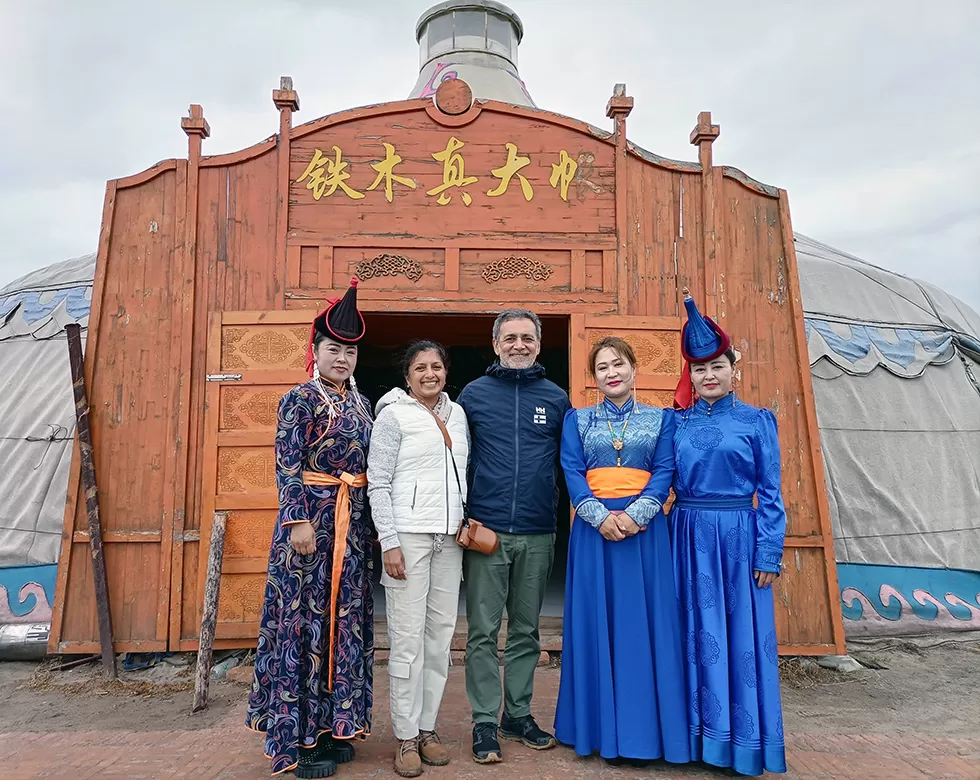
Best Inner Mongolia travel itineraries, how to plan a best trip

- 01. Step 1: Where to go in China
- 02. Step 2: When to go in China
- 03. Step 3: How to Visit Tibet in 2021 — Suggestions and
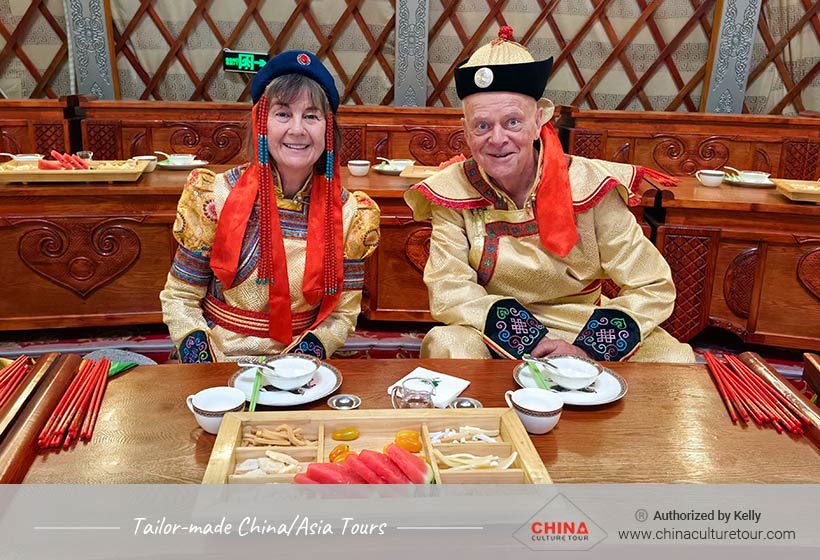
Our carefully curated Inner Mongolia travel itineraries , ranging from 2 to 9 days, are the result of our team's extensive experience in the region. These itineraries encompass a wide range of attractions, including the highlights of Hohhot, the boundless grasslands , immersive nomadic experiences , invigorating mountain hikes, expansive deserts, pristine forests, and captivating wetland parks. Moreover, they provide a glimpse into the fascinating ethnic cultures of the Mongols, Ewenkis, and Russians.
Whether you are a short-time traveler, a family on vacation, a senior explorer, a nature enthusiast, or a passionate photographer, our flexible itineraries cater to your specific interests. Should you desire a customized Inner Mongolia travel experience, feel free to contact us , and we will be delighted to assist you.
2 Days Hohhot Highlights Tour
- Day 1 : The Inner Mongolia Museum, 5 hours’ hiking on Daqing Mountain.
- Day 2 : Day tour to Xilamuren Grassland with horse riding and Mongolian life experience.
2 Days Xilamuren Grassland Tour
- Day 1 : Xilamuren Grassland with horse riding, Mongolian culture performance and banquet dinner. Overnight in a Mongolian yurt.
- Day 2 : Nomadic life experience, including making Mongolian lambs and milk tea, feeding lambs, and collecting cow dung. Back to Hohhot.
3 Days Hohhot Daqing Mountain Hiking and Xilamuren Grassland Tour
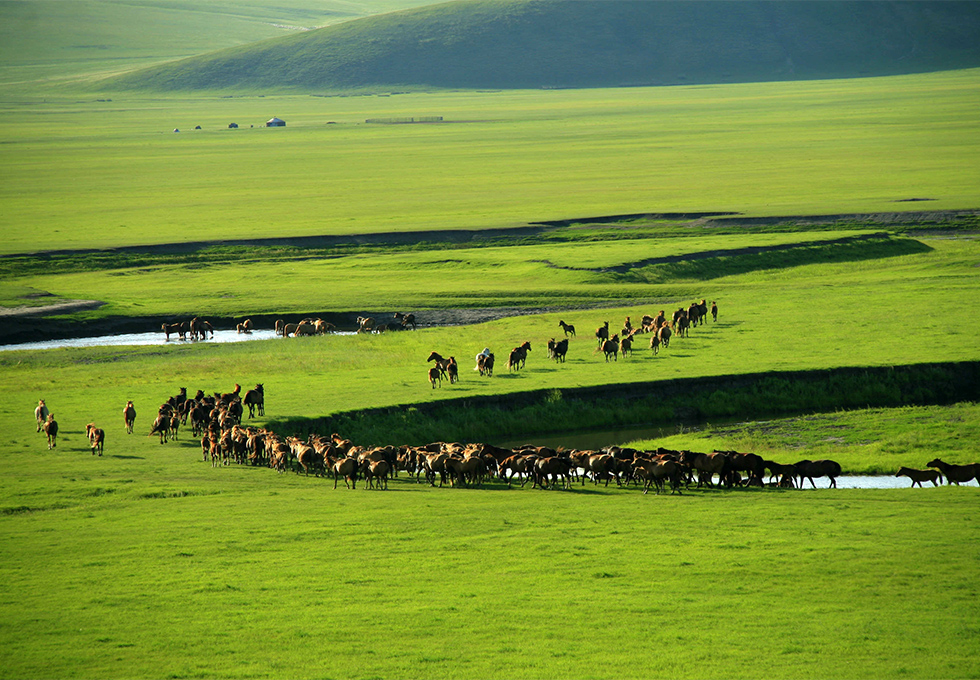
- Day 2 : Hohhot/Xilamuren: Xilamuren Grassland with horse riding, Mongolian culture performance and banquet dinner. Overnight in a Mongolian yurt.
- Day 3 : Xilamuren/Hohhot: Nomadic life experience, including making Mongolian lambs and milk tea, feeding lambs, and collecting cow dung.
3 Days Hohhot Daqing Mountain Hiking and Huitengxile Grassland Tour
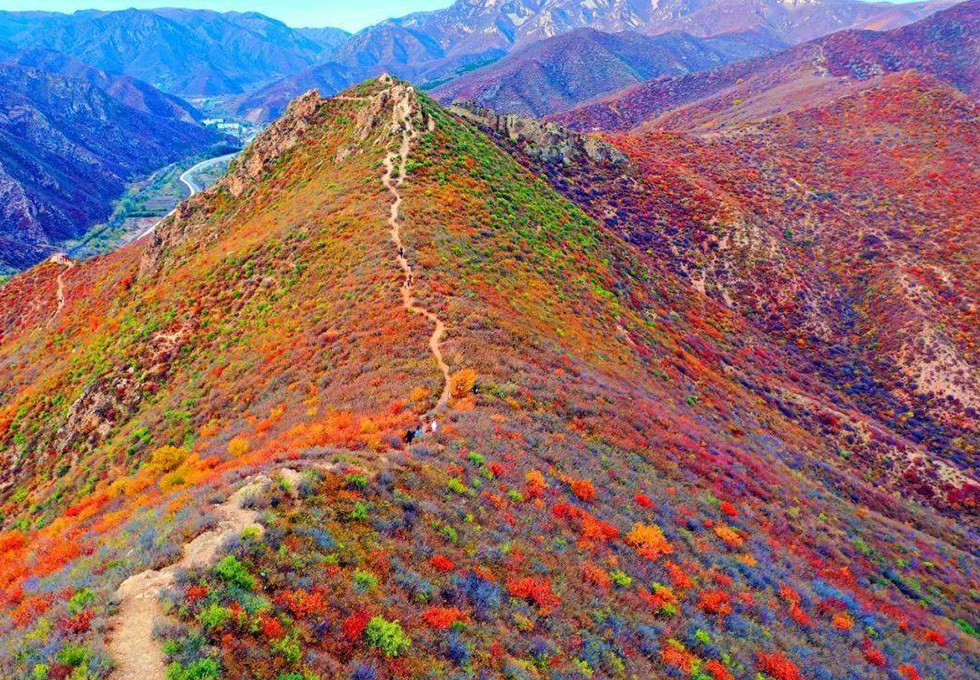
- Day 1: Arrival at Hohhot. The Inner Mongolia Museum
- Day 2: Hohhot/Huitengxile: Huanghuagou Grassland hiking and horse riding, Watch Mongolian singing and dancing, Mongolian archery and wrestling. Overnight in a Mongolian yurt.
- Day 3: Huitengxile/Hohhot: 5 hours’ hiking on Daqing Mountain.
3 Days Badain Jaran Desert Essence Tour in West Inner Mongolia
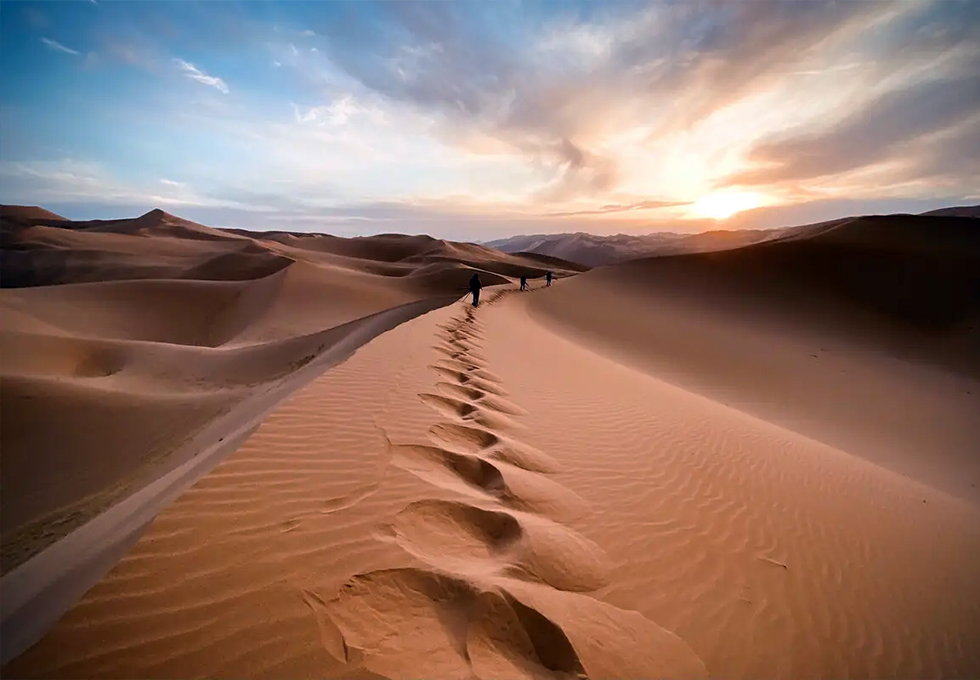
- Day 1 : Zhangye/Badain Jaran (3 hours): Arrival at Badain Jaran
- Day 2 : Badain Jaran Desert Jeep Safari and Camel Riding
- Day 3 : Badain Lake, Departure.
4 Days Inner Mongolian Grassland and Desert Tour
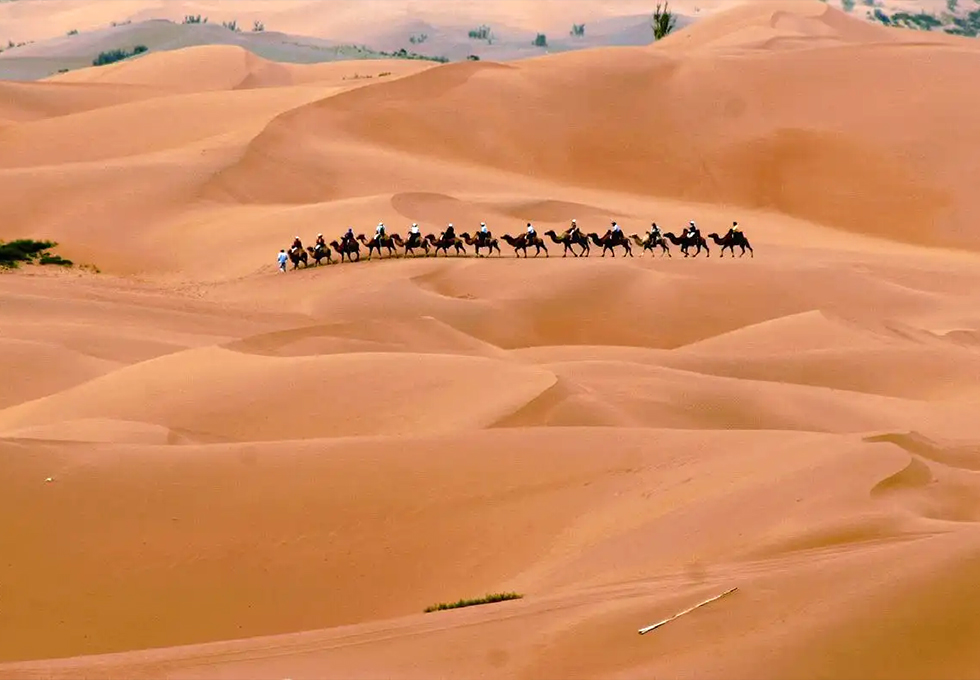
Hohhot - Xilamuren Grassland - Kubuqi Desert
- Day 1 : Arrival at Hohhot. The Inner Mongolia Museum
- Day 2 : Hohhot/Xilamuren: Grassland horse riding, Mongolian culture performance and banquet dinner. Overnight in a Mongolian yurt.
- Day 3 : Xilamuren/Kubuqi Desert: Nomadic life experience, including making Mongolian lambs and milk tea, feeding lambs, and collecting cow dung. Drive 4.5 hours to Kubuqi Desert.
- Day 4 : Kubuqi Desert/Baotou: Kubuqi Desert Exploration, including hiking, karting and camel riding. Drive to Baotou to end the tour.
You May be Interested in the Following Inner Mongolia Tours:
- 4 Days Inner Mongolia travel itineraries for your reference
- Not interested in the tours? Customize your own Inner Mongolia trip!
4 Days Mongolian Grassland, Mountain Hiking and Desert Tour
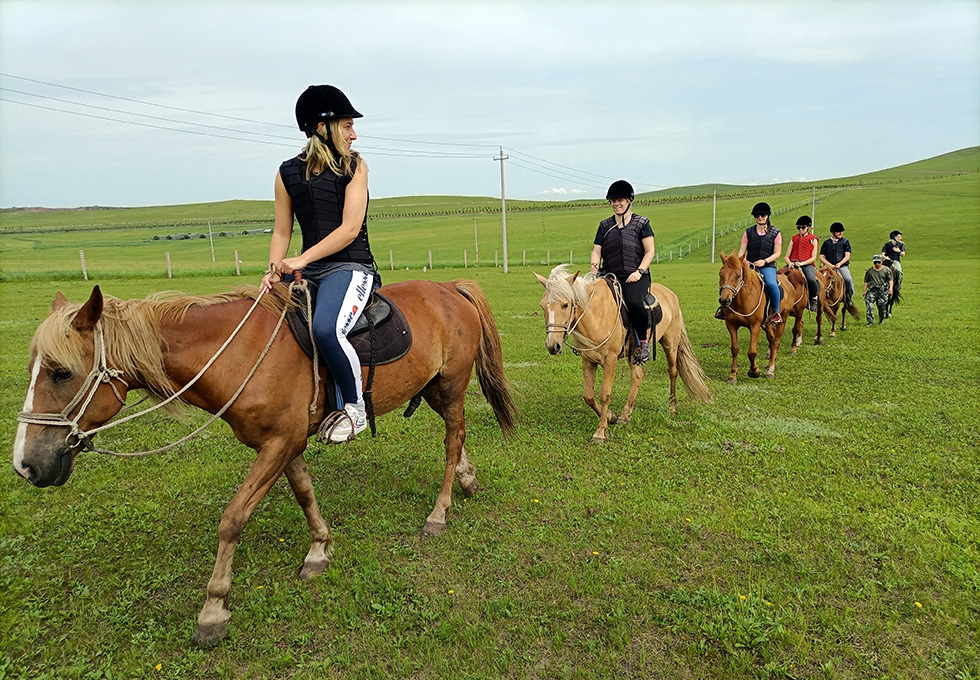
Hohhot - Huitengxile Grassland - Baotou
- Day 2 : Hohhot/Huitengxile: Huanghuagou Grassland hiking and horse riding, Watch Mongolian singing and dancing, Mongolian archery and wrestling. Overnight in a Mongolian yurt.
- Day 3 : Huitengxile/Hohhot: 5 hours’ hiking on Daqing Mountain.
- Day 4 : Hohhot/Baotou: Day tour to Resonant Sand Bay of Baotou
5 Days Mongolian Grassland, Mountain Hiking and Desert Camping Tour
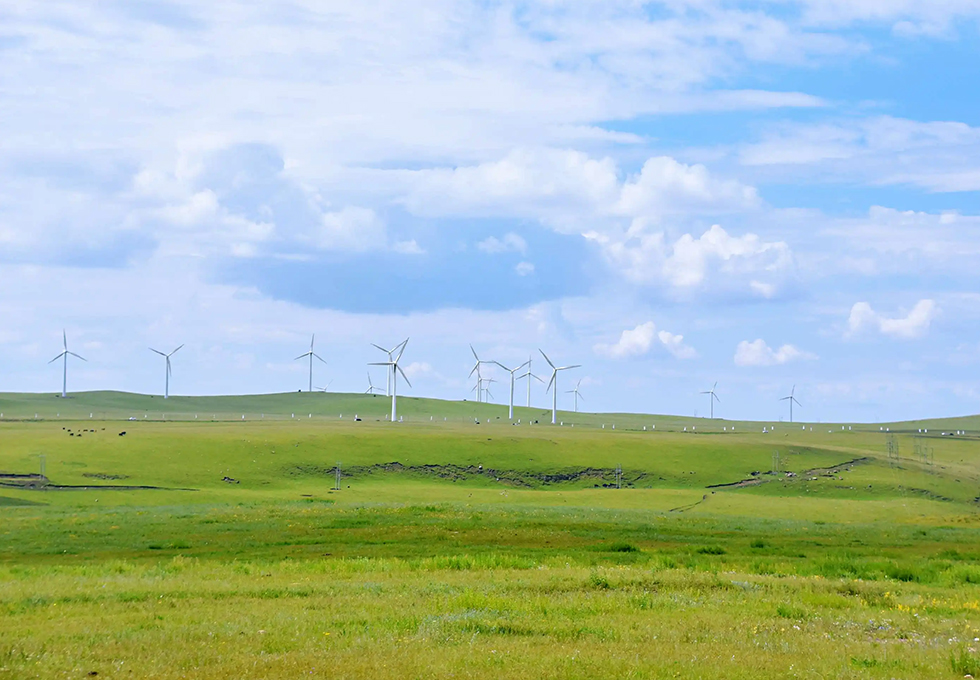
Hohhot - Huitengxile Grassland - Kubuqi Desert
- Day 2 : Hohhot/Huitengxile: Huanghuagou Grassland hiking and horse riding, Mongolian archery and wrestling. Overnight in a Mongolian yurt.
- Day 3 : Huitengxile/Hohhot: 5 hours’ hiking tour on Daqing Mountain
- Day 4 : Hohhot/Kubuqi Desert: Desert Hiking, Camel Riding, Go Karting, Sand Sliding, Desert Sunset Barbecue Dinner and Overnight Camping
- Day 5 : Kubuqi Desert to Baotou/Erdos/Hohhot to end the tour.
- 5 Days Inner Monglia Tour: Follow Genghis Khan's Steps
- 5 Days Inner Mongolia travel itineraries for your reference
5 Days Hulunbuir Grassland, Wetland and Minority Culture Tour
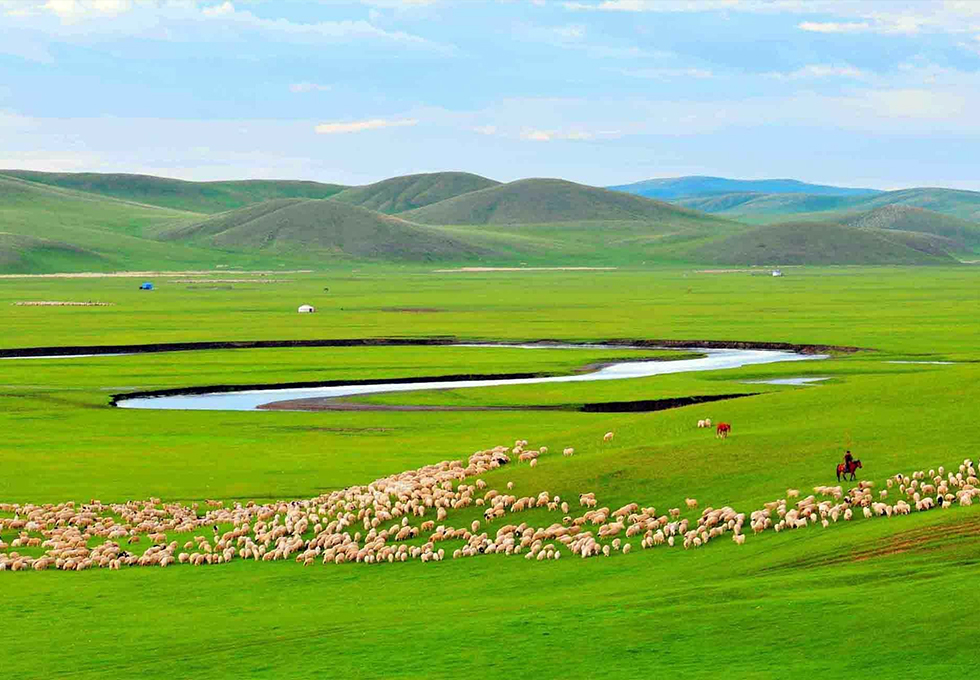
Hohhot - Ergun - Enhe - Heishantou
- Day 1 : Arrive at Hailar
- Day 2 : Hailar/Ergun: Hulunbuir Grassland, Mergel Gol River, Ergun Wetland
- Day 3 : Erguna/Shiwei: White Birch Forest with the Ewenkis’ performance, Enhe Russian family visit
- Day 4 : Shiwei/Heishantou: Boundary River, Heishantou grassland with horse riding and Mongolian culture experience
- Day 5 : Heishantou/Hailar: Drive back to Hailar, Flight Departure

6 Days Mongolian Grassland, Mountain Hiking and Desert Camping Tour
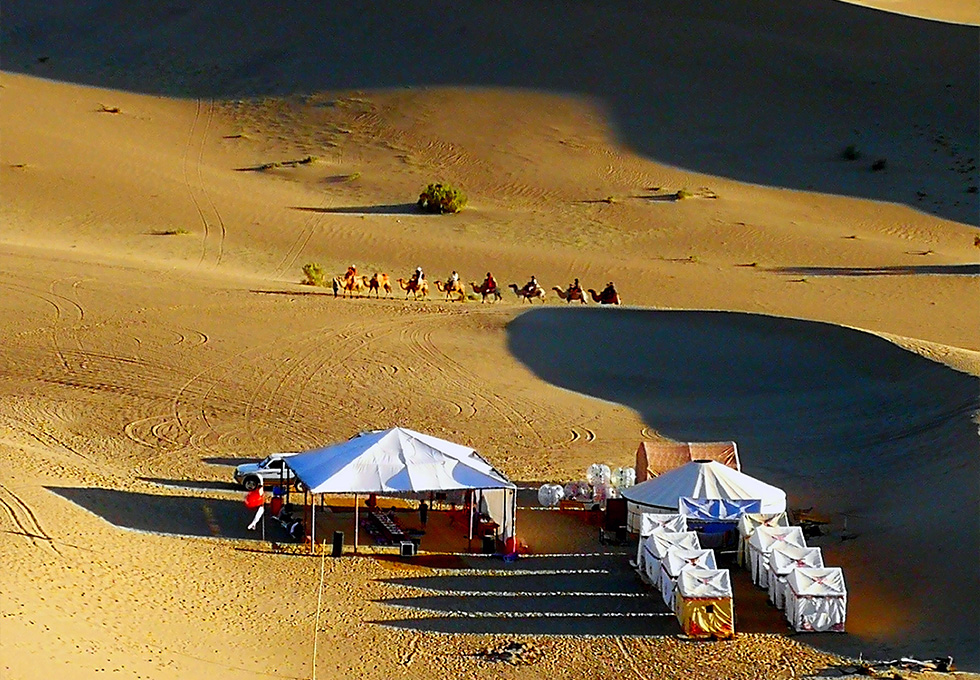
Hohhot - Huitengxile Grassland - Kubuqi Desert - Erdos
- Day 3 : Huitengxile/Hohhot: 5 hours’ hiking on Daqing Mountain
- Day 4 : Hohhot/Kubuqi Desert: Desert Hiking, Riding Camel, Go Karting, Sand Sliding, Desert Sunset Barbecue Dinner and Overnight Camping
- Day 5 : Kubuqi Desert/Erdos: Genghis Khan's Mausoleum
- Day 6 : End the tour in Erdos or drive back to Hohhot.
More 6 Days Inner Mongolia Travel Itineraries:
- 6 Days Inner Mongolia Travel Itineraries
6 Days Hulunbuir Grassland, Wetland and Minority Culture Tour
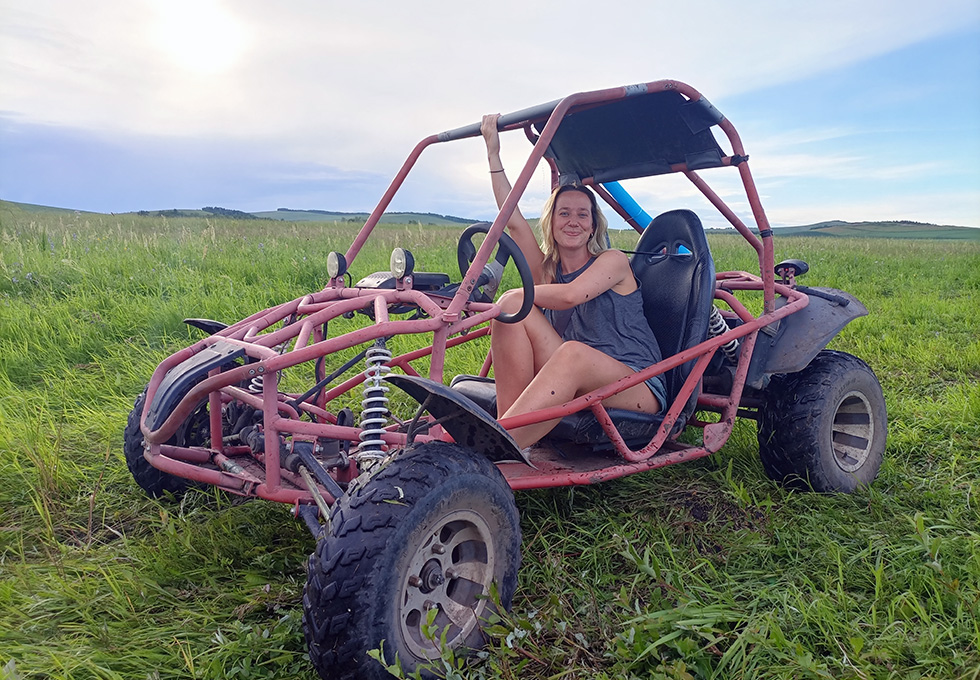
Hohhot - Ergun - Enhe - Heishantou - Manzhouli
- Day 5 : Heishantou/Manzhouli: Sino-Russian border road, Matryoshka Doll Square
- Day 6 : Manzhouli/Hailar: Drive back to Hailar for the flight Departure
- 6 Days Inner Monglia Tour - Inner Mongolia Highlights
- 6 Days Naadam Festival Tour - Festive revelry with Mongolians
- 6 Day Grassland and Desert Tour in the Middle Inner Mongolia
- 7 Days Hulunbuir Immersion Tour in Northeast Inner Mongolia
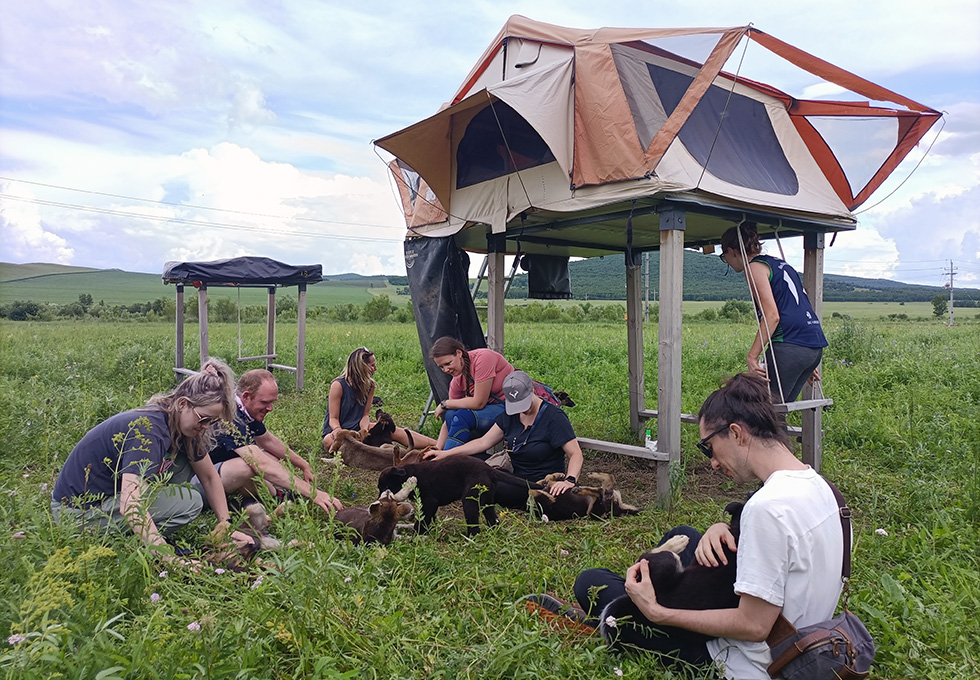
- Day 3 : Ergun: Shangkuli Sahuan Pasture One Day Tour
- Day 4 : Erguna/Shiwei: White Birch Forest with the Ewenkis’ performance, Enhe Russian family visit
- Day 5 : Shiwei/Heishantou: Boundary River, Heishantou grassland with horse riding and Mongolian culture experience
- Day 6 : Heishantou/Manzhouli: Sino-Russian border road, Matryoshka Doll Square
- Day 7 : Manzhouli/Hailar: Hulun Lake, Drive back to Hailar to end the tour.
- 7 Days Inner Mongolia travel itineraries for your reference
8 Days Hulunbuir Immersion Tour in Northeast Inner Mongolia
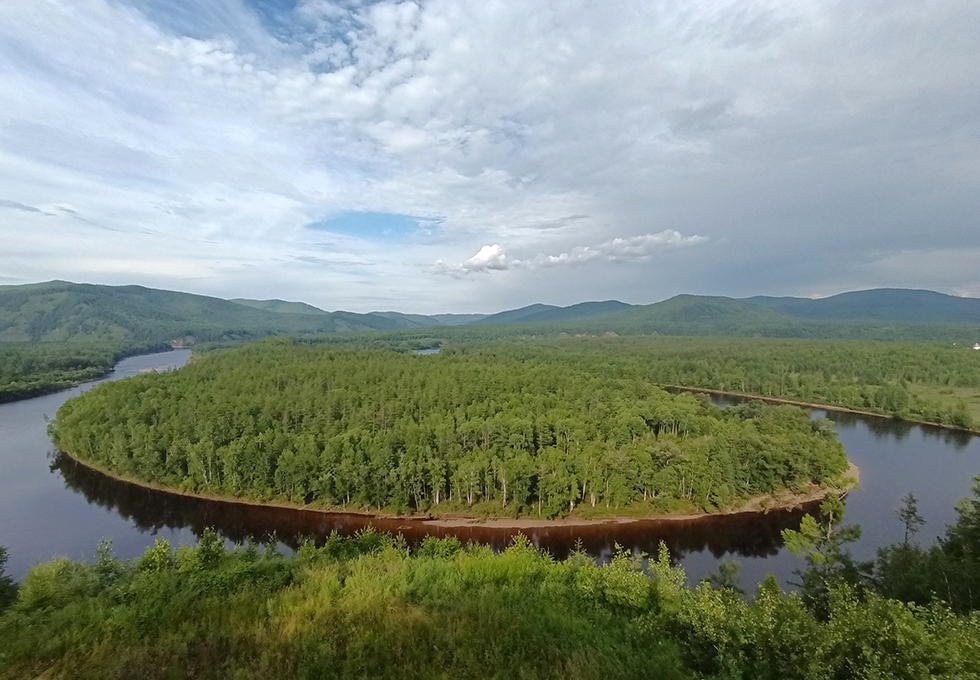
Hohhot - Ergun - Genhe - Heishantou - Manzhouli
- Day 3 : Ergun/Genhe: Shangkuli Sahuan Pasture one day tour
- Day 4 : Genhe/Shiwei: Aoluguya Evenki Reindeer Herding Tribe, White Birch Forest
- Day 5 : Shiwei: Enhe Russian family visit, Boundary River
- Day 6 : Shiwei/Heishantou: Heishantou grassland with horse riding and Mongolian culture experience
- Day 7 : Heishantou/Manzhouli: Sino-Russian border road, Matryoshka Doll Square
- Day 8 : Manzhouli/Hailar: Hulun Lake, drive back to Hailar to end the tour.
9 Days Inner Mongolia Highlights Tour
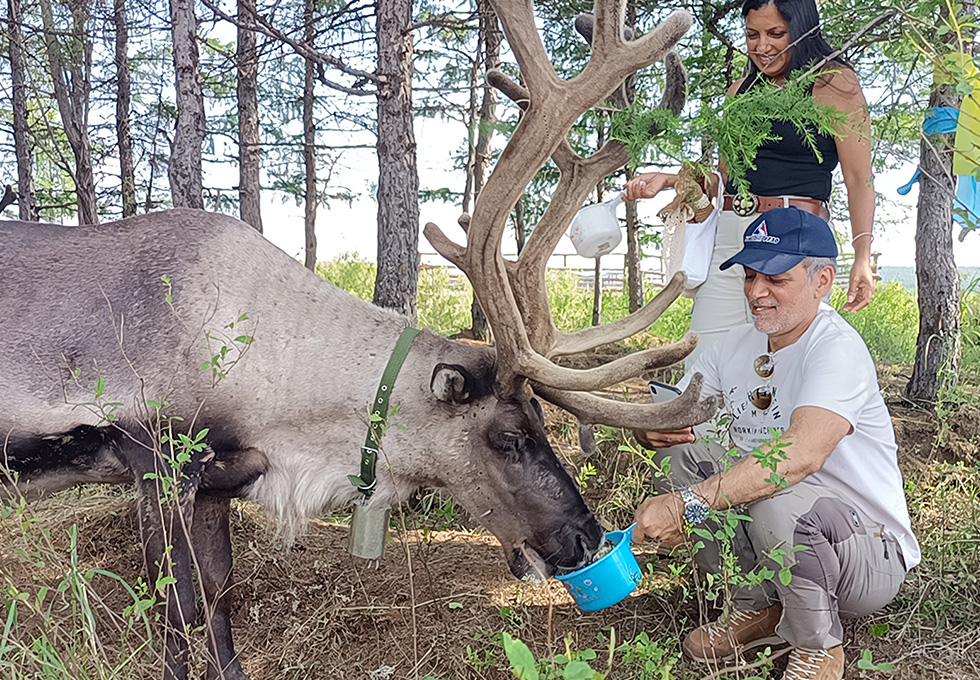
Hulunbuir Grassland - Hohhot - Kubuqi Desert - Erdos
- Day 1 : Arrive in Hailar
- Day 2 - Day 5: Hulunbuir highlights, including Hulunbuir Prairie, Erguna Wetland Park, Shangkuli Sahuan Pasture, White Birch Forest, Enhe Russian culture experience, and Heishantou Grassland.
- Day 6 : fly from Hailar to Hohhot, 5 hours’ hiking on Daqing Mountain
- Day 7 : Hohhot to Baotou: Kubuqi Desert Exploration, including Desert Hiking, Camel Riding, Go Karting, Sand Sliding, Sunset Shoot, Desert barbecue dinner and Overnight Camping
- Day 8 : Kubuqi Desert to Erdos:Mausoleum of Genghis Khan and Erdos Kangbashi city tourism area
- Day 9 : Depart from Erdos
Informative articles that will enhance your Inner Mongolia travel experience
- Inner Mongolia travel itineraries for your reference
- Customizable private Inner Mongolia tours
- Interesting cultural Activities and outdoor adventures to rich your trip
- Top attractions you can't miss in Inner Mongolia
- When is the best time to travel to Inner Mongolia
- Inner Mongolia Travel Advisory

Hi, I’m Grace Wang, if you like my article, please share it with your friends. Any sugguestions on this article, please contact me . Thanks!
Want to plan a private Inner Mongolia tour? CREATE NOW
CONTENT DIRECTORY
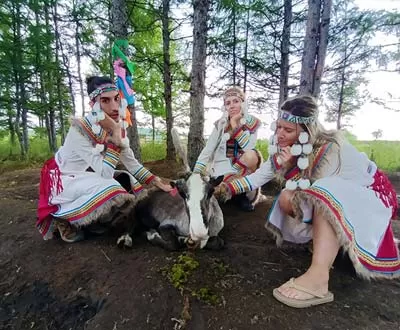
Inner Mongolia Highlights : 6 Days Highlights of Inner Mongolia
CREATE MY TRIP
FABULOUS TOUR COMPANY
CHINA OCTOBER - NOVEMBER 2019 We researched several companies and studied reviews on Trip Adviser before contacting who did a very China Culture Tour with an initial query. Right from the outset Grace who owns the company was excellent. She emailed detailed with pictures information and a suggested… read more details
Karen from US
Ready to Create a Unique Dream Travel?
Create My Vacation
- CHINA CULTURE TOUR: OUR CULTURE, YOUR TOUR!
- Best Tailor-made Classic China Tours
- Cultural Experiences for a China Tour
- WOW Seasonal China Tours
- Our Best Tour Ideas for You

Inner Mongolia Travel Guide: An Ultimate Guide with All Things to Know
A vast and fascinating land with some of the greatest grasslands on Earth, Inner Mongolia stands as a captivating travel destination. This ultimate Inner Mongolia Travel Guide is to help you plan your perfect trip to Inner Mongolia , with all essential information and travel tips covered.
The expansive grasslands are the undoubted stars in the region. The Badain Jaran Desert with some of the world’s tallest dunes and hidden lakes will wow all its travelers. The Mausoleum of Genghis Khan will offer a profound look into Mongolian history. The Russian ethnic towns along the borderlines along with the stunning Ergun River will allow you a visual feast as well as a unique cultural experience…
Though eye-catching, these are not the things that will impress you the most in Inner Mongolia. That will be the many small moments you’ll experience here – receiving a welcome ceremony from locals, riding a horse across the grasslands, witnessing stunning sunrises, trying thrilling desert activities, living like a local nomad, feeding the animals, staying in a yurt, etc.
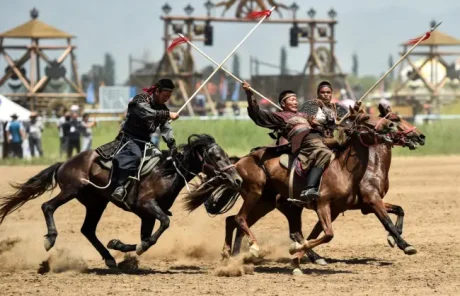
Chinese : 内蒙古 nèi měng gǔ
Location : Northern Border Region of China
Population (urban area) : 24,012,000
Inner Mongolia Fast Facts
- Chinese Name : 内蒙古 (nèi měng gǔ)
- Location : In the northern borderlands of China
- Capital : Hohhot
- Area : About 1.18 million square kilometers
- Population : Near 24 million
- Features : An autonomous ethnic region and the third-largest province in China; has an elongated terrain, spanning over 2400 kilometers east to west; borders multiple provinces in China and neighbors Mongolia and Russia on the north; boasts extensive borderlines of about 4263
- Elevation : Averagely over 1,000 meters above sea level.
- Top Grasslands : Hulunbuir Grassland, Xilamuren Grassland, Huitengxile Grassland, Xilingol Grassland…
- Top Deserts : Badain Jaran Desert, Tengger Desert, Kubuqi Desert…
Top Destinations in Inner Mongolia
Whether you seek immersion in vast expanses of grasslands, traditional ethnic customs, tranquil wetlands, wild deserts, or brilliant cultural and historical attractions, Inner Mongolia will cater to your desires. Below are some of the best travel destinations you can’t miss during your trip to Inner Mongolia, offering the best attractions and experiences of this region.
Popular Tourist Attractions in Inner Mongolia
Top things to do in inner mongolia.
The vast Inner Mongolia has numerous cultural and natural experiences to offer. Here are some highly recommended ones:
Grassland Adventure:
Enjoy memorable grassland adventures on vast Hulunbuir Grassland, Xilingol Grassland, Huitengxile Grassland, etc. Try horseback riding, stay in a traditional Mongolian yurt, take part in the Nadam Festivals to watch traditional sports like horse racing, wrestling, and archery, or challenge the thrilling grassland sliding in certain areas… There is never a shortage of adventures when on an Inner Mongolia tour.
Desert Exploration:
A desert exploration in the Tengger Desert, Kubuqi Desert, or Badain Jaran Desert will reward you with a lifetime adventure. Desert off-roading, camel riding, sandboarding, desert camping, desert hiking, stargazing… all thrilling and exciting desert adventurous activities can be expected here.
Experience Authentic Mongolian Ethnic Culture:
If you want to experience the real authentic Mongolian-style life and culture, the best way is to visit a local village and live in a Mongolian yurt on the grassland with a nomadic family. Then, you’ll have great chances to participate in many of their works and activities. You can learn to construct a traditional Mongolian yurt, feed the animals, milk cows, and make dairy products. Or, enjoy your time by taking part in the campfire party on the grassland and watching traditional Mongolian performances.
Explore Ergun Wetland and Forests in the Greater Khingan Range:
Being hailed as the “Number One Wetland in Asia”, the Ergun Wetland is a typical woody wetland where winding rivers, dense vegetation, shrubs, grass meadows coexist. This ecological tableau makes it a paradise for migratory birds. Visitors can follow a professional guide to hike through the wetland and observe the beautiful creatures in the area up close.
The primeval forests in the Greater Khingan Range are the birthplace of many hunting tribes. A hiking here will allow you a deep exploration of various precious tree species and diverse wildlife.
Encounter the Ultimate Autumn Beauty at Populus Euphratica Forest
In each autumn, the Populus Euphratica Forest in Ejina Banner will turn into a golden ocean, making it a paradise for photography and nature enthusiasts.
Visit Historical and Cultural Sites
Scattered around the vast Inner Mongolia are many historical and cultural sites, offering in-depth insights into the glorious history of the Mongol Empire and the heroic legends of the grassland tribes. Some of the top historical attractions in Inner Mongolia include Dazhao Temple, Wudangzhao Monastery, Zhaojun Tomb, the Mausoleum of Genghis Khan, etc.
Top Inner Mongolia tours including classic experiences:
- 5 Days Inner Mongolia Tour
- 5 Days Classic Inner Mongolia Tour with Leisure Hike
- 8 Days Inner Mongolia Cultural Tour with Hiking & Camping
How Many Days to Plan for an Inner Mongolia Tour
2-3 days – explore hohhot & nearby grasslands.
For people with limited time, they can join in a short 2-3 days Inner Mongolia Tour to Hohhot, visit top cultural and historical attractions before heading to a nearby grassland or desert for adventure.
Recommended 2-3 Days Inner Mongolia Tours:
- 3 Days Inner Mongolia Grassland and Desert Tour
4-6 Days – Explore Hohhot, Baotou, and Other Central Destinations
4-6 days will allow you a deeper exploration of the natural and cultural highlights of central parts. Hohho and Baotou has multiple historical attractions for you to gain insights into the deep history of Inner Mongolia. Besides the cultural exploration, you can also seek adventure in the surrounding grasslands or the Kubuqi Desert.
Recommended Inner Mongolia Tours to Central Areas:
- 4 Days Huitengxile Grassland & Kubuqi Desert Tour
4-6 Days – Explore Eastern Parts Like Hulunbuir, Ergun, Manzhouli
In the eastern part, you can expect the most authentic grassland natural and cultural experiences in Hulunbuir, stunning wetland scenery and biodiversity in Ergun, and Russian-style towns and international landmarks in the border areas of Manzhouli.
Recommended Inner Mongolia Tours to Eastern Parts:
- 5 Days Inner Mongolia Hulunbuir Grassland Tour
- 9 Days Hulunbuir Grassland Tour with Reindeer Experience
4-7 Days – Enjoy Desert Adventure in the Western Area
An adventure to the western part of Inner Mongolia will focus on the wild deserts, like the Tengger Desert or the Badain Jaran Desert. The duration can vary based on your specific destinations and preferred activities.
Recommended Inner Mongolia Desert Adventures:
- 4 Days Ejina Populus Euphratica Forest Tour
- 3 Days Badain Jaran Desert Tour: Yurt Camp & Jeep Safari
10+ Days for a Balanced Experience
The long-term itinerary will allow you a comprehensive experience covering grasslands, deserts, local life, and cultural and historical sites. You can enjoy a leisurely trip to explore the best natural landscapes and cultural richness of Inner Mongolia. If you like, feel free to contact our travel consultants to customize your private Inner Mongolia tours based on your preferences and schedule.
Accommodations in Inner Mongolia
On an Inner Mongolia travel, visitors can expect a variety of accommodation options, from unique Mongolian yurts and Russia-style wooden houses to luxury and international brand hotels. Below are some of the most recommended types:
- Mongolian yurt on grasslands : A common option in the grassland area; with different yurt types available, from luxurious to basics; most yurts with no private bathroom, but public bathrooms are available.
- Russian-style wooden houses : Mostly available in China-Russia border areas like Manzhouli and Ergun; features unique architectural style and decoration, and exotic atmosphere.
- Luxury hotels with standard facilities : Easily to find in urban areas of major cities like Hohhot and Baotou; both international brands and local high-end hotels are available.
- Others : Homestays are common when visiting small villages or towns; clean and economical budget hotels are easy to find in both city areas and small towns; specialty accommodations are available in certain tourist attractions, like the Lotus Hotel in Xiangshawan.
Inner Mongolia Weather and Best Time to Visit
The best time to visit Inner Mongolia is between June and September when temperatures are pleasantly warm across the land. This makes exploring the lush grasslands, vibrant deserts, dense forests, and historical sites in the city areas more enjoyable and comfortable.
September to October is also a good time to travel to Inner Mongolia if you plan to encounter golden poplar forests in Arxan or the Greater Khingan Range. And the daytime during this period is still cool and pleasant.
Though April to June may see large temperature fluctuations between day and night, it is a great time to witness the revival of grasslands and see the grasslands being dotted with blooming flowers.
Generally, Inner Mongolia experiences distinct seasons, featuring long, harsh winters and short, warm summers. Spring is when strong winds frequently occur, and autumn is the transitional season when temperatures can drop rapidly. Sunshine is abundant throughout the year. Due to its geographical location and terrain, the precipitation is overall low, and most rainfall occurs in the summer months. Other seasons are relatively dry.
Inner Mongolia Transportation: How to Get to and Travel Around
How to get to.
Flying is the most recommended option for long-distance travelers to Inner Mongolia. Hohhot Baita International Airport is the most important gateway to Inner Mongolia, offering flights connecting various domestic cities like Beijing, Shanghai, Guangzhou, Shenzhen, Xian, Chengdu, Chongqing, Urumqi, and major cities in Inner Mongolia. It also offers several international flights to/from Russia and Mongolia.
There are also Baotou Erliban Airport, Ordos Ejin Horo International Airport, Chifeng Yulong Airport, Manzhouli Xijiao International Airport, etc. serving other different cities and areas in Inner Mongolia. If you are planning to visit these places, check if direct flights to these cities are available to save time.
Hohhot East Station and Hohhot Railway Station are the two major train stations in Inner Mongolia, offering both high-speed trains and regular trains to major domestic cities like Beijing, Xian, Chengdu, Lanzhou, etc. The train ride is usually cost-effective and can reward you with stunning natural landscapes along the way.
Besides, Baotou, Manzhouli, Chifeng, etc. also have train stations to ensure visitors’ convenient arrival by train.
How to Travel Around
Inner-provincial flights connecting major tourist destinations in Inner Mongolia are available for tourists’ convenient transfer.
High-speed trains are available to connect Hohhot, Baotou, and Wulanchabu.
When traveling in the central areas or in the remote east areas, private land transfer is highly recommended for more flexibility.
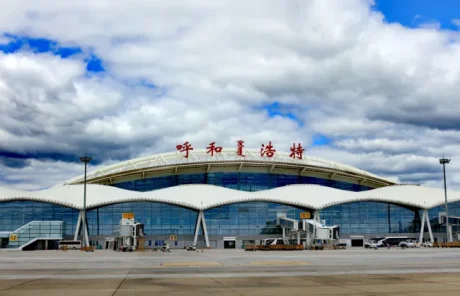
Destinations
Popular tours, travel blog.
Top 15 Things to Do in China 2024/2025 11/10/2022 07:53
Chinese Zodiac: Everything You Need to Know 04/14/2022 09:29
Why Visit Dunhuang and Top Things to Do in Dunhuang 03/29/2022 09:33
We are member of:
Email: [email protected] [email protected] WeChat/Whatsapp: 86-15129005119 Call: (+86)18792910029 (08:00-21:00 Beijing Time)
2002-2022 © All Rights Reserved.
Username or email *
Send us a quick inquiry
* Tell us your travel requirements/questions here.
I prefer to be contacted via:
Email WeChat WhatsApp Phone call
Your travel consultant will reply within 24 hours.

A TripAdvisor award-winning China travel agency organizing diverse private and mini-group China tours. We offer in-depth experience, free cancellation, flexible & safe trips.
[email protected] [email protected]
WeChat/Whatsapp
86-15129005119
(+86)18792910029 (08:00-21:00 Beijing Time)
Travel to Inner Mongolia: The Complete Guide
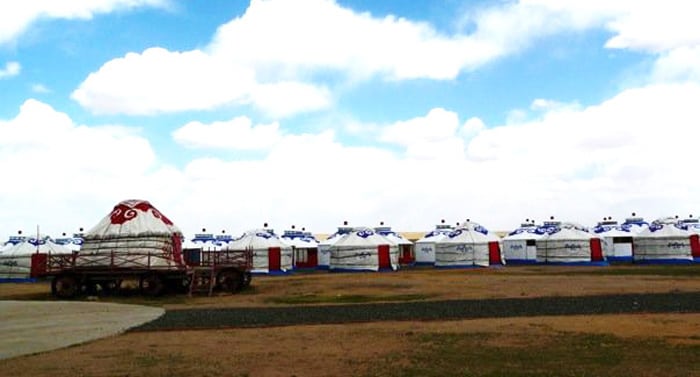
In this guide to travel in Inner Mongolia you will find:
- How to decide whether to use a travel agency or make your own way;
- A guide to Inner Mongolia’s top sites and attractions;
- A breakdown of costs in Inner Mongolia including travel, accommodation and activities;
- Advice on the best time to visit Inner Mongolia and some useful packing suggestions;
- Travel tips to make the best out of your trip to this beautiful part of China: local customs, food, and shopping.
As Inner Mongolia is very big, this guide aims to introduce you to some of the region’s key sights and attractions to help you best plan your trip. If you would like more details about a particular place, please comment below.
For more general information about traveling in China such as visas, vaccinations, flights, food etc. be sure to check out this epic 4,000 word complete guide to traveling in China . Just skip to the sections you are most interested in!
Before you book your trip: agency vs. your own way
The first time I traveled to Inner Mongolia I booked myself onto an organized agency tour . My reasoning behind it was this:
- I had very little time to organize my trip;
- I only had a week off and wanted to see as much of Inner Mongolia as possible;
- I had not been in China very long and was not confident in my ability to get by on my own or to communicate in Mandarin;
- I was traveling alone and wanted to meet other people;
- The agency sorted out everything including my travel from Beijing: easy life!
Although I fell in love with Inner Mongolia on that trip, my experience with this agency was very mixed. Here are the pros and cons that I experienced with a Beijing-based agency organizing Inner Mongolia tours:
- Everything was organized for me which meant very little planning aside from what to pack;
- I was able to discover some of Inner Mongolia’s culture and history through our very knowledgeable guide;
- I made some really awesome friends on the tour.
- It was a much more expensive option than organizing everything myself;
- We were always taken to the most touristy sites at the most touristy times which made it difficult to experience authentic Inner Mongolia;
- A lot of the tour (as can often happen in China) was based around getting us to buy stuff or paying extra for activities. For example, a lot of Inner Mongolia tours will claim that horse-riding is included in the package but will in fact make you pay more for this when you get there;
- Lack of flexibility to do any of my own exploring;
- My biggest issue with the tour was how much time we had to spend in transport vs. how much time we actually got to see stuff.
If you have limited time to travel to Inner Mongolia and limited time to organize your trip, booking through a tour agency may be a good choice. However, I recommend not booking a tour that is too ambitious with its itinerary or you will spend your entire trip on a bus… Inner Mongolia is a huge region!
I also recommend booking a local tour from Hohhot rather than booking one with a large tour operator from Beijing or Shanghai like I did. The reasons for this are:
- You will get better value for your money;
- Tours will be smaller and more flexible. You can also book several short tours instead of one long one to experience more of the diversity Inner Mongolia has to offer;
- You are guaranteed guides with strong local knowledge;
- You are supporting the local economy.
Some of the best tours I’ve experienced and heard great feedback about are those organized by Anda’s guesthouse. This family-run hostel offers a good variety of tours at one of the most cost effective prices in Hohhot. The staff and guides are very friendly and are also always happy to help you with your own travel plans.
Making Your Own Way
The second time I visited Inner Mongolia, I was determined to go beyond the beaten path and make my own way through the region as much as possible. I was not disappointed! I got to discover the Inner Mongolia of my imagination with lush rolling grasslands and sunsets over the desert.
That being said, I was fortunate enough to be able to travel this way because:
- I had plenty of time to spare and was flexible about how long I could stay in the region;
- I had a good travel companion;
- By this point, I could speak enough Mandarin to get by.
If you are in a situation similar to the one above, I definitely recommend making your own way as much as possible. Inner Mongolians are very helpful and you should easily be able to convince a taxi driver to help you organize a homestay in a yurt or negotiate the bus system to get to the more remote parts of the region.
Go north and go west! These parts of the region are more remote but boast some of the most beautiful scenic spots in China. Be warned that some areas of the far West region of Inner Mongolia require travel permits, meaning that using a local tour company to obtain these is inevitable.
If you don’t speak Mandarin but still want to escape the tourist track do not despair! Friendly hostels in cities like Hohhot can help you plan and organize expeditions to more remote areas. You can also ask them to write down any Mandarin characters (for example asking for a bus ticket to a place) you might need on your travels.
Where to go in Inner Mongolia
When it comes to cities in Inner Mongolia, perhaps this article says it best, describing the regions largest cities Hohhot – which by the way is the capital of the Province – and Baotou as having that ‘on-the-brink-of-something-big’ feel. That is to say they are not particularly beautiful cities but they have a certain excitement and charm, and business is booming!
Although Inner Mongolia’s main charm comes from its natural scenery, the cities also hold some attractions well worth a visit.
Here are my top recommendations for things to do in Hohhot and Baotou:
- Dazhao temple : This colourful temple is Hohhot’s oldest temple built in the 16th century. It contains a 2.5m silver Sakyamuni Buddha statue and is worth the visit for those interested in sampling one of China’s more impressive temples.
- Five-Pagoda Temple : This temple is renowned in China for being the only Indian style Chinese temple. It holds an amazing 1,500 frescoes of Buddha and is covered in Mongolian and Tibetan script.
- Inner Mongolia Museum : I am admittedly not a museum person, so I was surprised to find myself enjoying the eclectic collection of dinosaur fossils, ancient nomadic artifacts, exhibits showcasing local fauna and flora and even a section dedicated to Chinese space exploration!
- Walk around in the Old Town : Hohhot is a great place to simply wander around. A portion of Tongdao Road, also referred to as ‘Islam style street’ on TripAdvisor, boasts beautiful Muslim architecture and some really tasty Halal restaurants.
Admittedly, there is not much to do within Baotou itself. However, the city is a good base to visit the following destinations:
- Genghis Kahn Mausoleum : The world famous Mongolian hero’s mausoleum is close to the city of Ordos , 115 km from Baotou. History buffs love the mausoleum whilst others argue it is not worth the long trip. The mausoleum can be reached by bus from Baotou.
- Wudangzhao Monastery : One of the most impressive Tibetan Buddhist lamaseries outside of Tibet, this destination is fairly off the beaten track. Monks are very friendly but not many of them speak English. The monastery is approximately 70 km Northeast of Baotou.
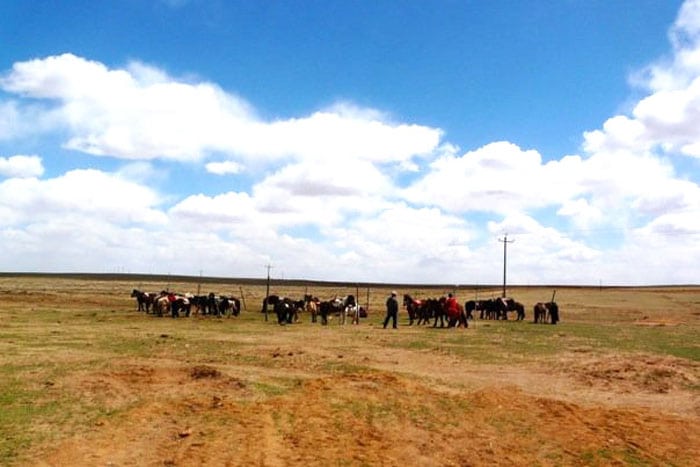
Near Hohhot
There are three grasslands close enough to Hohhot for short trips:
- Xilamuren grasslands : Closest to Hohhot (90 Km) and the first grasslands to be developed as a tourist attraction, these tend to be overcrowded and packed with tourist buses in peak seasons. More worryingly, over-grazing and tourism in recent years have affected the grass leaving it sparse and browning in certain areas. Although these grasslands are host to a number of activities such as horseriding, I would recommend avoiding them if you have other options.
- Gegentala grasslands : These grasslands are roughly a two and a half hour drive from Hohhot. Although they are not yet showing signs of desertification like Xilamuren, they remain equally as tourist-oriented. Gengentala is home to rows and rows of yurts serving as accommodation. They do have the plus side of being equipped with modern comforts such as toilets and as they cater to the Chinese tourist you will even find a nightclub or two! That being said, Gegentala is a good option for those who cannot travel too far outside of Hohhot and offers a range of activities from horseriding to wrestling to traditional mutton banquets held in yurts.
- Huitengxile grasslands : If you have a bit more time, these grasslands lay a three and a half hour drive from Hohhot. There you will find a very similar set up as Gegentala in terms of accommodation and activities, but less busy. Be warned however that some travelers complain the grass here is not as lush and green as they had hoped.
Further away: Hulunbuir grasslands
If you want to visit one of the most beautiful grasslands in China, this is the place. This is where you experience luxuriant green plains, crystal blue lakes, roaming horses and all those things you imagine Mongolia to be.
Found in Northeastern Inner Mongolia, Hulunbuir is over 2,000 km from Hohhot so more of a mission to access. The closest airport is Hailaer, only 7 km from Hulunbuir. A flight from Hohhot takes just over two hours. The closest train station is also Hailaer station. You can get a sleeper train from Hohhot for a tenth of the price of a flight but it will take you 40 hours. It is actually faster to get a train from Beijing (30 hours) so you may consider doing this if you want to visit this area specifically.
In Hulunbuir, you will find similar tourist activities as in the other grasslands but will also have opportunities to discover the environment in a more intimate way. Hire a local driver, get involved in a horse-riding tour that spans over several days or simply go hiking. There is so much to do here! It is quite hard to find information on activities here beyond the organized tours that leave from Beijing so I recommend reading TripAdvisor or Lonely Planet forums for other traveler tips or simply waiting till you get there to plan your time there.
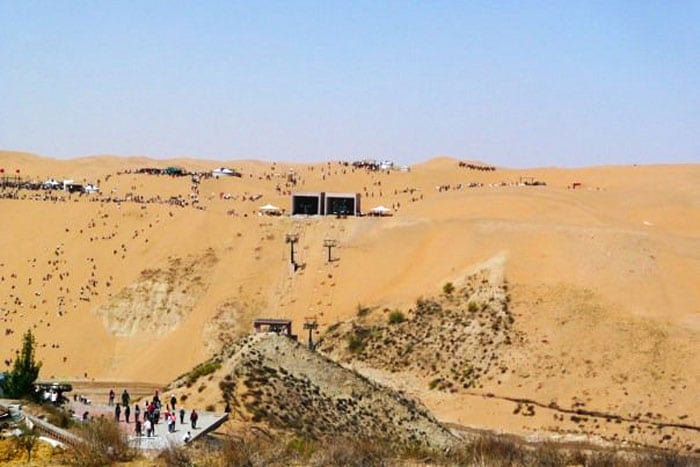
Near Baotou: Resonant Sand Gorge (or Singing Sand Ravine)
The Resonant Sand Gorge, known in Chinese as Xiang Sha Wan is an area of the Kubuqi Desert about one hour’s drive from Baotou. It gets its name from the reported ‘singing sands’ that can be heard there, making a noise some describe as similar to that of an airplane. However, travelers remain divided on whether such a noise can actually be heard there. Personally, I heard nothing.
The Resonant Sand Gorge has become increasingly popular in recent years and has been developed to cater specifically to tourists. Think camel rides, dune buggies, sand sleds and a plethora of other sand-based activities.
Despite the undeniably touristy aspect of this experience, the scenery is admittedly still breathtaking and the rides are actually good fun. For someone who had never experienced a desert (such as myself), this is still a great experience.
A few recommendations:
- Pay more and get the chairlift: this is about an extra 40 Yuan but it is worth avoiding having to climb sand dunes in boiling hot sand. The view is much nicer from the top anyway;
- Get the shoe covers: these are an extra 10 Yuan but will ensure you don’t burn your feet of find sand in your shoes for days;
- Try the sand sled: it is one of the cheaper activities and sledding down the sand dunes is more exhilarating than any roller coaster!
- The camel riding is one of the more expensive activities (around 180 Yuan for one hour) but will enable you to see more of the desert.
- Before paying for an activity, find out how much time it lasts. Some are very expensive and only last 5 minutes!
Further away: Tengger desert and Badain Jaran desert
These deserts can be found to the West of Inner Mongolia and are much more difficult to access from Baotou or Hohhot. They almost warrant a trip in themselves, as they are more remote and difficult to organize travel in.
Here are a few key facts about both:
Tengger Desert:
- Fourth largest desert in China;
- Borders with Ningxia Province;
- Visit: Moon lake and Swan Lake;
- Good for: camel-riding;
- Access from: Yingchuan City.
Badain Jaran Desert:
- 3rd largest sand dune on earth;
- Borders with Gansu Province;
- Visit: many lakes and dunes;
- Good for: hiking (especially up the tallest dune);
How much does a trip to Inner Mongolia cost?
Transport to inner mongolia.
Unless traveling to more distant locations such as Hulubuir or Badain Jaran desert, most travelers will start their trip in Hohhot.
To reach Hohhot:
- By flight : Flights from Beijing to Hohhot’s Baita International Airport take around 45 minutes with Air China, China Southern and China Eastern all flying this route. The airport is 15 km from the city center. The airport bus costs 5 Yuan while a taxi to the center costs around 30 Yuan.
- By train : A train from Beijing to Hohhot takes between 6 ½ and 11 hours and costs about 150 Yuan for a hard sleeper. Click here to read our complete guide for traveling in China by train.
- By bus : The long-distance bus from Beijing Liuliqiao Station (A1, Liuliqiao Nan Li, Fengtai District) to Hohhot takes 8 hours and costs 150 Yuan.
Find out more about how to get to Hohhot here .
Traveling to Baotou? Read this excellent article on how to get there.
Transport within Inner Mongolia
The easiest way to travel between cities in Inner Mongolia is by bus. Some travelers also choose to hire a driver to get to Inner Mongolia’s main attractions. Most hotels or hostels should be able to help you do this.
It is also possible to travel by train between Hohhot and Baotou. The journey takes one hour and twenty minutes and costs about 25 Yuan on a hard seat.
Accommodation options in Hohhot and Baotou are largely made up of hotels. Besides Anda’s Guesthouse in Hohhot, there is little in the way of hostels in these cities.
This article gives a good summary of Hohhot and Baotou’s more upscale hotels. You can check them on Agoda.com:
- Shangri-La Hotel Hohhot
- Holiday Inn Hotel Hohhot
- Inner Mongolia Jin Jiang International hotel
- Shangri-La Hotel, Baotou
For more budget options check Lonely Planet’s budget hotel section or, again, Agoda.com .
Accommodation choices for more remote areas will be limited so be sure to check ahead for availability.
The table below gives you an idea of the price of some of Inner Mongolia’s top sites and activities. Be aware that the prices are subject to change as these have already increased dramatically in recent years.
Planning your trip to Inner Mongolia
The best time to visit.
Inner Mongolia can get very cold in the winter and travel plans can be affected by snow or blizzards so avoid this period if you can help it.
It is widely accepted that the best time to visit Inner Mongolia is in the summer between May and August. Visit in July if you wish to witness the region’s Naadam festival commemorating the 1921 Mongolian revolution. During this time athletes will compete in wrestling, archery and horse racing in grasslands across the region.
What to bring
The region’s proximity to the desert means it can be very warm during the day but become very cold at night and in the early morning. Bring a good mix of clothing for this range of temperatures.
You will experience a lot of direct sunlight in Inner Mongolia’s vast expanses so don’t forget sunscreen, sunglasses, a hat and some lip balm as it can get very dry!
Lastly, a good pair of trainers will go a long way in your grassland and desert adventures.
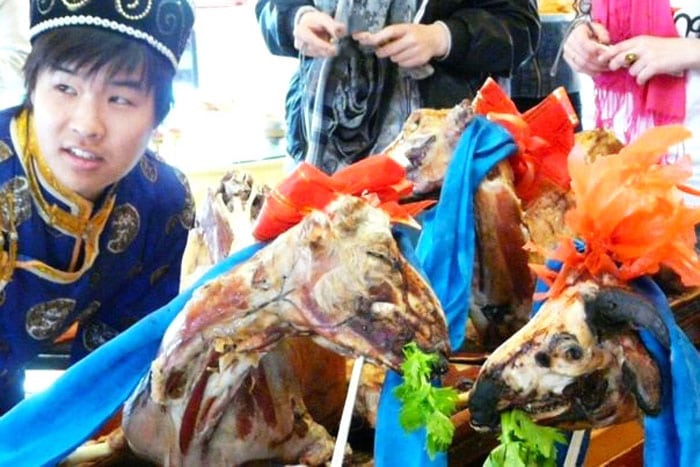
Travel tips
Local customs.
Inner Mongolia has a lot of traditions and customs specific to the region, which may be useful to know if visiting a Mongolian family. Most guides will explain these to you once you are there but here are a few to look out for:
- Do not walk through a flock or herd in the grasslands (walk around) as this is considered an offense to their owner;
- It is customary for Mongolian families to serve visitors a bowl of milk tea. Accept this with both hands and knock your bowl with your spoon if you do not want a refill;
- It is also custom for families to serve local liquor to their guests in welcome and to offer a toast. It is polite to accept the drink and thank the host even if you are not actually planning on drinking it;
- Mongolian families will present guests with a hada (piece of silk) and sing a song of blessing as a sign of welcome. It is tradition to accept the hada with both hands and to thank the host by crossing your arms across your chest.
Be prepared to eat A LOT of mutton in Inner Mongolia. Some typical dishes to try: Roasted whole sheep, Roasted gigot, Mutton hotpot and Handlebar mutton.
Want a break from all the mutton? Try these delicious buckwheat noodles in Hohhot.
In terms of drinks, the salty milk tea is a definite staple. Or try the local beer Xai Bei.
For some good old-fashioned souvenir shopping try Lao Jie (Old Street) in Hohhot. Some traditional Mongolian souvenirs include Mongolian silverware, Mongolian carpets, Mongolian knives with a sculpted blade, ox horn handicrafts and cashmere.
Are you ready to travel to Inner Mongolia? If you have any questions just leave a comment below!
Photo Credits: Photos by Marie Pilaud
About The Author
Marie Pilaud
Related posts.

The Stone Forest and the legend of Ashima

From Lijiang to Lugu Lake: Chronicle of a Hectic Trip

Gubeikou: Hiking on the Wild Great Wall
33 thoughts on “travel to inner mongolia: the complete guide”.
I am just wondering if foreigners need to register or apply for anything in advance of a visit. I’m thinking of visiting in September, but haven’t been to China for many years, so I’m a bit unsure.
Thank you so much in advance!
As far as I know there is no restrictions for foreign travelers to visit Inner Mongolia
If I can ride horseback and see wild hose in landscape in March?
I guess you can!
Hello. Thanks for the post. Me and my friend is planning to rent a car both for Xilamuren/Gegenta Grasslands and Resonant Sand Gorge. The only concern I have if it is possible to book a yurt in advance? It’s kinda risky to find a place on the day itself. :)
Thank you so much!
Hi, thanks for the article. I am planning a trip to Ordos in Jul with the spouse and am trying to decide whether to go independently or with a travel agency. Our plan is to spend just 2 days here, making a day trip to Resonant Sand Bay and exploring Kangbashi the rest of the time. Our base would be a hotel in downtown Kangbashi. Could I find out how practical it is to hire a taxi on the spot to bring us around for the 2 days and how much that might cost?
Hi, great article.
How easy is it to spend a few days walking/riding in the grasslands and staying in yurts. Is it easy to organise there? Ideally I would like to avoid a tour group.
Also any tips for travelling this area on a budget? Thanks
Hello William, your questions are quite general. I think we kind of cover them in the article!
Hi, thank you so much for a great and informative article! I’m planning on visiting the Hulunbuir grasslands in August for roughly 3-4 days and I wanted to know if we’d need the tick-borne encephalitis vaccination? Websites recommend it for people staying more than a month, or for short-term travellers who will be mainly outside (camping, hiking etc.) but if we’re just planning a homestay in yurts and some horse-riding, do you think we’d need it? Do you know of any other vaccinations we must get or should consider getting? Thanks in advance! Viola | A Piece of Viola
Hello Viola, sorry, we aren’t doctors.
We always suggest to ask to a doctor in these cases
I am planning to go in July but will be visiting Heilongjiang before heading over. May I know how I can arrange for a local guide or private tour? And is it safe as I am a female traveler alone.
Hello Samantha,
please read our articles about tours in China. China is relatively safe.
Thanks for your excellent article. I am an older male traveller. I’d rather like to join a small group when I am travelling, simply it a bit lonely doing by myself all the time. I am coming to Huhhot sometime in the first 2 weeks of June 2017. Are there any small tour companies that allow a solo to join their groups? I’d like to join a 5 – 7 day tour. See a bit of everything. No real itinerary, apart from an aversion to souvenir shops. And no, I don’t want to have my own driver and guide… a tour group of one it not my idea of fun. Keep up the good work. Chris S.( From Melbourne, Australia )
You should look for a local travel agency that offer this kind of tours, the problem is that Inner Mongolia isn’t a popular touristic destination among international travelers so it might be a bit hard to join group tours.
Is it possible to have contacts for local driver, local guide, and more detailed tips on how to do a 1-week family trip there? We live in China and travel a lot, always on our own and without agency because we love off the beaten track places with no people… Thanks for this great article and thanks in advance for your help…
You can contact us through the form in this post
Thinking of visiting Inner Mongolia very soon. Thank you so much for your insight and helpful tips. Very useful and very much appreciate your time and effort.
Paul & Elaine.
Thank you very much Marie. Great info for me. I am going to Inner Mongolia in June..
Great info. thank you so much.. traveling in June mid or end after completing Mongolia :-)
One of the most usefully peices of information on Inner Mongolia I have found
hi, I am a canadian who lived in china many years. what is it that you do in china now a days. Love to hear about it and maybe get some tips. please feel free to email me,
like your article. i’m a local Mongolian, starting to create my own travel website of Inner Mongolia, hope to get your opinion.
Hi, I am Evelyn Tan H N, a retired English Language Teacher from Singapore. Lately, I am interested to know more about Inner Mongolia. Especially to find out more about the whereabouts of the 1st batch of children members of the Rainbow Hulu Bluir Children’s Choir which was formed in December 2006 by a couple who is very famous in the Performing of Mongolian Cultural dance and singing aspect. (+65 87819894 Republic Of Singapore).
I would like to travel to Hulun Buir grasslands, stay in local yurt overnight, not big touristy type. I would also like to travel to Evenki reindeer herders and stay with them about 2 nights. Is this possible? I will be travelling in early December, and yes I do realise it will be very cold. I have done a lot of travelling in China, in winter, so I do realise how cold it will be. I can only find very limited information about the Evenki. Thanks Wendy
I am curious if you find any information about the Evenki. Did you stay with them during your travelling? Hope to hear from you.
thanks Daan
A great overview with some great and honest insights! Most obliged! JL :D
Hi! Do you suppose it’s possible to get a car from the Singing Sands Desert to Hohhot? I’m thinking about doing the desert in one day, then leaving early the next morning for Hohhot, seeing the old street, and then catching a train back to Beijing in the afternoon. How much do you suppose the car ought to be?
Hi Marie – loved your guidelines for Inner Mongolia. Having read them I am now seriously thinking of travelling on my own for a long weekend. Thank you :)
Leave a Comment Cancel Reply
Your email address will not be published. Required fields are marked *
Save my name, email, and website in this browser for the next time I comment.
Privacy Overview
Get 3 Months FREE with EXPRESS VPN
+ Best VPN For China + 30-Day Money-Back Guarantee + 24/7 Live China Customer Support + 3 Months Free on 12 Months Package

A Complete Travel Guide to Inner Mongolia
Inner Mongolia is an inland Mongolic autonomous region located in Northern China. It is the third-largest province-level subdivision in China, covering approximately 1.2 million square kilometers, about 12% of China’s total territory, more than four times of the United Kingdom. Curved in a banana shape, Inner Mongolia borders the Republic of Mongolia and Russia to the north, and Heilongjiang, Jilin, Liaoning, Hebei, Shanxi, Shaanxi, Ningxia, and Gansu provinces from northeast to southwest.
Due to the long stretch from east to west, Inner Mongolia is geographically partitioned into eastern, central, and western divisions. The eastern division is usually contained in northeast China with primary cities like Hulunbuir, Hailar, Tongliao, Chifeng. The central division is included in north China with major cities like Ulanqab, Xilin Gol, Hohhot. The western division is included in northwest China with main cities like Baotou, Bayan Nur, Ordos, Wuhai, Alxa.
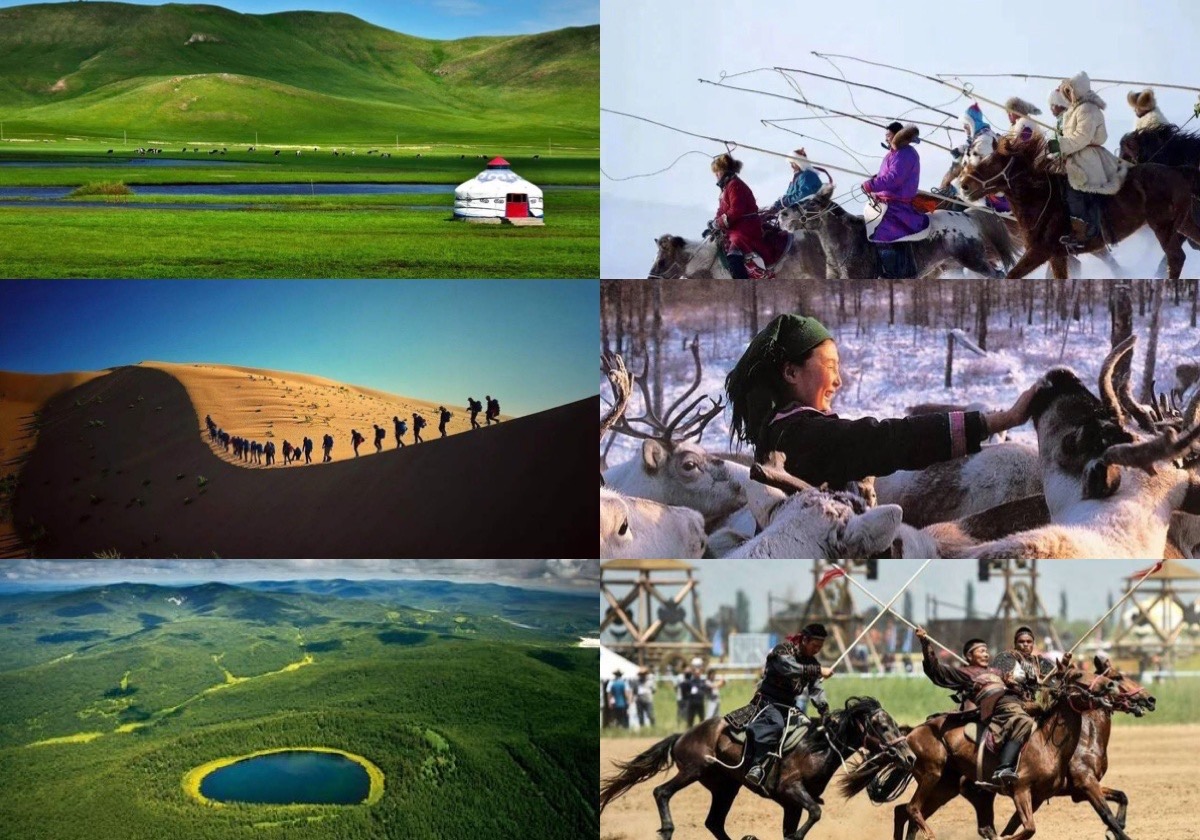
With a particular geographical position, Inner Mongolia boasts every kind of landscape imaginable. In the eastern and central division where vast grasslands and primitive forests are dotting, Mongol nomads still use the gently undulating plains as rangeland for their horse; head west, travelers will hit emerald lakes hidden amid the shimmering sand dunes of endless deserts. It's a perfect destination for your China tour if planning to follow the traces of the “real” Mongolia remains, in the matter of both landscape and people.
Highlights in Eastern Inner Mongolia: Hulunbuir, Arxan, Hailar
Highlights in central inner mongolia: hohhot, ulanqab, xilingol, highlights in western inner mongolia: ejina, alxa, ordos, best time to visit inner mongolia, inner mongolia climate, how to get to inner mongolia and travel around, recommended tour and itineraries for inner mongolia, accommodation and food in inner mongolia, useful travel tips.

Hulunbuir Grassland
Named after Hulun Lake and Buir Lake, Hulunbuir Grassland is a natural pasture located in the northeast of Inner Mongolia, facing the Daxing’anling Range (the Greater Khingan Range, China’s largest forest zone) to the east. Being reputed as the “Grass Kingdom'', it is the best-preserved grassland in China with most of its natural ecological environment such as forests, meadows, lakes maintaining their original appearance. Covering an area of about 100,000 square kilometers with 80% coverage of natural grassland, it is one of the largest grasslands in the world. Being the cradle of the nomads in northern China, Hulunbuir Grassland, blessed by nature, has provided rich and fertile soils for breeding the ancient civilizations of many northern nomads, such as Mongolia, Turkic, Khitan, Jurchen.
Hulun Lake, also called Dalai Nuur meaning Ocean-like Lake in Mongolian, surprisingly pops out of Hulunbuir Grassland like a colossal inland sea, about 47km away from Manzhouli. Covering about 2,333 square kilometers, it is the largest lake in Inner Mongolia and one of the largest freshwater lakes in China. To feel the lake’s true beauty, travelers can choose to stroll along the north shore of the lake, go horseback riding, watch water birds, take a cruise and go fishing, or simply camp close to the west shore and enjoy the extraordinary sunrise. To appreciate the full colors of the surroundings of Hulun Lake, best to go in summer and early autumn.
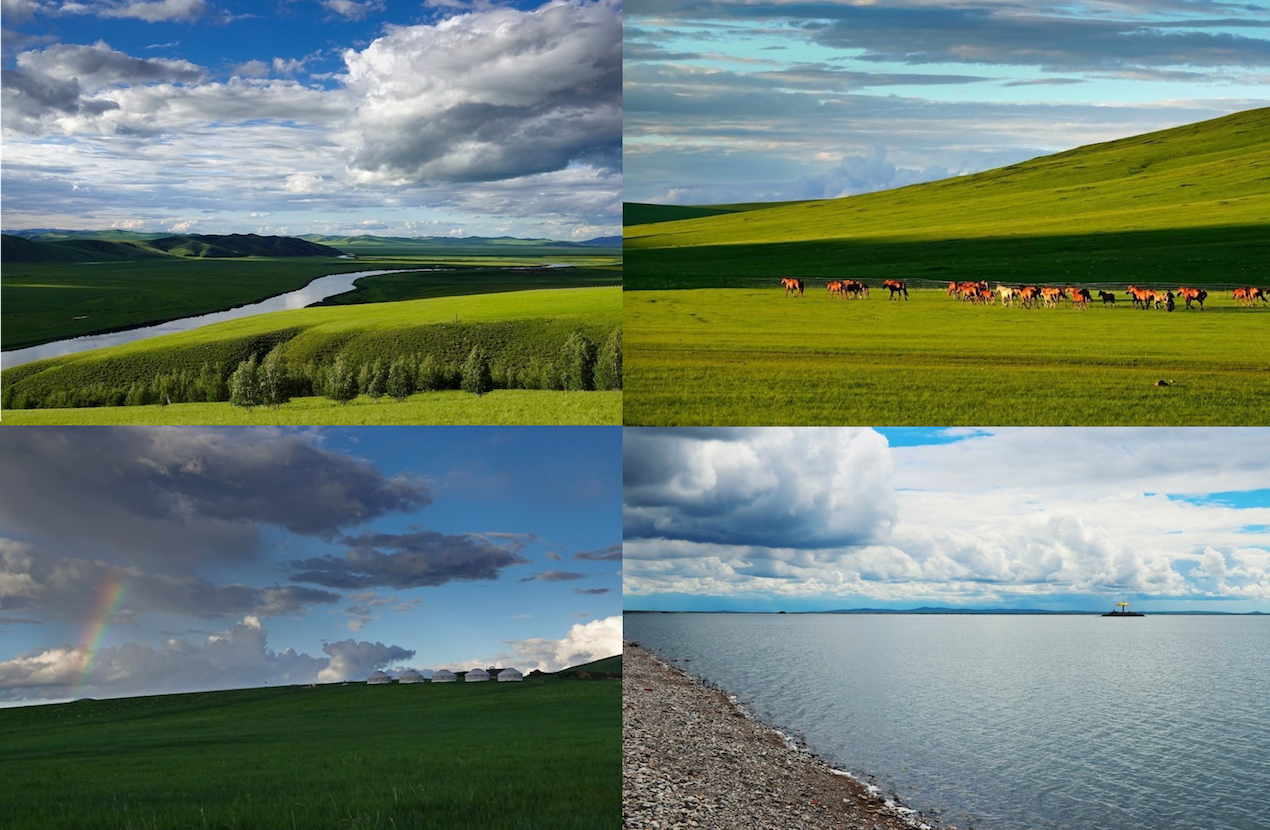
Located in Hulunbuir of Inner Mongolia, bordering Mongol and Russia on the west and north respectively, Manzhouli is a transliteration of a Mongolian word which means “luxuriant spring water”, and named after the railway station built there in 1901. This garish pastel-painted thriving city brings together the border gate, the Matryoshka Doll Square with the largest Matryoshka dolls in the world. The Ice & Snow Festival takes place there every winter from February to early March, where travelers can appreciate different themed large ice and snow sculptures and join winter activities, though a smaller version of the one happens in Harbin.
Ergun Wetland (Genhe Wetland)
Ergun Wetland, formerly known as Genhe Wetland, is located in Ergun city in Hulunbuir of Inner Mongolia. Covering an area of 126,000 hectares, it is one of the largest wetlands in China. Coming to be home to a wide range of plant and animal species, Ergun Wetland has good displays of the wealth of life in its diverse ecosystem. Get atop the hill, travelers will be immediately convinced of what claims to be the “No. 1 Wetland in Asia” by the panoramic view, that is the verdant green giving way to sparkling golden willows, bushes, poplars, and birches which spreads along the slopes as well as both banks of the zigzagging Genhe River, which flows into the nearby Ergun River.
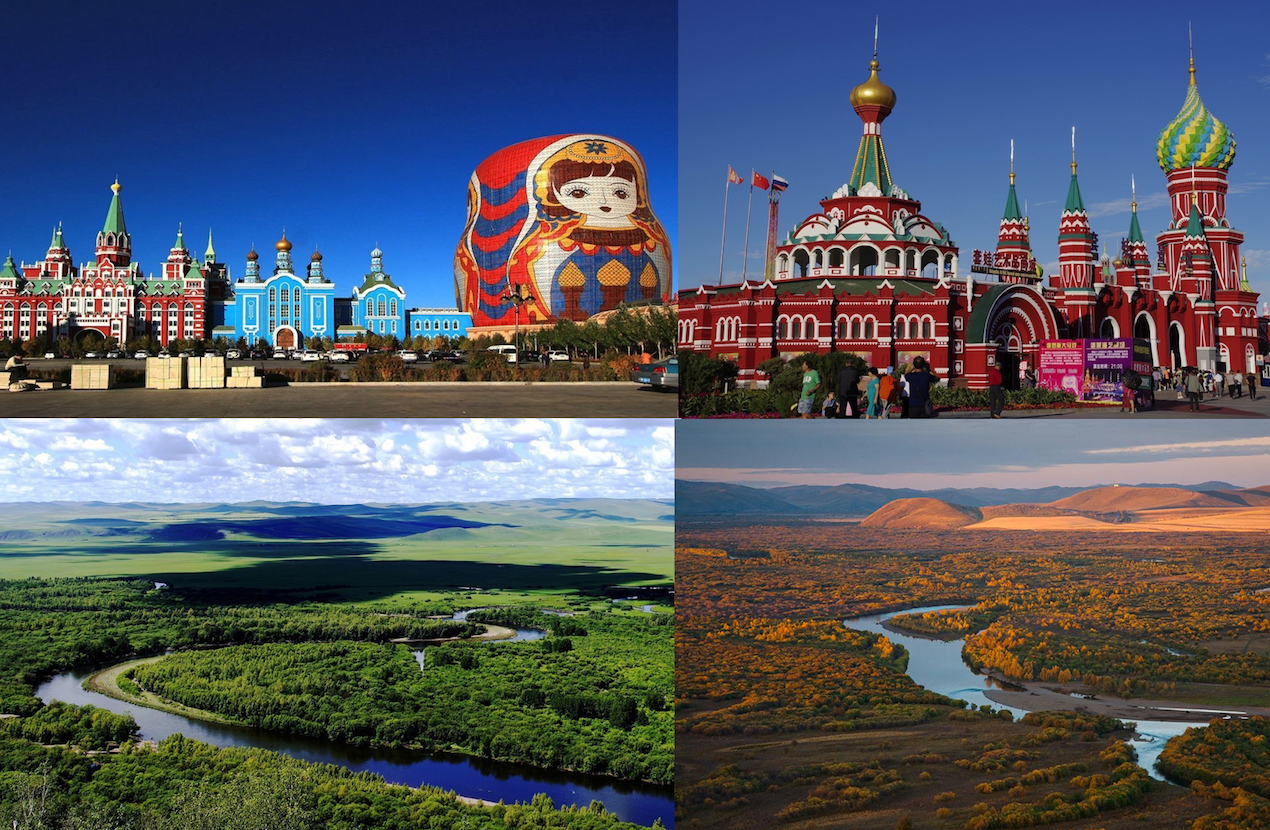
Arxan National Forest Park
Arxan National Forest Park, embedded in the southwest foothill of the Greater Khingan Range, is located in Arxan, Hinggan, Inner Mongolia. It houses the highest peak of the Greater Khingan Range - Terme Mountain [1,378m] and the largest lake of the Greater Khingan Range - Darbin Lake, as well as the Shitanglin Forest and Heavenly Lake which are formed by solidified lava. From the Grand Canyon with thick golden pine forests and various shaped volcanic rocks to the crater lake on Camel Hump Mountain with a well-maintained ecological environment, the park is full of so many great places to see. Move southwest, follow the primitive pine forest and bizarre solidified lavas, an L-shaped lake will surprise you with surrounded flaming azalea flowers in Spring, as well as a natural ski field in winter.
Reindeer Tribe in Aoluguya
Aoluguya is a township in Genhe City, located in the core of the primitive forests in the northern part of the Greater Khingan Range. In “Aoluguya” (means a place with flourishing aspens), there lives a mysterious ethnic minority group - the Ewenki people, who are called “reindeer tribe” as they are the only ethnic-minority people in China making a living by raising reindeer. Reindeer were their major methods of transportation in the past and their closest friends. Nowadays, while many Ewenki herders have taken modern lifestyles, there are more than 30 veteran herders still keep the traditional way of raising reindeer and use their ways to promote reindeer conservation to the rest of the world.
Arshihaty Stone Forest
The Arshihaty Stone Forest is situated at the Hexigten Banner of Chifeng. Perched on the transitional area from the remnants of the Greater Khingan Range to the grassland in the west, the Arshihaty Stone Forest is a famous forest of granite columns carved by frost splitting, freezing, thawing, and wind erosion, which is rarely seen elsewhere in the world. Geologically, the mysterious and unique rocks and stones are relics of the Quaternary Glacier, so it is also called the “Glacial Stone Forest”. As an integrated part of Hexigten World Geopark, the scenic area of Arshihaty Stone Forest consists of five areas: the Moon Castle, Sworn Brothers, Eagle with Folded Wings, Fortress Besieged, and Live Folk Entertainment.
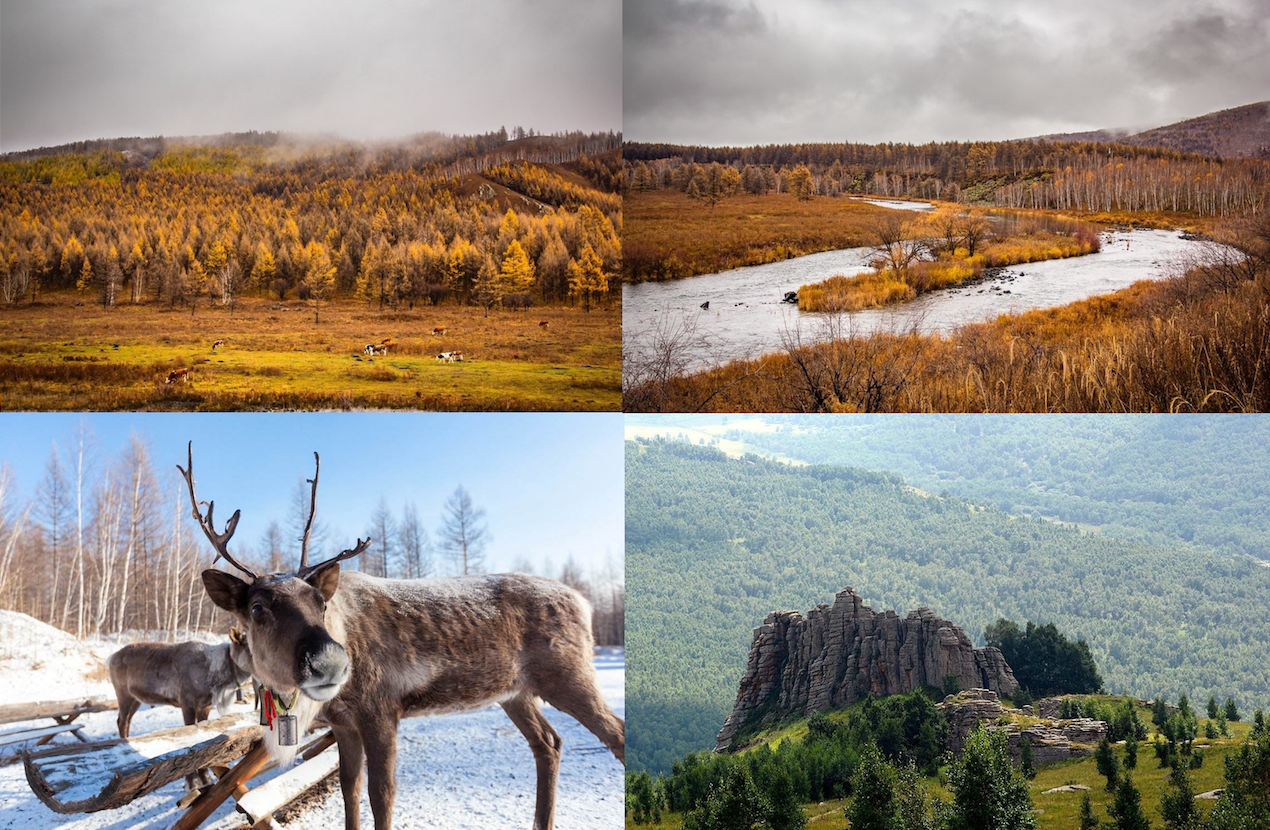
Gegentala Grassland
Located in the hinterland of the Ulanqab Grassland, Gegentala Grassland is about 128KM from the provincial capital Hohhot. In Mongolia, “Gegentala” means “the summer resort” or “the place for grazing in summer”. It has been a great natural pasture since ancient times, with vast fertile grassland, herds of horses, and flocks of sheep. As the first government-owned grassland, Gegentala Grassland has been appealing to many travelers from domestic and abroad since 1979. It’s getting more vivid now, with striking prairie scenery and colorful featured Mongolian activities. The flourishing grass, undulating hills, galloping horses with yelling herdsmen, soaring hawks, and traditional yurts, forming a dynamic picture presented by nature.
Huitengxile Grassland
Huitengxile Grassland is located in the Chahar Right Middle Banner, in the city of Ulanqab of Inner Mongolia, about 135km away from Hohhot. In Mongolia, Huitengxile” means “Cold Plateau”. It’s getting particularly cool in summer, with an average maximum temperature of 18°C, so it is known as a "summer resort". With an average altitude of 2,100m, it is a typical alpine meadow with complex geology, overlapping peaks, and rich grass species. There are 99 natural lakes like shattered mirrors scattered on its grassland, making it extremely elegant and energetical. Besides the spacious grassland and natural lakes, there is the largest wind power plant in Asia, as well as many historical relics, such as Great Wall ruins, Woyang City ruins.
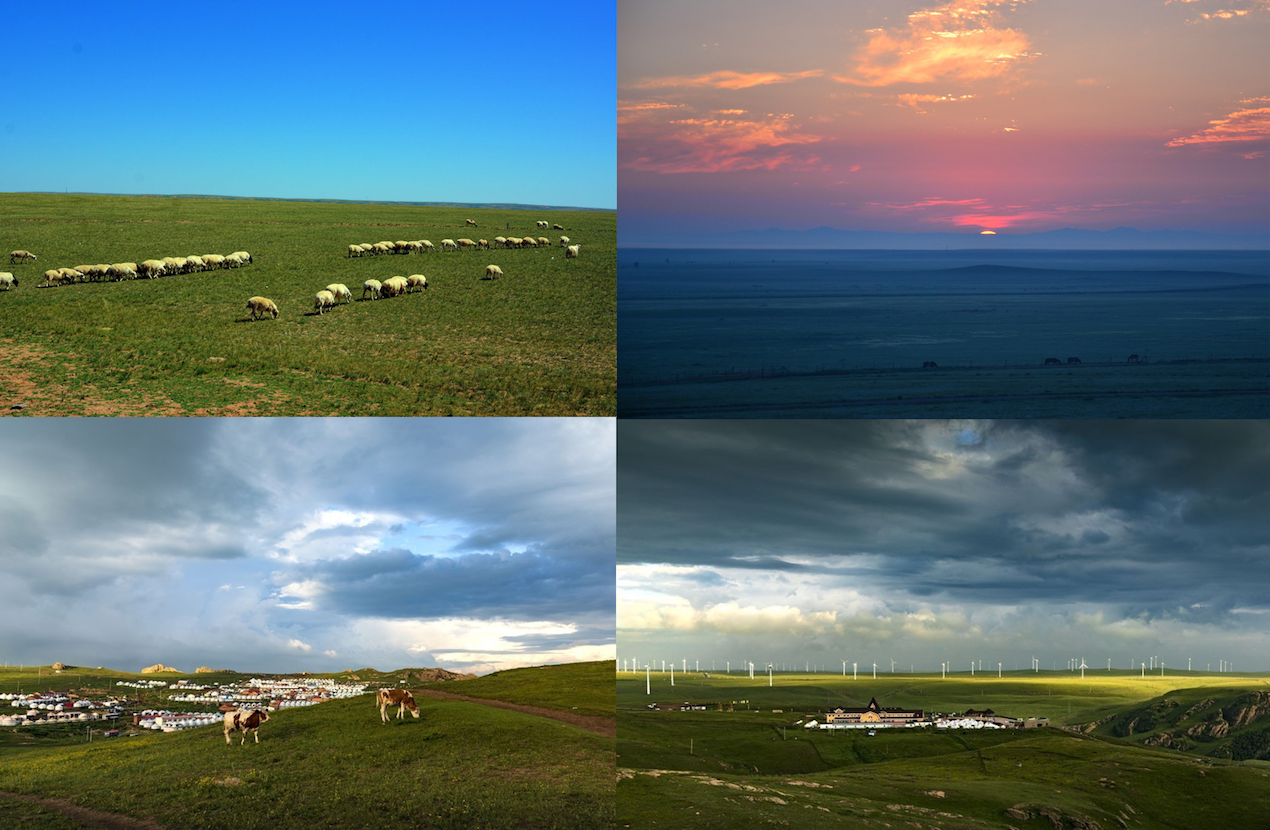
Xilamuren Grassland
Xilamuren Grassland is located in the Xilamuren Town of Baotou City, but it is more close to Hohhot (about 88km) than Baotou (about 180km). It is the nearest grassland to Hohhot with about 1.5 hours drive. “Xilamuren” is previously called “Zhao River” (“Zhao” means “Temple” in Mongolia), because there is an old lamasery called Puhui Temple situated on the bank of Xilamuren river, which is served as the summer palace of Xilitu Buddha. A visit to Xilamuren Grassland allows travelers to have great unforgettable experiences, such as a traditional welcome ceremony, taste of kumiss and local Mongolian food, horse riding, and staying in a traditional Mongolian yurt…whilst enjoying the mesmerizing scenery of endless grassland.
Dazhao Temple
Dazhao Temple, or Wuliang Temple, the first building of Hohhot, is one of the oldest and largest temples in Inner Mongolia dedicated to the Tibetan Buddhism of Gelugpa order. Unlike its older brother in Lhasa enjoyed kinds of respect, Dazhao Temple had been ignored for the first decades since it was originally built in 1579, and gained its fame among people from all over Mongolia, until 1586 when the 3rd Dalai Lama came to the temple and consecrated a gigantic silver statue of Sakyamuni. Besides the 10ft silver buddha statue, the temple houses another two treasures: the remaining murals and the lifelike dragons carved on the aureate pillars that sit on both sides of the statue.
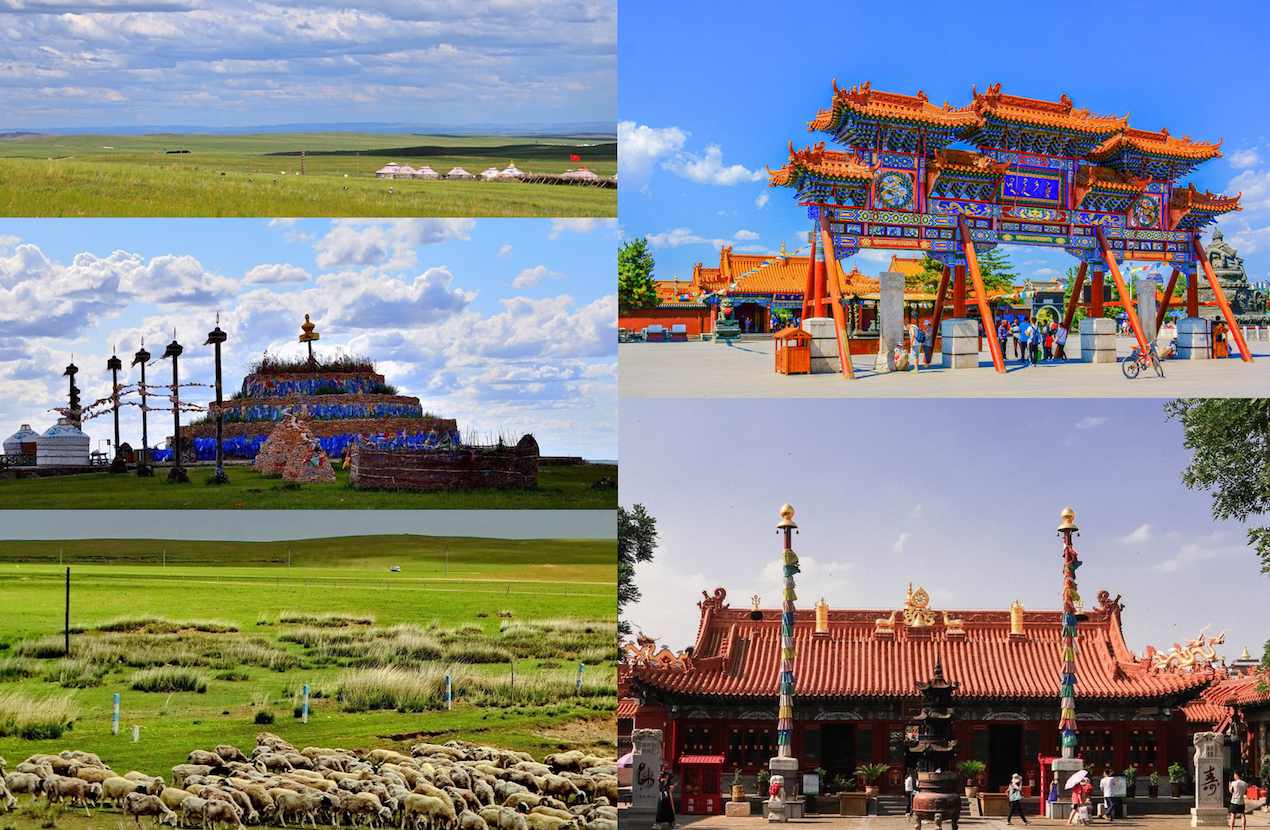
Zhaojun Tomb
Zhaojun Tomb is perched on the Dahi river, about 9 km from the city of Hohhot. It is an honorary mound in commemoration of Wang Zhaojun, a commoner woman from the Han dynasty who married a Xiongnu Chanyu (nomadic chieftain from the grasslands) and brought a harmonious relationship enjoyed by both Han and Xiongnu people. Even though her remains are not actually buried beneath this 33-meter-high tomb, it’s still noted for its remarkable scenery and striking statues. There are stone staircases leading to a view deck for the panoramic view of the scenery around the tomb, as well as the outline of the drizzly Yin Mountains uplifting in the distance.
Five Pagoda Temple
Five Pagoda Temple is in the surrounding area of Qingcheng Park, located in the old part of the city of Hohhot. Built according to the complex of the Gaya Temple in India, it is one of the special “diamond throne” pagodas of Indian Buddhist architecture. Unlike other pagodas, the Five Pagoda Temple features short eaves and tops of pagodas which are glazed in green and yellow color. The complex is a megastructure consisting of the base of the pagoda, the Buddha’s warrior seat, and the superstructures (the five stupas), resembling a mausoleum with five exquisite quadrangle minaret-like pagodas on the top of it.
Wanbu Huayanjing Pagoda
Known as White Pagoda, it's located in Baita village of Hohhot. Built-in the Liao Dynasty, the pagoda is a superior example of ancient Chinese architecture that has endured for almost 1,000 years. Standing at a height of 55 meters, it is a serve-floor brick and wood structure in octagonal shape. With a large number of statuettes of Buddhas, Bodhisattvas, and Warriors depicted in different stances along the external side of the pagoda, as well as many Buddhist scriptures and inscriptions in multiple languages. It was listed as a national cultural relic site in 1982 at the highest level of protection in China.
Inner Mongolia Museum
Inner Mongolia Museum, a massive provincial museum, sits on Xinhua Street in the city of Hohhot. The museum, with an exceptional inclined roof resembling the boundless grasslands of Inner Mongolia, particularly gives an insight into the history and traditions of the Mongolian people, from the exhibition dedicated to the life of Genghis Khan to the exhibition of ethnic relics reflecting the daily life of nomadic Mongols, including production, culture, folklore, art, and religion, as well as the display of complex Mongol bone carvings describing historical events. In addition, the museum is well-known for its large-scale collection of well-preserved fossil skeletons of dinosaurs, Mammuthus, coelodonta antiquitatis, and fossil faunas in the Mesozoic era and Cenozoic era, attracting numerous fossils addicts from all over the world.
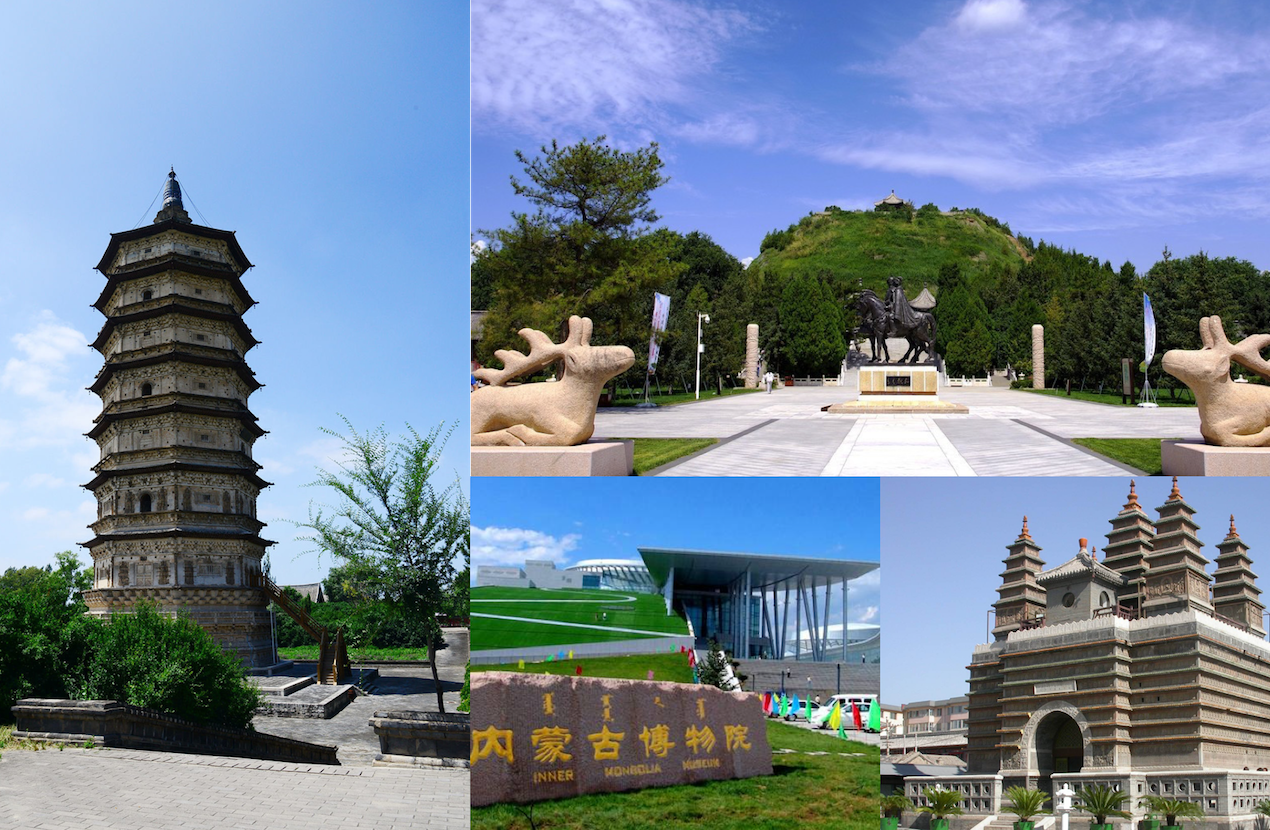
Xilingol Grassland
Xilingol Grassland, one of China’s four largest grasslands, is situated in Xilinhot City of Xilingol League of Inner Mongolia. Constituting the main portion of natural pastures in Inner Mongolia, it is the most typical temperate steppe composed of grassland, marshlands, wetland, and sand dunes, with various types of vegetation and plentiful plant species. Being reputed as a paradise of grassland and the most beautiful grassland in north China, it allows travelers to appreciate an impressive view of the nine-bend river, the desert-steppe, and a transition belt from the meadow grass to the birch forest, with the opportunity to experience the nomadic lifestyle and learn their culture.
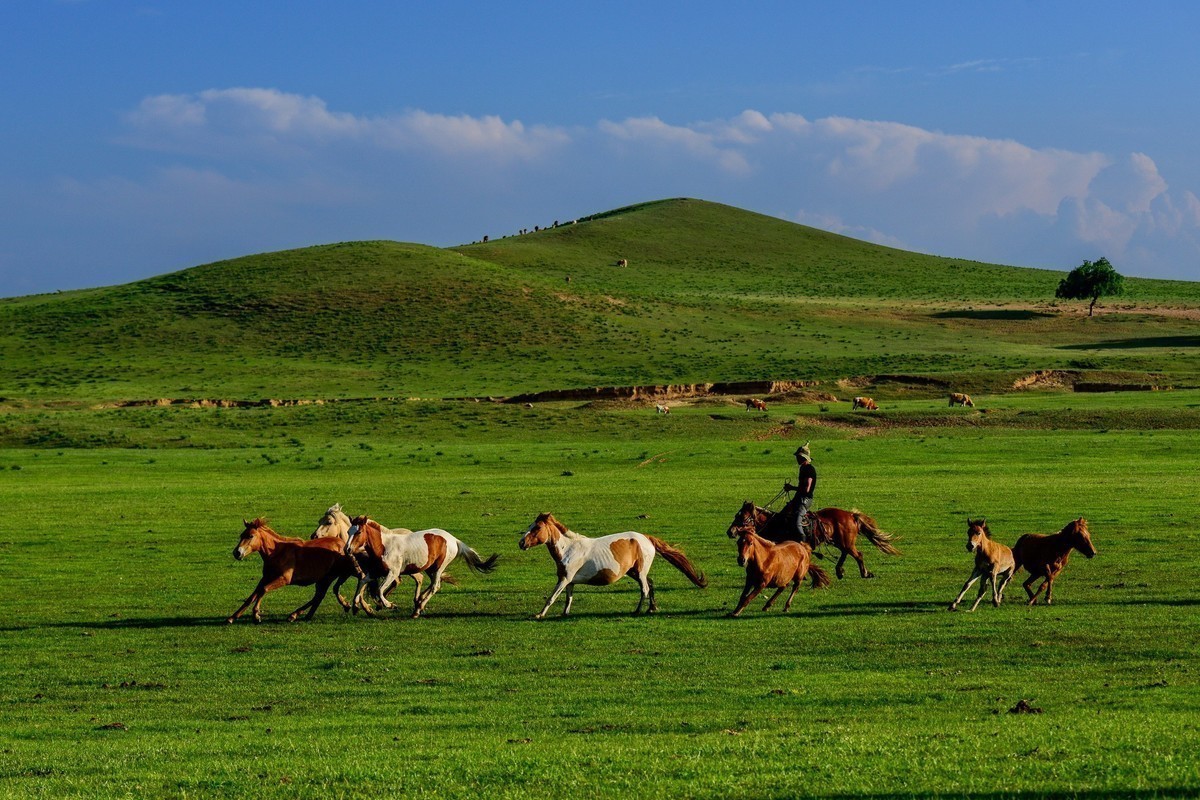
Ejina Populus Euphratica Forest
Located in Dalaihob Township, Ejina Banner of Alxa League, covering a total area of 3,800 square kilometers, Ejina Populus Euphratica Forest is one of the three remaining natural forests of Populus euphratica (or Euphrates Poplar or Desert Poplar) - an old kind of poplar tree in the willow group. Another two are in the Sahara Desert and Taklamakan Desert. The locals also call Populus euphratica the “hero tree”, due to its magical ability to withstand drought, wind-driven sand, and its tenacious vitality in the desert. Each autumn, around the period from September 25 to October 15, the forest becomes a photograph paradise with a sea of golden leaves, attracting countless travelers and photographers to enjoy the magnificent scenery.
Khara Khoto Ruins (Black City Ruins)
Khara Khoto Ruins, the most complete and grand ancient city ruins existing on the Silk Road, is located about 22km southeast of the Dalaihob Township in Ejina Banner. Khara Khoto, aka Black City, was established by Tangut Mongols in 1032 as the metropolis of their Western Xia Dynasty (1038 -1227) and turned into a prosperous trade hub. Many architectures have been grounded into nubs by centuries of sandstorms. At the moment, all that is left of this ancient city are the rectangular shaped city walls, five high pagodas shaped like upturned bowls, a variety of collapsing mud houses, and the remains of what is likely to be a mosque on the edges of the outer walls, which lure the imaginations of travelers from afar.
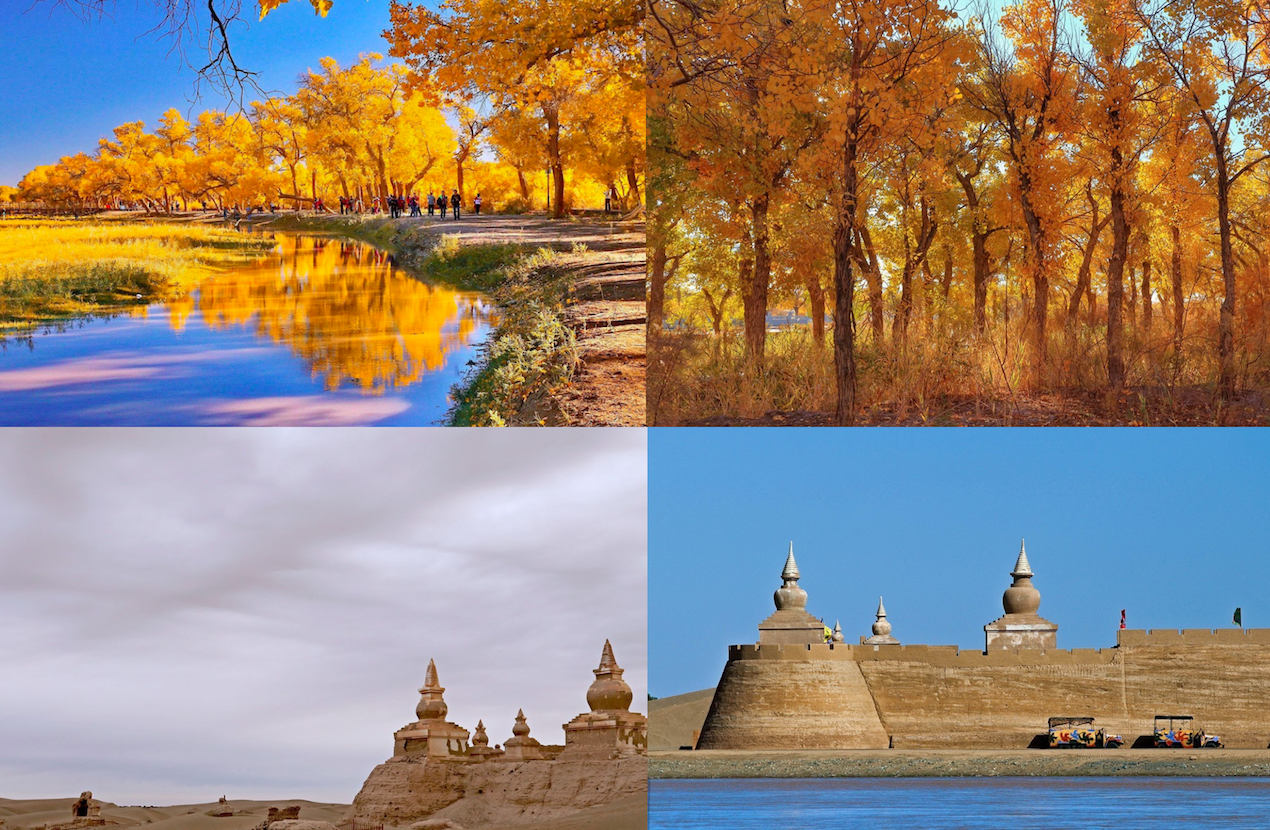
Wudangzhao Monastery
Wudangzhao Monastery, the largest and best-preserved Tibetan Buddhist monastery in Inner Mongolia, is approximately 70km northeast of Baotou. “Wudangzhao” is a Chinese transliteration of Mongolian words for “willow monastery”, thus the monastery is named after the prosperous willows in the valley where the monastery is built. “Badekar Monastery” is its Tibetan name, which means white lotus in the Tibetan language. Constructed according to the layout of Tashilhunpo Monastery in Shigatse, it is a complex of white Tibetan architectures settled horizontally against the background of a green mountain with verdant trees, with halls along the central path ascending up into the mountain.
Mausoleum of Genghis Khan
The world-famous Mausoleum of Genghis Khan is located in the Xinjie Town in the Ejin Horo Banner in the Ordos Prefecture of Inner Mongolia, about 115 km from Baotou. This is the grandest temple paying tribute to Genghis Khan, where he is worshipped as a godlike figure, dynastic founder, and deity of the ancient Turkic religion known as Tengrism. In fact, the mausoleum is a cenotaph where the coffin contains only headdresses and accessories, but no remains of the great Mongol warrior himself. The actual location of his remains has never been discovered because he was buried without any marks according to his will.
Resonant Sand Bay (Xiangshawan)
Known in Chinese as Xiangshawan, the Resonant Sang Bay is located in the eastern end of Gobi’s Kubuqi Desert of Inner Mongolia, about 1 hour’s drive from Baotou. It gets its name from a roaring sound created by sliding down its sand dunes from the top during dry weather, and the sound is similar to that of an airplane. It was the most unreclaimable site, but it was developed as the first comprehensive desert resort, in the process of China's general campaign to fight against desertification. This desert-themed resort contains four "islands" of sand-based entertainment activities surrounding the main site - Xiangshawan Port, as well as the Sand Dune Resort which is used as the reception area.
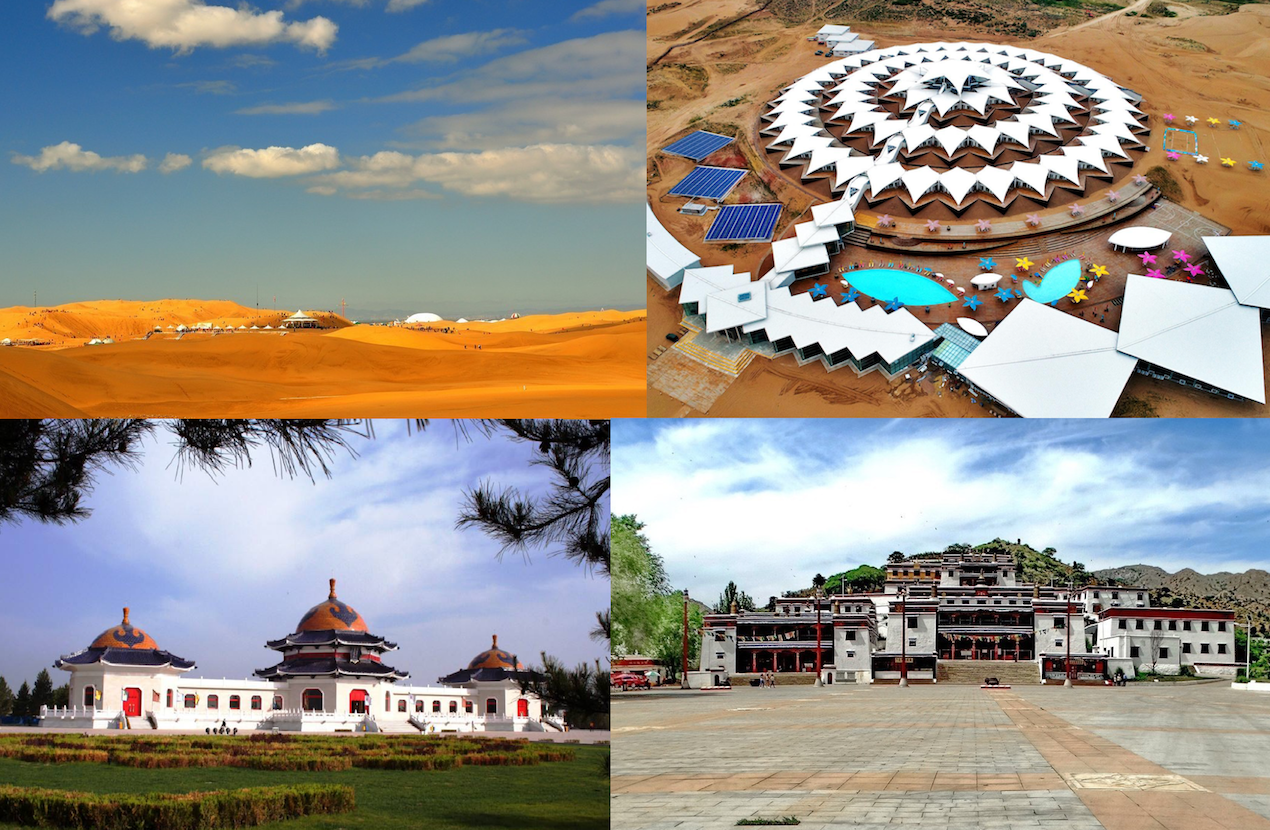
Badain Jaran Desert
Badain Jaran Desert, across Ejina Banner and Alxa Right Banner, is perched on the southwestern edge of Inner Mongolia. Covering approximately 49,000 square kilometers, it is China’s third-largest desert. Serving as the home for myriad natural oddities, such as the tallest stationary dunes in the world, the singing sand dunes, and many scattered colorful lakes, it comes at the first-ranking of the “Five Most Beautiful Deserts in China” picked by “Chinese National Geography”. The highlights include the worlds’ tallest stationary sand dune Bilutu Peak (500 meters/1,600 feet), Badain Jaran Temple, Badain Jaran lake, etc.
Tengger Desert
Tengger Desert is mainly covering the southwest of Alxa Left Banner of Inner Mongolia and straddles the border with Gansu and Ningxia. As the fourth largest desert in China, it covers an arid nature area of 36,700 square kilometers. Tengger Desert is dominated by 71% sand dunes. In addition to the magical landscape of shifting sand dunes with occasional herds of two-humped camels, it’s also an ideal place for hiking and camping with charming inner lakes, flatlands, grassland, and hills accompanied. Among all inner lakes, the Swan Lake is the most famous and recommended with many sand jujube trees and vigorous Malan flowers along its shore.
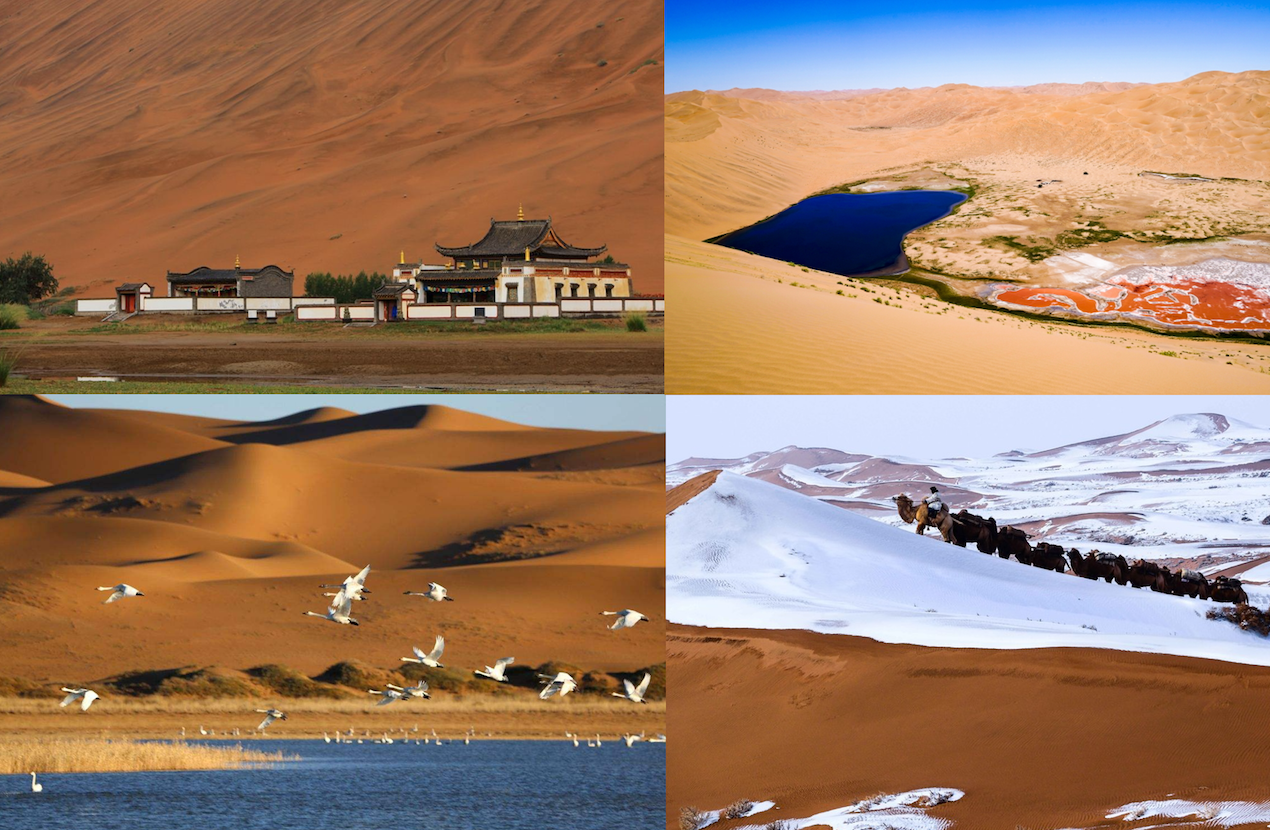
Being far off the ocean with vast land and a high altitude above sea level, Inner Mongolia boasts a temperate monsoon climate with few and erratic rainfalls, as well as a sharp change of temperatures. It is widely accepted that the summer between May and September is an ideal time to visit Inner Mongolia . However, considering its wide range, the best time is varied for different parts. For the east area with grasslands, the best time is from July to August when the grass turns green with blue sky. For the west area with deserts, it is suitable for traveling from July to mid-October . For the forest region in the vicinity of the Greater Khingan Range, it is recommended to travel during the middle to late May with blooming wildflowers, or during the middle of September with colorful foliage.
For travelers who wish to witness the region’s Naadam Festival, travel to Inner Mongolia in July . Naadam, also known as “Nair,” means entertainment in the Mongolian language, which is a showcase of Mongols’ athletic prowess and skills. The Naadam Festival, the most magnificent event of the year, happens in grasslands across the region from the 4th of June by the Chinese lunar calendar and lasts for 5 days . During this grandest time, Mongol ethnic people will compete in “three games of men”, and those games are Mongolian wrestling, archery, and horse racing. The festival is far beyond a number of sports competitions but also a celebration of the nomads for spiritual pursuit, which gives travelers a chance to join the local Mongolians with festival activities, including singing, dancing, and the taste of traditional cuisine.
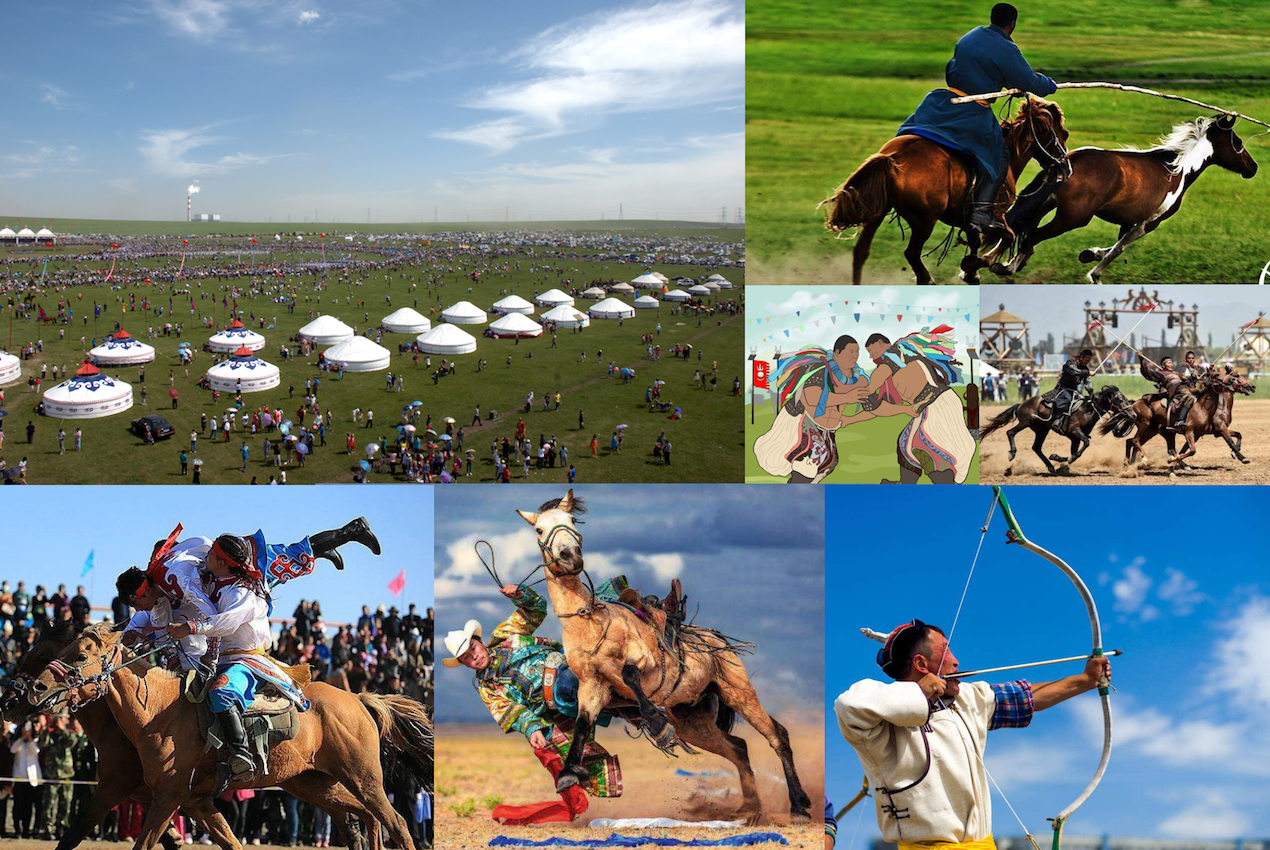
Four Seasons of Inner Mongolia
Spring (April-June): The weather is mild, without too much rain. However, it can be windy with frequent dust storms in the desert areas, and the grass hasn’t turned to be green yet in the grassland areas. Thus we would recommend exploring the cities like Hohhot or Baotou for some historical and cultural sites.
Summer (July-August): Even though summer is quite short, it is the best time to appreciate the verdant and soft grassland with comfortable and cool weather. The temperature is averagely ranging from 17˚C (63˚F) to 26˚C (79˚F). We would recommend a trip either to Hulunbuir Grassland, or one of the grasslands close in the middle division.
Autumn (September-early November): The temperature drops abruptly and the frost always comes early in autumn. But this period is the best time for an adventure to deserts in the western part of Inner Mongolia. Besides, from early to middle October, it is the best time to appreciate the Populus Euphratica Forest in Ejina, which looks like a golden sea.
Winter (mid-November-March): Winter lasts for a very long time, sometimes even more than half a year, which is freezing cold with temperature ranging from -10 °C (-50 °F) to -23 °C (-73 °F). For travelers taking a winter trip to Inner Mongolia, we would recommend visiting the Manzhouli Ice and Snow Festival for the giant ice carving in different shapes.
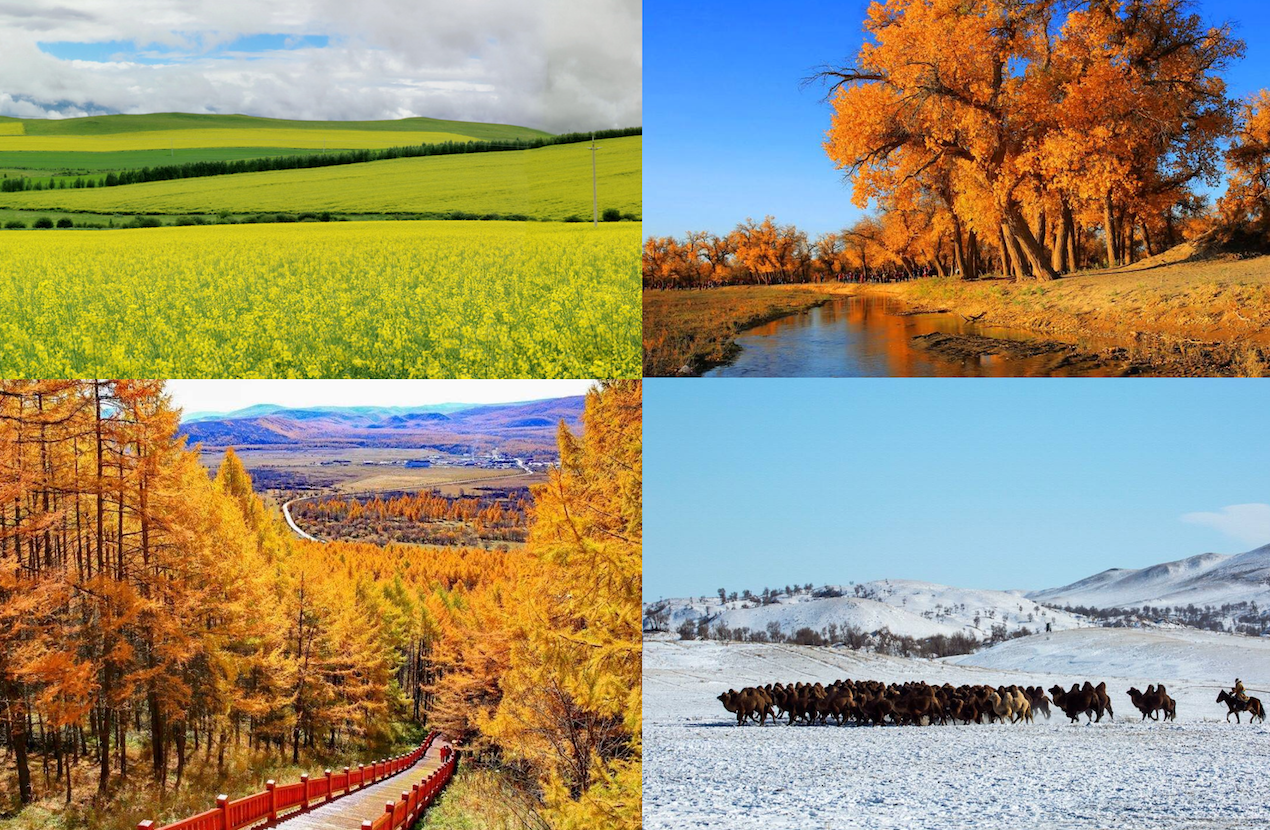
With airways and railways as the main transportation, it’s easy and convenient to connect Inner Mongolia with north China, northwest China, and northeast China.
Flight to Inner Mongolia
There are more than 10 public airports in Inner Mongolia, and the most frequently used by travelers are Hohhot Baita International Airport, Baotou Erliban Airport, Hailar Dongshan Airport, Manzhouli Xijiao Airport. Except for the international flights connecting Hohhot and Ulaanbaatar in Mongolia, most airports in Inner Mongolia only provide domestic flights, thus foreigner travelers will need to reach one of the main cities of China, before getting to Inner Mongolia. Most travelers will choose Beijing as the gateway to Inner Mongolia, as there are frequent non-stop flights from Beijing to Hohhot, Baotou, etc.
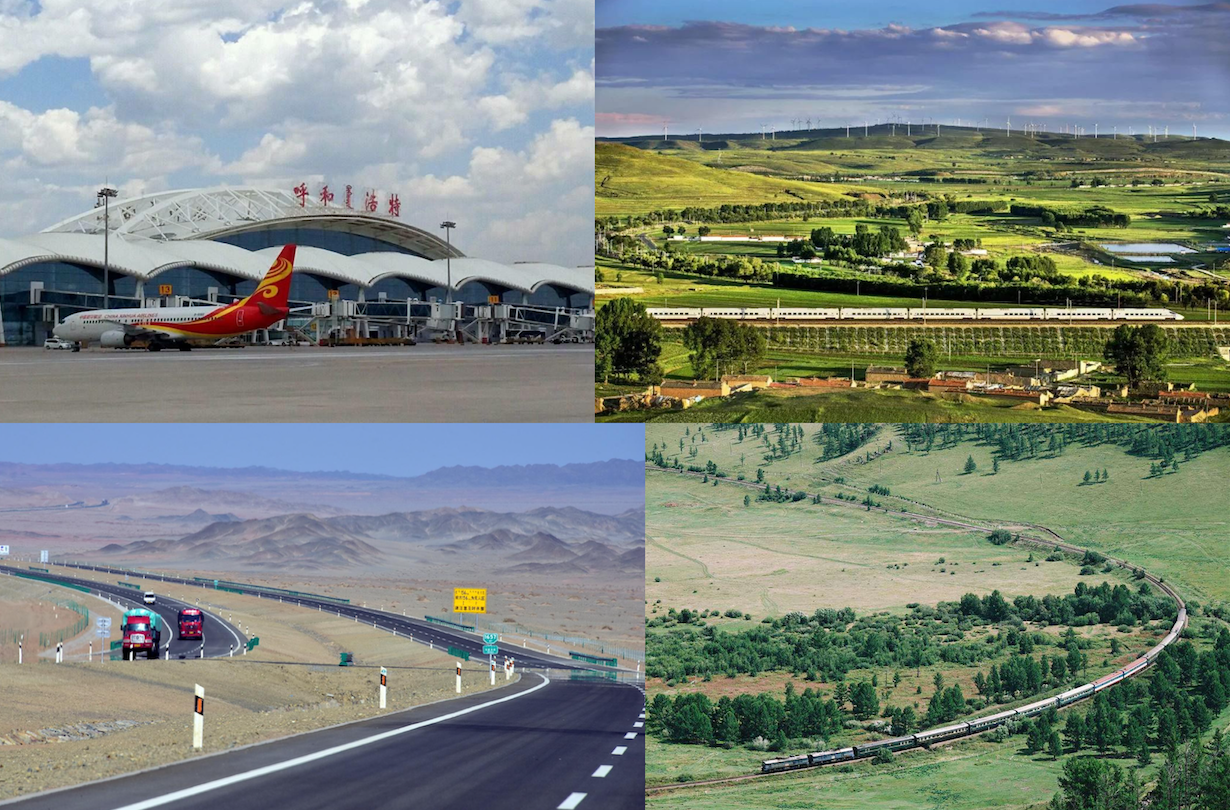
Train to Inner Mongolia
The Chinese railway network links most cities of Inner Mongolia and gives access to the cities of neighboring regions. With great development achieved on transportation, traveling by high-speed train is an easy option within a few hours to reach Hohhot and Baotou from Beijing or Taiyuan, Datong in Shanxi province, to reach Chifeng and Tongliao from the cities in northeast China regions, such as Shenyang, Dalian.
Travel within Inner Mongolia
The most convenient way to travel between cities in Inner Mongolia is by bus, however, all timetables or bus signs are displayed in Chinese only, so it can be tricky for travelers who can't read Chinese. For travelers who want to get to the main attractions in the city of Hohhot and Baotou, a combination of train and taxi will be a good choice. But for travelers who at least want the option to walk around on their own and veer off the beaten path, it’s better to hire a private car with a local China travel agency .
China's northern edge - Inner Mongolia contains marvelous desert and graceful grasslands. With open and wide areas retaining a sense of permanent serenity, somewhere that still appears wild and pure, unlike anywhere in China. With the vast territory, it would take at least 5-7 days to explore one region (eastern, central, and western divisions), and more than 2 weeks to cover two or three regions . Here we recommend the most chosen 2 routes for reference. For travelers who have their thoughts or preferred route, please feel free to share with us , and we are happy to tailor a unique trip for you.
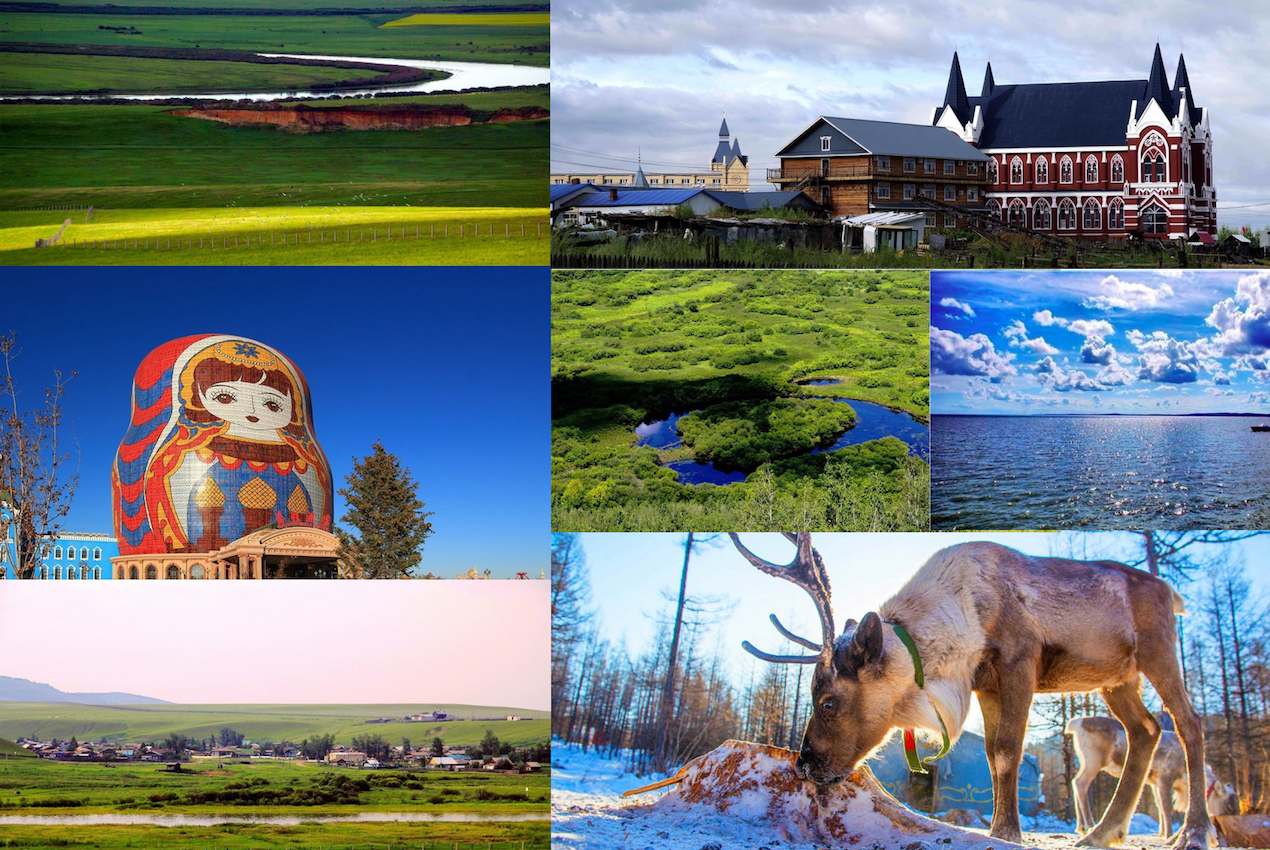
Ready to chase the galloping horse, explore the simply untouched natural beauty and catch a glimpse of Mongolian culture? The 7-day adventure through Hulunbuir below is perfect for travelers looking to connect with nature in the best-preserved grassland in the world. Explore the beautiful surroundings of Hulunbuir Grassland and Ergun Wetland and take part in the featured Mongolian activities. With the opportunity to know the “Ewenki people”, the only hunting tribe in China which keeps its reindeer, this is an adventure that you will never forget.
- Day 1: Hailar arrival. Overnight at Hailar.
- Day 2: Drive to the Hulunbuir Grassland. Overnight at Mongolian yurt.
- Day 3: Drive to Shiwei Town, visit a white birch forest on the way. Overnight at a local Mukeleng Guest House (Russian-style wooden house).
- Day 4: Visit a Russian wooden house built over 100 years ago first, and then loiter along the Argun River. Continue the way to the Moerdaoga National Forest Park. Afterward, drive to Genhe City. Overnight at Genhe.
- Day 5: Drive to Aoluguya to explore a mysterious deer tribe - Ewenki people. Then drive to Ergun City. Overnight at Ergun.
- Day 6: Visit the Ergun Wetland. Afternoon head to Manzhouli. Overnight at Manzhouli.
- Day 7: Visit the Matryoshka Doll Square, then proceed to the Hulun Lake. Afterward, drive to Hailar for the flight out.
From the lush grassland to the vast desert, this 5-day tour immerses you in the rich cultures and landscapes of central and western Inner Mongolia. Stay in traditional Mongolian yurts, travel through the desert on a camel and discover the Tibetan Buddhist shrine in both Baotou and Hohhot. This tour is perfect for travelers looking to discover both the grassland and desert of Inner Mongolia in a short amount of time.
- Day 1: Hohhot arrival. Overnight at Hohhot.
- Day 2: Drive to visit Xilamuren Grassland. Overnight at Mongolian yurts.
- Day 3: Enjoy the sunrise on the grassland, drive to Resonant Sand Bay. Overnight at Baotou.
- Day 4: Visit Wudangzhao Monastery, drive to Hohhot to visit Dazhao temple and Inner Mongolia Museum. Overnight at Hohhot.
- Day 5: Hohhot Departure.
Accommodation
When imagining accommodation in Inner Mongolia, travelers would definitely be thinking of yurts - those used by nomads to move around the great prairies. Though staying in a yurt is still possible in grassland areas from late May to August for curious travelers who want a traditional experience, more travelers also want the hotel options for stay in the cities, like most locals live in stone or concrete architectures nowadays. There are many choices in Hohhot - the capital of Inner Mongolia, and Baotou - the largest city in Inner Mongolia, from Luxury 5 star hotels to budget hostels, ranging from CN¥ 200 to over CN¥ 1,000. When getting outside of the major cities to remote areas, the choice will be limited, so it’s better to rely on a local travel agency for useful suggestions or arrange a comfortable stay.
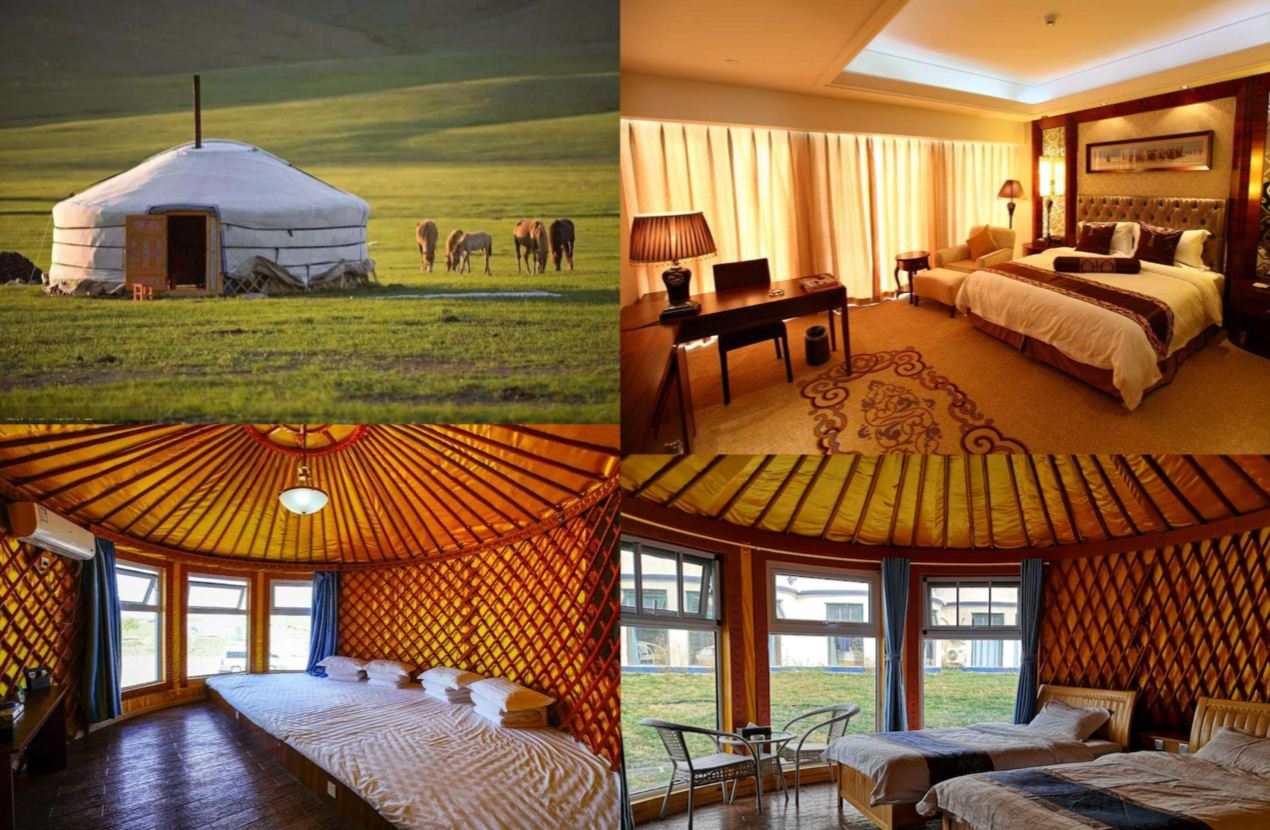
Traditional Mongolian food dominates in every part of Inner Mongolia, characterized by high dairy products, fatty meats, and wheat-based foods. In terms of drinks, the authentic Mongolian milk tea is an undoubted staple, in a distinctive flavor with salt added, and it is often provided by hotels along with breakfast. Alternatively, try a bottle of the local beer named Xai Bei, which tastes more flavorsome than a lot of Chinese beers. For meals, be prepared to find a menu all about mutton in almost every restaurant, and we would recommend trying some typical dishes, such as roasted lamb, mutton hotpot, and grabbing mutton. For those who are vegetarian or want a break from all the mutton, they can try the delicious buckwheat noodles or the oat flour pancakes.
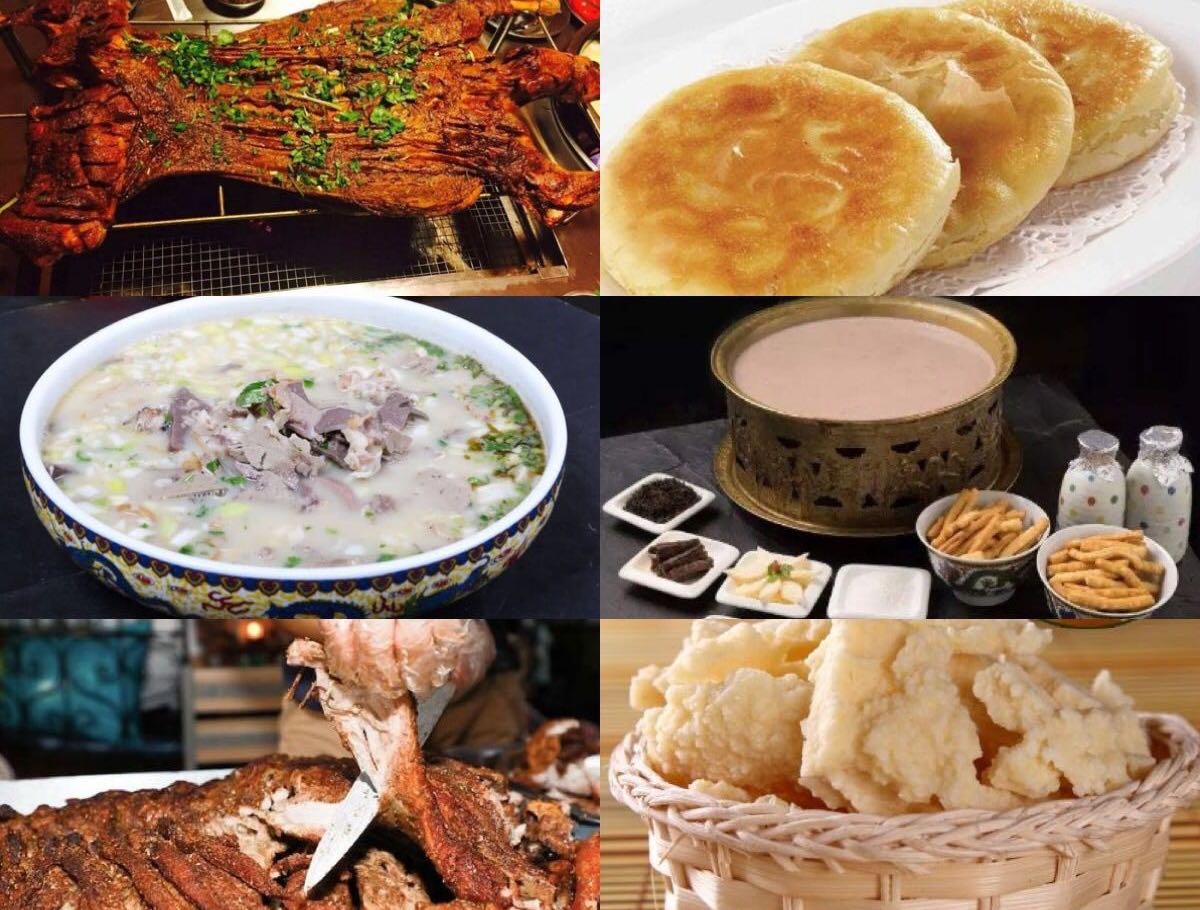
- Considering the large temperature difference between morning and evening and strong ultraviolet rays, we would advise bringing a warm jacket, long pants, sports shoes, sunglasses, a hat, and sunblock for travelers who are heading to Inner Mongolia either for grasslands or deserts.
- It is considered an offense to herdsmen if walking through a flock or herd in the grassland, so please be advised not to do so.
- It is a traditional welcome ceremony for nomad families to serve guests with a bowl of milk tea or a sliver cup of local liquor and a Hada, to show their respect to the guests. It is courteous to accept the drink and the Hada with both hands or right hand. For travelers who are not good at drinking, it is okay to take a sip only.
Related tours

5 days Splendid Lhasa Tour with Ganden Monastery
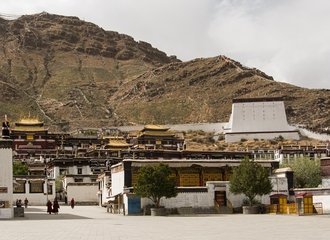
6 days Tibet classic tour
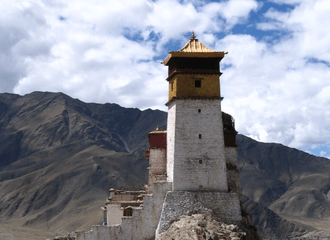
5 days Lhasa and Samye cultural exploration
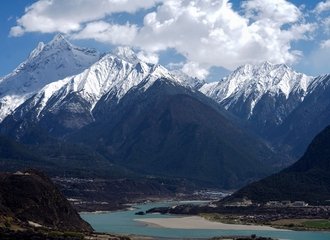
6 days Picturesque Tibet tour with Nyingchi visit
We would like a guided tour in Inner Mongolia. We would like to spend 7 days there.
In reply to We would like a guided tour… by Law (not verified)
Thanks for your comments! We would love to arrange your Inner Mongolia tour, I just sent the details to your email, please kindly take a look and feel free to share your thoughts on it.
Look forward to hearing from you back soon.
Best regards, Yuki

Inner Mongolia Travel Guide: All You Need To Know
Inner Mongolia, officially known as the Inner Mongolia Autonomous Region, is an autonomous region located in the northern part of China. It is bordered by Mongolia to the north, Russia to the northeast, and several Chinese provinces to the south, east, and west. Inner Mongolia is known for its diverse landscapes, rich cultural heritage, and unique nomadic traditions. Here’s an overview of Inner Mongolia:
- Ethnic Diversity and Culture:
Inner Mongolia is home to a significant population of ethnic Mongols, who have a distinct culture, language, and way of life. The region is a blend of Chinese and Mongolian influences. The traditional lifestyle of Mongolian nomads is still practiced by some communities, with yurts (traditional tents) used as dwellings and livestock herding being a way of life.
- Beautiful Landscapes:
Inner Mongolia features diverse landscapes, including vast grasslands, deserts, mountains, and lakes. The Ordos Desert and the Badain Jaran Desert are prominent desert areas in the region. Hulunbuir Grassland, Xilamuren Grassland, and Gegentala Grassland are popular destinations for experiencing the nomadic culture and enjoying outdoor activities.
Hohhot is the capital and largest city of Inner Mongolia. It offers a mix of modern urban life and traditional Mongolian culture. Visit the Inner Mongolia Museum to learn about the region’s history, culture, and heritage.
- Grassland Activities:
Experience nomadic culture by staying in a traditional yurt, participating in horseback riding, and enjoying traditional Mongolian food.
- Naadam Festival:
The Inner Mongolia Naadam Festival is a significant event featuring traditional Mongolian sports such as wrestling, horse racing, and archery.
- Hulun Lake and Resonant Sand Bay:
Hulun Lake is one of the largest freshwater lakes in China and offers opportunities for boating and birdwatching. Resonant Sand Bay is known for its singing sand dunes, which produce unique sounds when disturbed.
- Xanadu (Shangdu):
Xanadu, the summer capital of Kublai Khan’s Yuan Dynasty, is an ancient city with historical significance. Visit the ruins and explore its history.
- Inner Mongolia Cuisine:
Sample traditional Mongolian dishes such as roasted whole lamb and dairy products like yogurt and cheese.
- Local Festivals and Celebrations:
Besides Naadam, Inner Mongolia celebrates other traditional festivals such as the Lunar New Year and the Nadam Fair of Horchin Left Banner.
- Horseback Riding and Camel Trekking:
Explore the landscapes on horseback or take a camel trek through the deserts and grasslands for a unique experience. Inner Mongolia offers a unique blend of cultures, stunning landscapes, and memorable experiences that provide a glimpse into the nomadic way of life and the history of the region. It’s a destination that appeals to those interested in nature, culture, and adventure.
Places to Visit in Inner Mongolia
Inner Mongolia Autonomous Region in China offers a diverse range of attractions that showcase its unique culture, landscapes, and history. Here are some notable places to visit in Inner Mongolia:
Hohhot: The capital city of Inner Mongolia is a blend of modern urban life and traditional Mongolian culture. Visit the Inner Mongolia Museum and explore the city’s markets and local neighborhoods.
Hulunbuir Grassland: One of the largest and most beautiful grasslands in China, Hulunbuir offers opportunities for horseback riding, yurt stays, and experiencing the nomadic way of life.
Gegentala Grassland: This scenic grassland is known for its wide-open spaces, horse riding, and cultural performances.
Xilamuren Grassland: Located near Hohhot, Xilamuren is another popular grassland destination with yurt accommodations and various outdoor activities.
Ordos Desert: Experience the desert landscapes of Inner Mongolia in the Ordos Desert, known for its sand dunes and unique natural formations.
Badain Jaran Desert: Explore the world’s highest sand dunes and pristine desert landscapes in this remote desert area.
Hulun Lake: One of the largest freshwater lakes in China, Hulun Lake is a beautiful natural site for boating, fishing, and birdwatching.
Resonant Sand Bay: Located near the Kubuqi Desert, this area features sand dunes that produce musical sounds when touched or disturbed.
Xanadu (Shangdu): Explore the ancient ruins of Xanadu, the summer capital of Kublai Khan’s Yuan Dynasty, and learn about its historical significance.
Gegentala Grassland: Experience the unique Mongolian culture, horseback riding, and traditional performances on this picturesque grassland.
Arxan National Forest Park: Located in Inner Mongolia’s northeastern region, this park offers lush forests, hot springs, and natural scenery.
Erdos: Visit Erdos to explore the Kubuqi Desert and experience camel riding, sand sliding, and desert adventures.
Wudangzhao Monastery: Discover this historic Tibetan Buddhist monastery known for its unique architecture, sculptures, and religious significance.
Naadam Festival: If you’re visiting during July, consider experiencing the Inner Mongolia Naadam Festival, which features traditional Mongolian sports and cultural events.
Whistling Dune Bay: Marvel at the stunning sand dunes and the whistling sound they produce as the wind passes through them.
Da Zhao Temple: Located in Hohhot, this temple is a prominent Tibetan Buddhist site with impressive architecture and cultural significance.
Inner Mongolia offers a wide range of natural landscapes, cultural experiences, and historical sites. Whether you’re interested in exploring the grasslands, deserts, lakes, or traditional Mongolian culture, Inner Mongolia has something unique to offer every traveler.
Best Time To Visit Inner Mongolia The best time to visit Inner Mongolia depends on your preferences and the type of experiences you want to have. Inner Mongolia experiences distinct seasons, each offering its own attractions and activities. Here are the different seasons and their highlights:
Spring (April to June):
Spring is a pleasant time to visit Inner Mongolia as the weather gradually warms up, and the landscapes begin to bloom. The grasslands come to life with lush greenery, making it an ideal time for horseback riding and enjoying the nomadic culture. Spring is also a good time for outdoor activities like hiking and exploring natural attractions. Summer (July to August):
Summer can be warm to hot, especially in July and August. However, it is also the peak tourist season. The grasslands are in full bloom, and you can experience the vibrant traditional Naadam Festival, which features Mongolian sports and cultural events. Summer is perfect for camping, staying in yurts, and enjoying outdoor adventures like camel riding and sand sliding in the deserts. Autumn (September to October):
Autumn is a popular time to visit Inner Mongolia due to its comfortable temperatures and colorful landscapes. The grasslands retain their lush green color, and the forests begin to display vibrant autumn foliage. This is a great time for photography, hiking, and cultural experiences. Winter (November to February):
Winter in Inner Mongolia can be cold, with temperatures dropping significantly. However, it offers a unique and serene experience. If you’re interested in winter sports, some areas offer skiing and ice skating. The frozen lakes and snowy landscapes create a picturesque setting for photography and exploration. Keep in mind that the specific timing of the Naadam Festival varies each year, so if you want to experience this cultural event, be sure to check the festival dates in advance. Overall, the best time to visit Inner Mongolia depends on your interests, whether it’s experiencing traditional festivals, enjoying outdoor activities, or exploring the unique landscapes of the region.
Things to Do in Inner Mongolia Inner Mongolia offers a wide range of activities and experiences that allow you to immerse yourself in its unique culture, landscapes, and traditions. Here are some things to do in Inner Mongolia:
Explore the Grasslands: Experience the nomadic way of life by staying in a traditional yurt on the vast grasslands of Hulunbuir, Xilamuren, or Gegentala. Enjoy horseback riding, watch herding demonstrations, and savor traditional Mongolian food.
Visit the Deserts: Explore the sand dunes of the Ordos Desert and the Badain Jaran Desert. Try activities like camel riding, sand sliding, and camping under the starry desert skies.
Attend the Naadam Festival: If you visit during July, participate in or witness the Inner Mongolia Naadam Festival, which showcases Mongolian sports such as wrestling, horse racing, and archery.
Visit Xanadu (Shangdu): Explore the ruins of the ancient city of Xanadu, once the summer capital of the Yuan Dynasty under Kublai Khan. Learn about its historical significance and architecture.
Explore Cultural Sites: Visit Buddhist monasteries like Wudangzhao and Da Zhao Temple in Hohhot to experience Tibetan Buddhist culture and architecture.
Hike and Explore Nature: Explore the natural beauty of Inner Mongolia by hiking in areas like the Arxan National Forest Park. Enjoy hot springs, lush forests, and scenic landscapes.
Experience Local Cuisine: Try traditional Mongolian dishes such as roasted whole lamb, dairy products, and local specialties like “milk tea with salt.”
Birdwatching and Wildlife Viewing: Hulun Lake is a great spot for birdwatching, especially during migratory seasons. Observe unique wildlife and enjoy serene views.
Adventure Activities: Engage in outdoor activities like fishing, boating, and kayaking on Hulun Lake, or try your hand at sandboarding in the deserts.
Photography: Capture stunning landscapes, colorful festivals, and unique cultural scenes that Inner Mongolia has to offer.
Learn about Nomadic Life: Engage with local Mongolian families to learn about their traditions, livelihood, and daily activities.
Visit Hohhot: Explore the capital city, Hohhot, to experience the blend of modern life and traditional Mongolian culture. Visit museums, markets, and historic sites.
Enjoy Local Performances: Attend traditional Mongolian music and dance performances to appreciate the region’s rich cultural heritage.
Horseback Riding: Embrace the nomadic lifestyle by going on horseback riding tours in the grasslands.
Enjoy Winter Sports: If visiting during winter, some areas offer skiing, snowboarding, and other winter sports.
Inner Mongolia provides a unique opportunity to experience the ancient traditions and natural beauty of the Mongolian people while enjoying a range of outdoor and cultural activities.
How to get around in Inner Mongolia Getting around Inner Mongolia involves various transportation options that allow you to explore its diverse landscapes and attractions. Here’s how to get around in Inner Mongolia:
Train: Inner Mongolia has an extensive railway network connecting major cities and towns. High-speed trains and regular trains provide a comfortable and efficient mode of transportation between destinations.
Bus: Buses are a common and affordable way to travel within Inner Mongolia. They connect cities, towns, and rural areas, making it convenient to explore different regions.
Car Rental: Renting a car or hiring a driver can provide flexibility for exploring remote areas, especially if you’re interested in off-the-beaten-path locations. Be sure to have an International Driving Permit if required.
Taxi: Taxis are available in urban areas and can be hired for short distances or day trips. Make sure to have your destination written in Chinese or use a translation app.
Domestic Flights: If you need to cover long distances quickly, consider taking a domestic flight between major cities and airports in Inner Mongolia.
Subway: Hohhot, the capital city, has a subway system that offers convenient transportation within the city.
Biking: In some areas, biking can be a great way to explore the surroundings, especially in cities or near scenic spots.
Horseback Riding: In the grasslands, particularly around tourist areas, you can experience horseback riding as a mode of transportation and cultural immersion.
Camel Riding: In desert regions, camel riding is a unique way to navigate the sand dunes and experience the landscape.
Walking: Walking is a great way to explore urban areas and get a closer look at local life and architecture.
Local Advice: Ask locals or your accommodation for recommendations on transportation options based on your destination and preferences.
Online Maps and Apps: Use online maps and transportation apps (such as Baidu Maps) to navigate and plan routes, especially if you’re comfortable with using Chinese-language apps.
Language and Communication: Be prepared to use translation apps or carry a phrasebook, as English may not be widely spoken.
When planning your transportation in Inner Mongolia, consider factors such as the distance between destinations, your comfort level with different modes of transportation, and the convenience of each option for your itinerary.
Where to eat in Inner Mongolia
In Inner Mongolia, you’ll have the opportunity to savor traditional Mongolian cuisine, as well as Chinese dishes with local influences. Here are some places and types of eateries where you can enjoy delicious meals in Inner Mongolia:
Local Restaurants: Look for local restaurants that serve authentic Mongolian dishes, such as roasted whole lamb, dairy products, and staple foods like buuz (steamed dumplings) and budaowan (stew).
Yurt Stays: If you’re staying in the grasslands, many accommodations offer meals as part of the experience. Enjoy home-cooked Mongolian meals prepared by local families.
Food Streets and Markets: In cities like Hohhot, you’ll find food streets and markets where you can sample a variety of Mongolian and Chinese dishes, as well as street food.
Hot Pot Restaurants: Inner Mongolia has its own unique style of hot pot, featuring lamb and other local ingredients. Try this hearty and flavorful dish at local hot pot restaurants.
Local Snacks and Desserts: Explore local snack stalls and shops for treats like dried yogurt, milk tea, and pastries.
Dining at Tourist Sites: At popular tourist sites, you may find dining options that offer both convenience and a taste of the local cuisine.
Horse Milk: For an adventurous culinary experience, you can try traditional Mongolian horse milk (airag).
Ask Locals for Recommendations: Don’t hesitate to ask locals for their favorite dining spots. They can provide valuable insights into where to find the best and most authentic food.
Local Festivals and Events: If you’re visiting during festivals or events, you might have the chance to enjoy traditional Mongolian dishes and specialties that are prepared for the occasion.
When dining in Inner Mongolia, be sure to try traditional Mongolian dishes like roasted lamb and dairy products, as well as other local specialties. Exploring local eateries and markets will give you an authentic taste of Inner Mongolia’s culinary culture.
Famous street stalls in Inner Mongolia Inner Mongolia’s street food scene offers a unique blend of Mongolian and Chinese flavors. While specific street stalls may vary over time, here are some famous street food items that you might find in Inner Mongolia:
Grilled Lamb Skewers: Tender pieces of marinated lamb are skewered and grilled over an open flame, creating a flavorful and aromatic snack.
Stuffed Pancakes (Huoshao): These savory pastries are often filled with minced meat, vegetables, and spices, making them a popular and convenient street food option.
Mongolian-style Roasted Whole Lamb: In some areas, you might find stalls that specialize in roasting whole lambs over an open fire. This iconic Mongolian dish is a must-try.
Budaowan (Stew): A hearty stew featuring various ingredients such as lamb, vegetables, and noodles, often cooked in a large pot.
Mongolian-style Noodle Soup: Enjoy a warm bowl of noodles in a savory broth, sometimes with meat or vegetable toppings.
Grilled Naan Bread: Soft and fluffy naan bread is grilled and served with various toppings, creating a delicious and filling snack.
Milk Tea: Sample traditional Mongolian milk tea, often made with milk, tea leaves, and sometimes a touch of salt.
Dried Yogurt (Suan Nai): These bite-sized yogurt treats are a popular local snack, offering a unique combination of tangy and sweet flavors.
Roasted Corn: Corn on the cob is grilled to perfection and brushed with seasonings, creating a flavorful and satisfying snack.
Fried Dough Twists (Mahua): Crispy and twisted dough snacks are deep-fried and often coated with sesame seeds or sugar.
Bing Tanghulu: Skewered fruits, typically hawthorn berries, are coated in a layer of hardened sugar syrup, creating a sweet and tangy treat.
Local Sweets and Desserts: Look for stalls offering a variety of traditional Mongolian sweets made from dairy products, nuts, and grains.
Keep in mind that street food stalls may be more prevalent in bustling markets, food streets, and areas with a high concentration of tourists or locals. Exploring these stalls will allow you to experience the vibrant and diverse flavors of Inner Mongolia’s street food culture.
Where to stay in Inner Mongolia
Inner Mongolia offers a range of accommodation options to suit different preferences and budgets. Depending on your travel style and the areas you plan to visit, here are some suggestions on where to stay in Inner Mongolia:
Hohhot: As the capital city of Inner Mongolia, Hohhot has a variety of accommodation options, including luxury hotels, mid-range hotels, guesthouses, and budget hostels. Staying in Hohhot provides convenient access to attractions, dining, and transportation.
Grasslands: If you’re looking to experience the traditional Mongolian way of life, consider staying in a yurt on the grasslands. Many grassland areas offer yurt accommodations, allowing you to immerse yourself in the nomadic culture and enjoy scenic views.
Desert Camps: In desert regions like the Ordos Desert, you can find desert camps that offer unique accommodations, allowing you to sleep under the stars and experience the desert environment.
Tourist Areas: In popular tourist destinations such as Xanadu (Shangdu) or near attractions like Hulunbuir Grassland, you’ll find a range of accommodations to choose from, including hotels and guesthouses.
Local Inns and Guesthouses: In smaller towns and rural areas, consider staying at local inns and guesthouses to experience a more authentic and personalized stay.
Online Booking Platforms: Use online booking platforms to compare prices, read reviews, and find accommodations that match your preferences.
Local Recommendations: Ask locals or check with tourism offices for recommendations based on your interests and the areas you plan to visit.
When choosing accommodation in Inner Mongolia, consider factors such as your budget, preferred amenities, proximity to attractions, and the type of experience you want to have. Whether you’re interested in exploring the city, staying on the grasslands, or experiencing the desert, Inner Mongolia has options to cater to a variety of travel preferences.
Travel Tips Inner Mongolia Traveling to Inner Mongolia can be an exciting and rewarding experience. To make the most of your trip, here are some travel tips to keep in mind:
Weather Considerations: Inner Mongolia experiences a wide range of temperatures throughout the year, from hot summers to cold winters. Pack accordingly and check the weather forecast before your trip.
Cultural Sensitivity: Respect the local customs and traditions of the Mongolian people. When visiting monasteries or interacting with locals, dress modestly and be mindful of cultural practices.
Language: While Mandarin Chinese is the official language, some areas in Inner Mongolia have Mongolian-speaking communities. Basic Mandarin phrases can be helpful, especially in more remote locations.
Altitude: Some areas of Inner Mongolia are at high altitudes. If you’re traveling to higher elevations, take precautions to acclimatize gradually to avoid altitude sickness.
Health and Hygiene: Drink bottled or boiled water, especially in rural areas. Carry hand sanitizer and tissues for hygiene purposes.
Accommodation: Book accommodations in advance, especially during peak travel seasons. Consider staying in a yurt on the grasslands for a unique experience.
Transportation: Plan your transportation in advance, especially if you’re traveling to remote areas. Trains and buses are common modes of transport within the region.
Local Cuisine: Embrace the opportunity to try traditional Mongolian dishes, but also be prepared for different flavors and ingredients. If you have dietary restrictions, communicate your preferences clearly.
Money Matters: Have local currency (Chinese Yuan) on hand, especially when visiting rural areas where credit cards may not be widely accepted.
Travel Insurance: It’s recommended to have travel insurance that covers medical emergencies, trip cancellations, and other unexpected events.
Internet and Communication: Internet access and mobile network coverage may vary, especially in remote areas. Consider getting a local SIM card for data access.
Photography: Always ask for permission before taking photos of people, especially in more intimate or traditional settings.
Respect Nature: Whether you’re exploring the grasslands, deserts, or other natural areas, be mindful of the environment and follow Leave No Trace principles.
Local Advice: Seek advice from locals, guides, or your accommodation about the best places to visit, local customs, and practical tips.
Travel Itinerary: Plan your itinerary to include a mix of urban and rural experiences, cultural encounters, and outdoor activities to get a well-rounded experience of Inner Mongolia.
By respecting the local culture, preparing for the weather, and embracing the unique opportunities Inner Mongolia offers, you can have a memorable and enriching travel experience in this fascinating region.
You might also enjoy:
Houayxay travel guide: all you need to know, risaralda travel guide: all you need to know, wakayama travel guide: all you need to know, exploring lääne-viru county: estonia’s hidden gem, leave a comment cancel reply.
Your email address will not be published. Required fields are marked *
Save my name, email, and website in this browser for the next time I comment.
17 things to know before traveling to Mongolia

Aug 20, 2023 • 7 min read

Use these tips on health, safety and etiquette to plan your trip to Mongolia Henn Photography / Getty Images
A land defined by boundless steppes, blue skies and roving nomads, Mongolia is perfectly set up for adventure and cultural immersion. Memorable experiences are a given, but travel in the world’s least-densely-populated country comes with its own challenges, so it pays to level-up on your Mongolia knowledge before you come.
On my own Mongolia adventures, I’ve wild-camped in a lightning storm; got queasy on fermented horse milk; broken down multiple times on epic drives ; had my pocket picked; crashed a Kazakh wedding; been thrown from two horses; and – perhaps my biggest faux pas – tried to cross part of the Gobi desert in a Toyota Prius. (Spoiler: I got stuck!)
Experience is the mother of wisdom, so here are some tips to help you make fewer mistakes on your own trip. However you choose to explore this fascinating country, remember that Mongolians are famously hospitable and predisposed to help strangers in need – even if things do go wrong, someone will eventually put you back on the right track.

1. Organize your tour well before you travel
Mongolia’s travel season is fleeting, stretching from late May to late August, so the best drivers, guides and vehicles are soon snaffled up. In the past, it was possible to rock up to Ulaanbaatar in summer and ask around at guesthouses to find space on a tour, but with the suspension of the Trans-Mongolian Railway, fewer travelers are passing through. Booking tours ahead is the way to go.
2. Don’t be too ambitious with your Mongolia itinerary
A common mistake is to try to see too much of Mongolia in one go, which can turn your trip into a wearisome, bone-rattling driving safari. It’s better to focus on just one area of the country, or schedule a stop of at least two nights in each destination so you can slow down and enjoy the majesty and serenity of the Mongolian landscape.
3. Book domestic travel tickets through local Mongolian agencies
Schedules for domestic flights and rail travel often change at the last minute. If you book through a local travel agent in Mongolia, they’ll be able to sort you out if your flight is canceled or delayed. If you miss a connection or are running late, a good tour operator might even be able to hold the plane for you for an hour or so.

4. If you plan to drive yourself, avoid July and August
The summer travel season from July to August coincides with the time when the grassy tracks of the steppe become waterlogged and the risk of getting stuck rises exponentially. If you intend to drive yourself, it’s better to come in the shoulder season in June or September for firmer ground. If you come at the height of summer, stick to the paved roads that fan outwards from the capital, or hire a car and a local driver who knows the local driving conditions.
5. Download podcasts and audiobooks for those long road trips
Mongolia is three times the size of France , and most roads are bumpy tracks, which translates to low average speeds even in a modern 4WD. Expect to spend hours bouncing along through vast, unchanging landscapes – beautiful but somewhat repetitive. This terrain is crying out for a good soundtrack; preload your audio player with good tunes or a selection of audiobooks or podcasts to help the miles pass.
6. Bring sanitary supplies and medication
While you can pick up most health essentials in the capital, once you’re out on the steppe you’ll find that personal sanitary supplies and medication are much harder to find. Make space in your pack and come prepared with everything you need.
7. Spice up your mutton with condiments
Ulaanbaatar has a buzzing dining scene, but out in the wilds, you’ll subsist mostly on mutton dumplings (buuz) , fried mutton pancakes (khuushuur) , mutton with pasta chunks (tsuivan) , or just plain boiled mutton (makh) . On a long expedition this can get boring, so remember to pack a bottle of sriracha, horseradish, gochujang, piri-piri sauce, or any other condiment that you like to use to zhush up your food.
8. Boil or purify water from streams and lakes
Rural Mongolia may look pristine, but even crystal clear water can contain microbes, contaminants or impurities. Boiling water for at least one minute can kill most harmful microorganisms, or you can use water purification tablets or a portable filtration system to cut down on energy use.
9. Pack camping gear to save money (and if heading out west)
In Mongolia’s most popular destinations, you can stay overnight in fixed ger (yurt) camps set up for tourists, but in remote western areas such as Bayan-Ölgii province, it’s a good idea to carry your own tent and camping gear, as ger camps are few and far between. Ulaanbaatar is full of shops selling outdoor equipment, in case you didn’t bring your own gear from home.
10. Bring gifts when visiting nomad families
It’s customary to bring something for your hosts when staying with local people in Mongolia. Popular gifts include food, candies, cigarettes and bottles of alcohol. Taking along souvenirs or photographs from your own country is another great way to foster cultural exchange.
11. Climb a hill to get a mobile phone signal
In recent years, cell phone coverage in Mongolia has become much more widespread, with fewer dead zones, though there are still some off-grid spots. If you’re in the countryside and don’t have a signal, usually all you need to do is climb the nearest hill and you’ll be back online.
12. Think twice about riding that horse
Falling off a horse is one of the most common accidents to befall foreigners in Mongolia. If you are keen to get in the saddle, make sure your travel insurance covers it, and consider getting some practice before you leave home. Be extra careful in remote areas such as the Gobi , as horses tend to be more skittish, often a result of mixing different herds to make up the numbers for the tourist season.

13. Observe ger (yurt) etiquette
There are special rules for staying in Mongolia’s most famous form of accommodation. Inside a ger , it’s polite to wait until you’re seated and have been served tea before engaging in conversation with your hosts. It’s also disrespectful to throw trash into the central stove; instead, place it in front and your host will dispose of it.
14. Be vigilant when walking around central Ulaanbaatar
While Mongolia is generally a safe place to travel, tourists have been known to get robbed in Ulaanbaatar. Back in 2012, I had my wallet picked from my back pocket outside the Ulaanbaatar Department Store – a rookie mistake! Also take extra care when crossing the street – Ulaanbaatar is choked with cars and pedestrians get no special treatment from motorists.
15. Use official taxis after dark
In Ulaanbaatar there are two types of taxis – official taxis and the unofficial kind, essentially regular cars prowling the streets for fares. While unlicensed cabs are generally safe by day, you should stick to official taxis at night. Two useful taxi apps are UBCab and ABA taxi Mongolia , each with their own registered drivers.
16. Use what3words to find places and points of interest
Mongolia has adopted the popular what3words navigation system, where locations are mapped using unique combinations of three words. This makes it easier to locate sites and attractions in a country with few named roads and landmarks. The current edition of the Lonely Planet Mongolia guidebook lists what3words locations next to every point of interest.
17. Get a GPS tracker device
The vehicle version of the hikers’ GPS device, a GPS tracker will provide an extra level of safety when adventuring into the great Mongolian emptiness. If you drive with a tracker, any tour company or support office in Ulaanbaatar can locate your whereabouts if you get lost or your vehicle runs into difficulties.
Explore related stories

Jul 8, 2024 • 8 min read
Here’s a break-down of how to best navigate Paris during the 2024 Olympic and Paralympic Games

Jun 26, 2024 • 5 min read

Jun 20, 2024 • 6 min read

Jun 15, 2024 • 7 min read
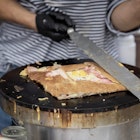
Jun 14, 2024 • 7 min read

May 30, 2024 • 6 min read

May 29, 2024 • 4 min read

May 14, 2024 • 10 min read

May 9, 2024 • 6 min read

May 7, 2024 • 6 min read
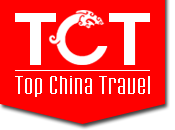
- China Tours
- Top 10 Tours
- Group Tours
- Tailor-made
- Destinations
- Classic China Tours
- Scenic China Tours
- China Cultural Tours
- Yangtze River Cruises
- Silk Road Adventure
- Tibet Tours
- Yunnan Tours
- Beijing Tours
- Shanghai Tours
- Guilin Tours
- Chengdu Tours
- Zhangjiajie Tours
- China Group Tours 2023
- Beijing Group Day Tours
- Shanghai Group Day Tours
- Guilin Group Day Tours
- Hong Kong Group Day Tours --> All Asia Tours Privacy Statement
Our license Number: L-GX-CJ00001
Copyright 2004 All Rights Reserved Top China Travel

Hulunbuir Grassland
Located in the northeast of Inner Mongolia , Hulunbuir Grassland is one of the top famous grasslands in the world with natural grassland coverage of about 80%. Its lush plants, unpolluted air, flocks and herds, unique ethnic culture, and Genghis Khan history fascinate and attract people for a visit.
Scroll down to find key travel info and things to do on Hulunbuir Grassland, or contact our Inner Mongolia expert for more information.
Basic Facts about Hulunbuir Grassland
- Chinese: 呼伦贝尔大草原 Hūlúnbèi'ěr Dàcǎoyuán / hoo-lwnn-bay-urr daa-tsao-ywen/ 'Hulunbuir Grassland'
- Area: 100,000 sq km (38,610 sq mi)
- Recommended visit duration: 1–2 days
- Popular activities: boundless grassland, flocks and herds, wild animals and flowers, horseback riding
- Suited to: anyone, especially nature and culture lovers
Why Visit Hulunbuir Grassland
A vast region with beautiful scenery, lush plants, over 3,000 crisscrossing rivers and 500 lakes dotted around, Hulunbuir Prairie is like a huge, green picture scroll, which gives you boundless views. It is the best-preserved grassland at present in China and has more than 120 kinds of pasture, such as alfalfa and wheat grass, hence it is known as " The Grass Kingdom ".
With the most plentiful and excellent pastures in China, Hulunbuir also has the name " The Purest Prairie " since there is hardly any pollution there. Its produce, like meat, milk, leather, wool, and other animal products, are favored by people both domestically and in other countries. It's the place where Genghis Khan was born and is also a famous tourist area.
With the irrigation of thousands of rivers, the prairie presents itself as a green carpet underneath the blue sky and white clouds, with warblers, flocks and herds, and other wildlife all over the prairie. You can ride on camels and horses, watch wrestling and horse racing, eat a 'lamb feast' with a "grassland flavor", and enjoy an ethnic bonfire party in the evening — the unique lifestyle of Mongol nomads can be fully appreciated.
Hulunbuir Grassland Climate and Best Times to Visit
Located in the northeast corner of China, Hulunbuir has a temperate continental climate and very low temperatures in winter.
Hulunbuir Grassland is best for a grassland-activities visit from June to September. July and August are the two best months when the grasslands are lushest and most suitable for horseback riding, fishing in the hinterland of the prairie, or boating on the Hulun and Buir lakes.
Hulunbuir's grasses normally turn yellow in early September , but it is a good time to appreciate red and yellow leaves in the eastern forest area of the prairie.
A winter visit is best from November to mid-February to attend the Winter Nadaam or go skiing.
Special Note for Hulunbuir Grassland Summer Visits
- The temperature difference between day and night in Hulunbuir is great, so long-sleeved clothes for the evenings is highly recommended even when you are touring in the hottest summer months.
- From July, there are more mosquitoes on the grassland. Please bring mosquito repellent .
The Legend of Hulunbuir
Hulunbuir Grassland is named after Hulun Lake and Buir Lake .
According to the legend, a brave Mongolian tribe had a blessed couple. The girl, named Hulun, was good at singing and dancing and was endowed with both beauty and talent, while the boy, called Buir, was extremely strong and was talented in riding and shooting. When they fought against a demon for love and the safety of the prairie, the girl turned into a lake and drowned the demon, then the boy jumped into the lake for the girl and another lake was formed, thus creating the two lakes of Hulun and Buir.
Festivals on Hulunbuir Grassland
Aobao festival.
Aobao is one of the most celebrated sacrificial ceremonies in Mongolia. Always held in the mountains or hills in the May to August period, stones are heaped into a solid conical tower with a long rod inserted into the top and colorful livestock wool and scripture cloths tied onto the head of the rod.
The aobao ('heap of stones') is surrounded by more stones with burning cypress joss sticks. Branches are inserted into the ground beside it with offerings of a whole sheep, koumis (fermented equine milk), butter, and cheese, which everyone enjoys afterwards.
The festival is for local herdsmen to pray for a prosperous harvest and safety around the aobao.
Nadaam Festival
Nadaam Festival is held twice a year on Hulunbuir Grassland . Summer Nadaam is around late July and Winter Nadaam is in late December. The festival shows off Mongolian culture brilliantly in its different aspects: singing and dancing, sports, ethnic dress, and Mongol food. Horse racing, wrestling, and archery are the three 'manly sports' (or nadaams) for the Mongolians.
Wrestling is one of the grandest athletic activities for Mongolian people, which 700 years ago become an event in the Nadaam Festival.
The horse and bow were important hunting tools and war weapons for Mongolian peoples since ancient times. The Mongolians are known for being good at horse riding and archery , which about 700 years ago began their development as Nadaam sports.
- 5-Day Inner Mongolia Grass & Sand
- 4-Day Authentic Mongolian Nomad Experience Tour
4 Things to Do on Hulunbuir Grassland
1. enjoy a warm welcome ceremony.
Before you enter a tribal settlement, the herdsmen will first toast you with wine, welcome you with songs and dances, and present you with a hada (a Tibetan ceremonial silk scarf).
2. Discover Various Grassland Activities
The wonderful performances of horse racing, wrestling, and archery will bring you a sense of the skill and strengths of the Mongol people. Aobao, the shamanist cultural ceremony, shows you the Mongols' traditional way of sacrifice. Paying a visit to a nomad's yurt, you can listen to their grassland stories (contact us for a guide who can translate for you).
You can also take a horseback ride on the endless grassland or just relax on the giant carpet of green, watch the clear blue sky, and breath the fresh air.
3. Taste the Traditional Mongolia Food
Do not miss the chance to taste some local favorites such as roasted mutton leg, roasted whole lamb and other traditional ethnic foods including milk tea, naigan (dried milk), naipi (the skin on boiled milk), cheese, and roasted grains.
4. Join in an Awesome Bonfire Party
A bonfire party is another way that the local Mongols show their hospitality to guests. During the party, locals wear traditional costume while they sing and dance around the bonfire. Join in the party for an unforgettable grassland experience.
Cannot wait to visit Hulunbuir Grassland? Contact us and we'll tailor-make an Inner Mongolia grassland tour for you.
Hulunbuir Grassland Transportation
The heartland of Hulunbuir Grassland is only 40 minutes' drive from Hailar District of Hulunbuir City in Inner Mongolia. You can reach Hailar either by flight or train.
Hailar Dongshan Airport is only 7 kilometers (4 miles) from the city, with flights to Beijing , Hohhot , Xilinhot, Shenyang , Harbin , etc.
Bullet trains are not available in Hulunbuir. You can take a normal speed train from Beijing, Harbin, Hohhot, or Baotou to Hailar which takes 10–30 hours.
No matter whether you arrive by flight or train, when traveling to the grassland area, a private transfer with an English-speaking guide service is highly recommended for a hassle-free experience.
Staying in a Hulunbuir Grassland Yurt
Hulunbuir Grassland offers Mongolian yurt accommodations to provide you an experience of the traditional way of nomadic life. You may find flocks grazing around your yurt, and the bleeting early in the morning may wake you up. In the evening, the pristine starry night provides the feeling that you are in the center of the galaxy.
However, the condition of yurt accommodation is quite basic. Toiletry supplies are not provided, and you need to bring your own. Hot water does not last long due to the use of solar energy water heaters, and so you may need to limit yourself to a quick shower.
The Mongolia yurts are in high demand during summertime and it is wise to book as early as possible. Contact us for a booking.
Touring Hulunbuir Grassland with China Highlights
When traveling on such a vast grassland with exotic scenery and peoples to discover, you may need a reliable travel agent to assist you with the planning and tour guiding. We would be happy to tailor-make a memorable Hulunbuir Grassland tour for you. Just tell us your travel needs .
Here are our most popular Inner Mongolia tours for inspiration:
- 5-Day Inner Mongolia Grass & Sand with Nomadic Life Experience
- 6-Day Inner Mongolia Wild Heartlands with Hiking and Camping
- 8-Day Hohhot–Ordos Tour with Hiking, Camping, and Culture
You Might Like to Read
- Xilamuren Grassland
- Huitengxile Grassland
- 2-Week Private China Tour: Beijing–Xi'an–Lhasa-Shanghai
- 12-Day China Silk Road Tour from Xi'an to Kashgar
- 11-Day China Classic Tour
- 14-Day China Natural Wonders Discovery
- 15 Best Places to Visit in China (2024)
- Best (& Worst) Times to Visit China, Travel Tips (2024/2025)
- How to Plan a 10-Day Itinerary in China (Best 5 Options)
- 8 Days in China: Top 15 Tours and Itineraries (2024/2025)
- China Weather in January 2024: Enjoy Less-Crowded Traveling
- China Weather in February 2024: Places to Go, Costs, and Crowds
- China Weather in March 2024: Destinations, Crowds, and Costs
- China Weather in April 2024: Where to Go (Smart Pre-Season Pick)
- China Weather in May 2024: Where to Go, Crowds, and Costs
- China Weather in June 2024: How to Benefit from the Rainy Season
- China Weather in July 2024: How to Avoid Heat and Crowds
- China Weather in August 2024: Weather Tips & Where to Go
- China Weather in September 2024: Weather Tips & Where to Go
- China Weather in October 2024: Where to Go, Crowds, and Costs
- China Weather in November 2024: Places to Go & Crowds
- China Weather in December 2024: Places to Go and Crowds
Get Inspired with Some Popular Itineraries
More travel ideas and inspiration, sign up to our newsletter.
Be the first to receive exciting updates, exclusive promotions, and valuable travel tips from our team of experts.
Why China Highlights
Where can we take you today.
- Southeast Asia
- Japan, South Korea
- India, Nepal, Bhutan, and Sri lanka
- Central Asia
- Middle East
- African Safari
- Travel Agents
- Loyalty & Referral Program
- Privacy Policy
Address: Building 6, Chuangyi Business Park, 70 Qilidian Road, Guilin, Guangxi, 541004, China
- Car Rentals
- Airport Transfers
- Attractions & Tours
- Flight + Hotel
- Destinations
- Trip.com Rewards

Inner Mongolia

Trip.Best: Inner Mongolia

Popular Best Things to Do in Inner Mongolia
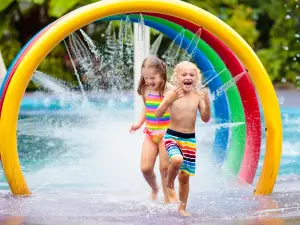
Top 7 Family-friendly Attractions in Inner Mongolia

Popular Summer Outings in Inner Mongolia

Top 9 Night Attractions in Inner Mongolia

Top 7 Hot Springs in Inner Mongolia
Inner mongolia travel guide, popular destinations.

Things to do in Inner Mongolia

Ih Juu Temple
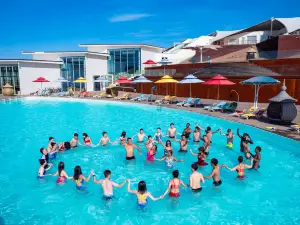
Whistling Dune Bay (Xiangshawan)

Wulan Butong Tourist Area
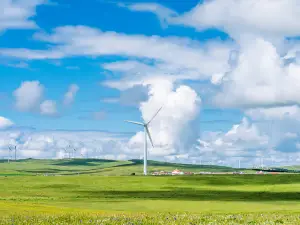
Huitengxile Grassland
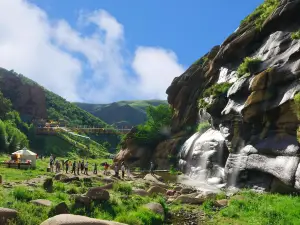
Huitengxile Huanghuagou Pasture Scenic Area
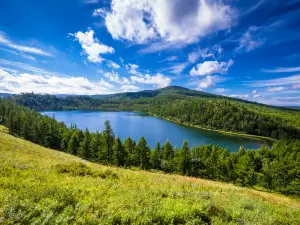
Arxan National Forest Park

Hulunbuir Grasslands
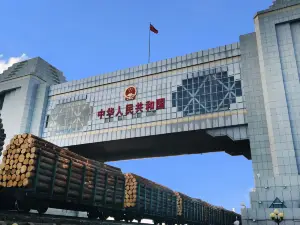
Manzhouli Guomen Scenic Area

man zhou li shi zhong e bian jing lv you qu
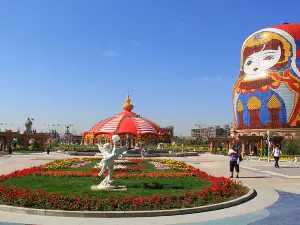
Manzhouli Matryoshka Scenic Area
Where to stay, hulunbeier huhe noor hotel, namuwildluxurycamp, yidai tianjiao mongolia tribe, renhe hotel (jianguo road), lotus hotel (lotus resort), hulunbergenhexi ukijatirazi camp, howard johnson domando plaza, yunxia pastoral hotel, nuojin hotel, blue flag prairie felt room resort, header baotou hotel, sailungaidi hotel, what to eat.
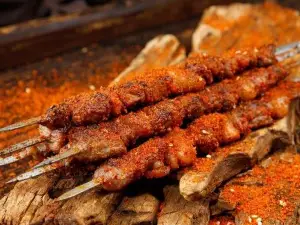
呼和浩特香格里拉大酒店·馨咖啡海鮮自助
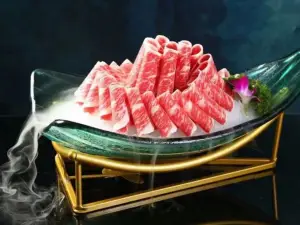
額爾敦傳統涮(公園西路店)

額爾敦手扒肉(烏蘭察布東街店)
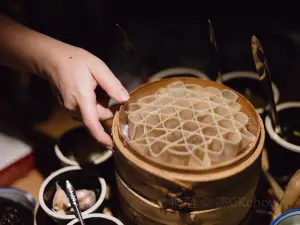
Half an Acre Land · Millet Noodle King (May 4th Commercial City Store)

格日勒阿媽奶茶館(市政府店)
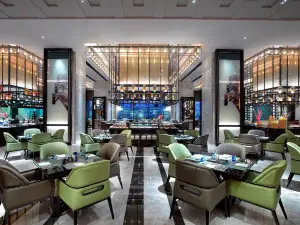
富力萬達文華酒店·海鮮自助
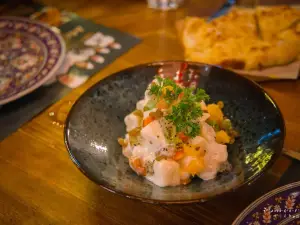
Yue Chinese Restaurant
Inner mongolia moments: through travelers' eyes.

Other Recommended Cities
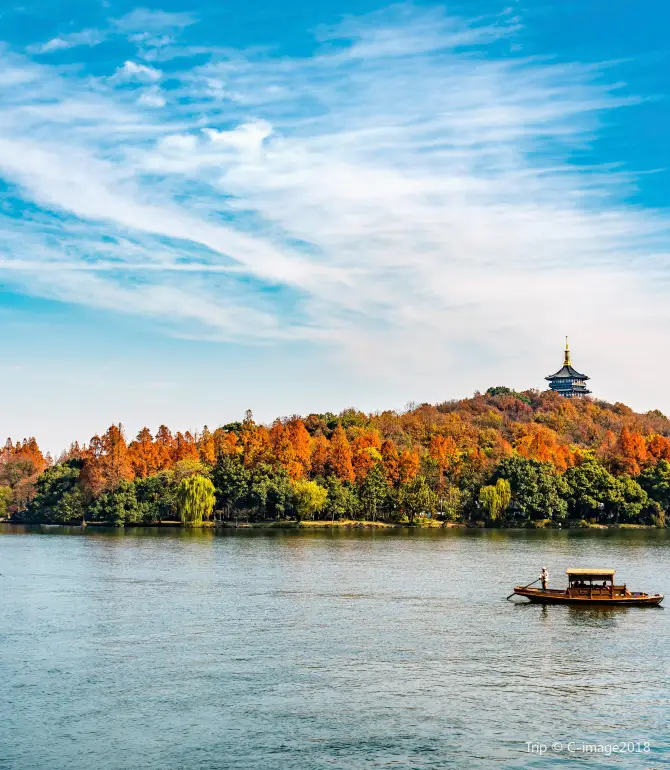
Popular Types of Attractions in Inner Mongolia
Popular attractions in inner mongolia, popular ranked lists, popular restaurants in inner mongolia, recommended attractions at popular destinations, popular trip moments, popular travel types.
- Customer Support
- Service Guarantee
- More Service Info
- Website Feedback
- About Trip.com
- Terms & Conditions
- Privacy Statement
- About Trip.com Group
Other Services
- Investor Relations
- Affiliate Program
- List Your Property
- Become a Supplier
- 86-19138970032

- Beijing Xian Tours
- Shanghai Beijing Tours
- Hong Kong Guilin Tours
- Hangzhou Suzhou Tours
- Kunming Lijiang Tours
- Shanghai Yangtze Cruise Tours
- Chengdu Tibet Tours
- More Short Stay Tours
- China Tours in January
- China Tours in February
- China Tours in March
- China Tours in April
- China Tours in May
- China Tours in June
- China Tours in July
- China Tours in August
- China Tours in September
- China Tours in October
- China Tours in November
- China Tours in December

- High Speed Trains
- China Yangtze Cruise Tour
- Photography
- Desert Adventure
- Ethnic Villages
- Biking Tours
- Kung Fu Tours
- Heritage Sites Exploration
- China Spring Tours
- China Summer Tours
- China Autumn Tours
- China Winter Tours
Notice! 2024 available cruise routes include 4~5 days Chongqing-Yichang(most classic) and 11~12 days Chongqing-Yichang-Shanghai(limited).

- Best-value Yangtze Cruises
- Top Family-friendly Cruise Ships
- Top 3 Luxury Yangtze River Cruises
- Yangtze River Highlights
- Yangtze River Cruise Routes
- Upstream or Downstream?
- Dining & Drinking
- Accommodations
- On-board Activities
- Yangtze Cruise Booking Steps

- Inner Mongolia

- Fanjingshan
- How to Plan Your First China Tour
- How to Plan Beijing Tour
- How to Plan Xian Tour
- How to Plan Shanghai Tour
- How to Plan Guilin Tour
- How to Plan Sichuan Tour
- How to Plan Family Tour
- 2024 China Travel Ideas
- Best Time to Visit China
- What to Pack for Your China Journey
- Make Payment in China
- Updated China Travel News
- Ultimate Chinese Visa Guide
- Chinese Visa Types
- Chinese Visa Requirements
- Do I Need a Visa for China
- Chinese Visa Application
- Chinese Visa Exemptions
- 144-hour Visa Free
- Shenzhen Visa on Arrival
- Hainan 30-day Visa Free
- Embassies & Consulates
- Invitation Letter
- Useful Visa FAQs & Tips
- Entry Regulations
- Baggage Allowance
- Customs Declaration
- Exit Regulation
- How to Book Train Tickets
- How to Collect Train Tickets
- How to Cancel & Alter Train Tickets
- How to Read Train Tickets
- China High Speed Train Types
- Seats Class & How to Choose
- Friendly Facilities on the Train
- The Train Station Departure Process
- Available Food and Drinks on the Train
- Western Toilets on the Train
- Luggage Racks & Baggage Allowance
- Beijing Train Stations
- Shanghai Train Stations
- Guilin Train Stations
- Xian Train Stations
- Chengdu Train Stations
- Hong Kong West Kowloon Railway Station
- Beijing - Xian
- Beijing - Shanghai
- Guangzhou - Shanghai
- Shenzhen - Shanghai
- Chengdu - Xian
- Shanghai - Hangzhou
- Shanghai - Xian
- Chengdu - Chongqing
- Kunming - Lijiang
- Beijing Capital International
- Beijing Daxing International
- Shanghai Pudong International
- Shanghai Hongqiao International
- Guangzhou Baiyun International
- Hangzhou Xiaoshan International
- Chengdu Tianfu International
- Chengdu Shuangliu International
- Xian Xianyang International
- Shanghai - Beijing
- Hong Kong - Shanghai
- Guangzhou - Beijing
- Chengdu - Lhasa
- Shanghai - Guilin
- Shanghai - Sanya
- Travel in Spring Season
- Travel in Summer Season
- Travel in Autumn Season
- Travel in Winter Season
- Weather in January
- Weather in February
- Weather in March
- Weather in April
- Weather in May
- Weather in June
- Weather in July
- Weather in August
- Weather in September
- Weather in October
- Weather in November
- Weather in December
- Top 10 China Destinations
- Top 15 Things to Do
- China World Heritage Sites
- Top 10 Best Natural Beauties
- Top 10 Museums in China
- Top 10 Old Towns & Villages
- Five Great Mountains in China
- Top 10 Monasteries & Temples
- Top 10 Ski Resorts
- Top 10 Beautiful Lakes in China
- 7 Best Beaches in Sanya
- Top 6 Beautiful Waterfalls
- Panda Volunteering
- Having fun on Ice and Snow Festival
- About Us Who We Are Our Team Why Travel with Us Feedback & Reviews Travel Stories Travelers' Gallery Payment Guide Customer Support Contact Us
- Tour Experiences
Destinations
- Travel Guide
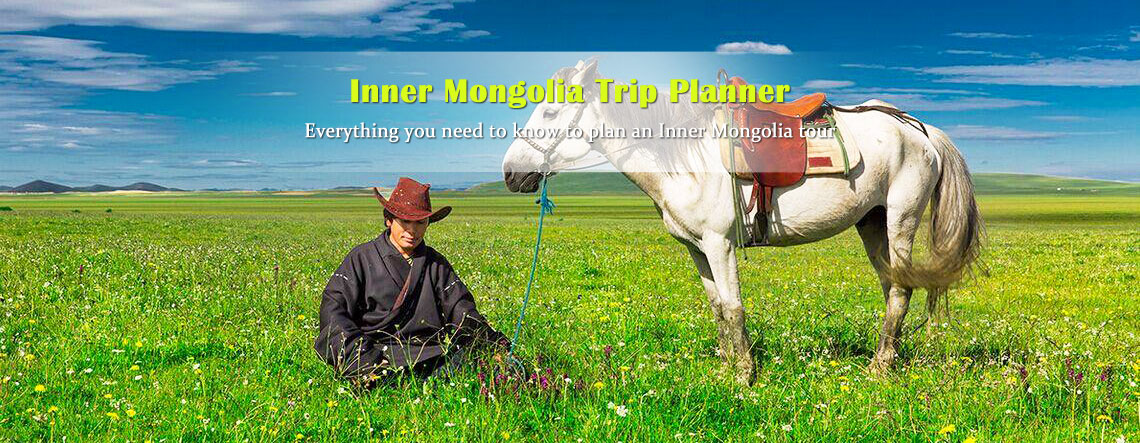
How to Plan a Trip to Inner Mongolia | Inner Mongolia Trip Planning Guide 2024
Since the super large Inner Mongolia in northern China is advantageous for boasting a large amount of diverse and excellent idyllic grasslands, wild desert adventure, interesting Mongolian nomadic tribe and imperial historical culture, etc., how to plan a worry-free and memorable trip to Inner Mongolia to enjoy its highlights as many as possible? Here, our ultimate Inner Mongolia trip planning guide will help you know clearly about every aspect, like the best time to visit, how to travel to & around, where to discover, what to do, how many days to arrange, where to stay, and more useful travel information and tips. Check all them at below to start your planning of the Inner Mongolia tour 2024/2025 !
Inner Mongolia Weather & Best Time to Go
The widely spanning Inner Mongolia has cool summer and cold winter and also big temperature drops from day to night. Weather in the eastern part also usually differs a lot from that in the western part. For the entire prefecture, July is the hottest month, while January is the coldest one. And there is a little and uneven rainfall. But sunshine is abundant for a need of sunblock.
To travel in Inner Mongolia, you need to know the best time of different regions. Briefly divided into the east, middle and west parts. Usually, the best time to enjoying grasslands is from June to September or early October, which is various for different areas. Late July to early August is the event for the grand Naadam Festival of Mongolian people. And for visiting deserts there, spring to autumn is better but avoid too hot summer. And for visiting urban cities, it is usually suitable all around the year, especially April to October.
Below are the recommended best time to visit the popular destinations in Inner Mongolia for reference.
- Hohhot, Ordos, Baotou & Ulanqab - May to October for most highlights, usually June to September for grasslands; May, June, September and October is best for Kubuqi Desert;
- Hulunbuir - May to September for Hulunbuir Grassland and other major sightseeing; December to February is great for the forest snow scenery; December is best to enjoy the Winter Naadam Festival;
- Badain Jaran Desert - spring, autumn & winter; especially June, September and October;
- Ejina - late September to middle October for fabulous golden populus euphratica forest photography;
- Arxan - all year round; flowery spring, emerald & cool summer, splendid colorful winter and snow-covered winter with ski field and hot spring; But winter is very cold;
- Xilingol - May to September;
- Chifeng & Tongliao - summer and autumn, especially July and August for grasslands and lake view;
- Bayannur - summer and autumn.
Check more about Inner Mongolia Weather & Best Time to Go .
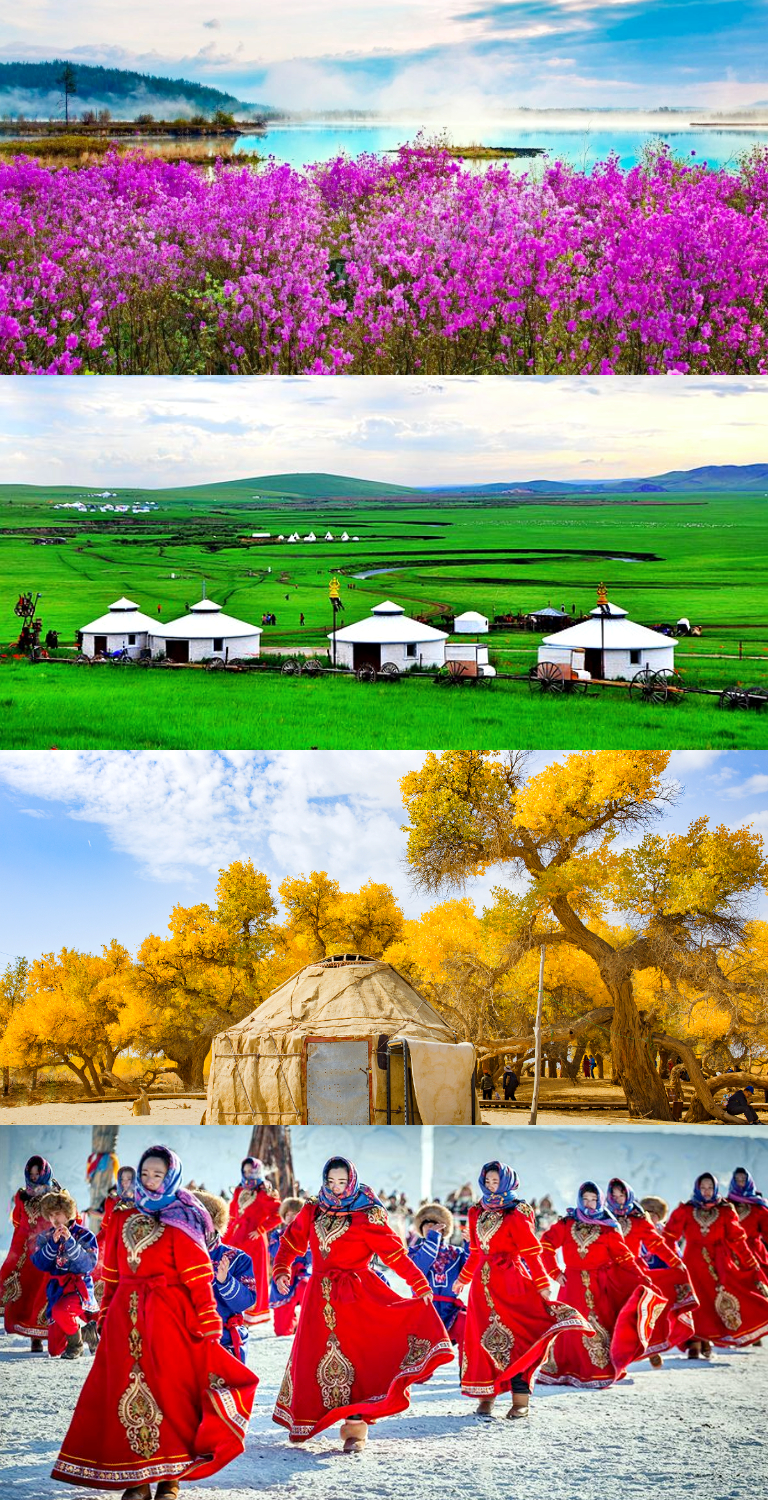
How to Go to & Around Inner Mongolia
Travel to inner mongolia by flight, train & car.
How to get to Inner Mongolia from other places in China or other countries? Flights, high speed trains and driving are mostly used for reaching the major traffic hubs. And Hohhot is usually the most convenient gateway city accessible by air and railway. Hulunbuir is easily to get to by flights. While Badain Jaran and Ejina can be arrived by flight, car, etc. Click each destination for its detailed transportation info about how to get there and travel around.
Travel within Inner Mongolia Prefecture
After landing in Inner Mongolia, how to transfer among each hot places, such as Hohhot, Ordos, Baotou, Ulanqab, Hulunbuir, Arxan, Badain Jaran, Ejina, etc.? Within this prefecture, you can make fully use of the flights, car, private car, etc.
- Hohhot - Ordos (distance: 215km): it needs 3.5-4 hours (270km) by car driving; 1.5-2 hours by bullet train and 3.5-4.5 hours by normal train.
- Hohhot - Baotou (distance: 153km): it takes 2-2.5 hours (170km) by car driving; 1-1.5 hours by bullet train and 1.5-3 hours by normal train.
- Baotou - Ordos (distance: 114km): it needs 1.5-2 hours (130km) by driving; 1.5-2 hours by normal train.
- Hohhot - Hulunbuir (distance: 1,120km): It takes 2 hours by flights from Hohhot to Hailar and Manzhouli.
- Hailar - Arxan (distance: 220km): it needs 4-4.5 hours (290km) by driving.
- Badain Jaran - Ejina (distance: 310km): it takes 6.5 hours by car.
Recommended Local Private Car Transfer Service
As the travel region is large in Inner Mongolia and network of high speed trains within there is not so great as other developed areas in China, to help you easily transfer between those destinations, such as Hohhot - Ordos - Baotou - Ulanqab, Hailar - Ergun - Genhe - Manzhouli, Badain Jaran region, Xilingol region, etc., we recommend you travel with our local private car transfer service. Our local tour guide and driver will escort you from your accommodation to each scenic area, between those neighboring cities easily by the non-smoking comfortable licensed private vehicle from China Discovery . So you can have more time and attention on the highlights of Inner Mongolia instead of the navigation and hard communication with locals not speaking much English. Please contact us if you need any help!
Check more about How to Get to & Around Inner Mongolia
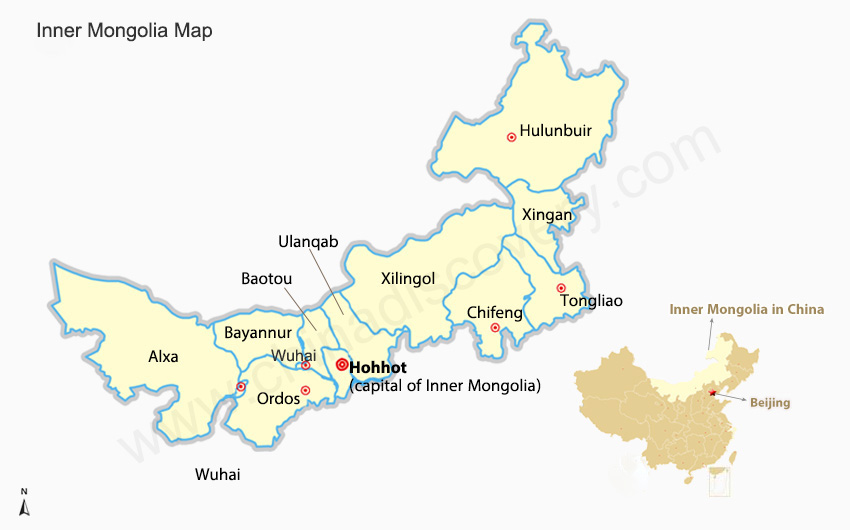
Top Destinations to Go in Inner Mongolia
Though not listed into the top classic travel destinations in China, Inner Mongolia indeed nurtures a series of unique and fabulous places to attract numerous global visitors to have a personal exploration during their China trip. More than the most symbolic green grasslands, wild adventurous deserts, magnificent geological wonders, glorious imperial history, mysterious life of horseback Mongolian tribes, harmonious mixed ethnic flavors and so forth makes those places worthy your visit at least. Check the top must-visit destinations at below.
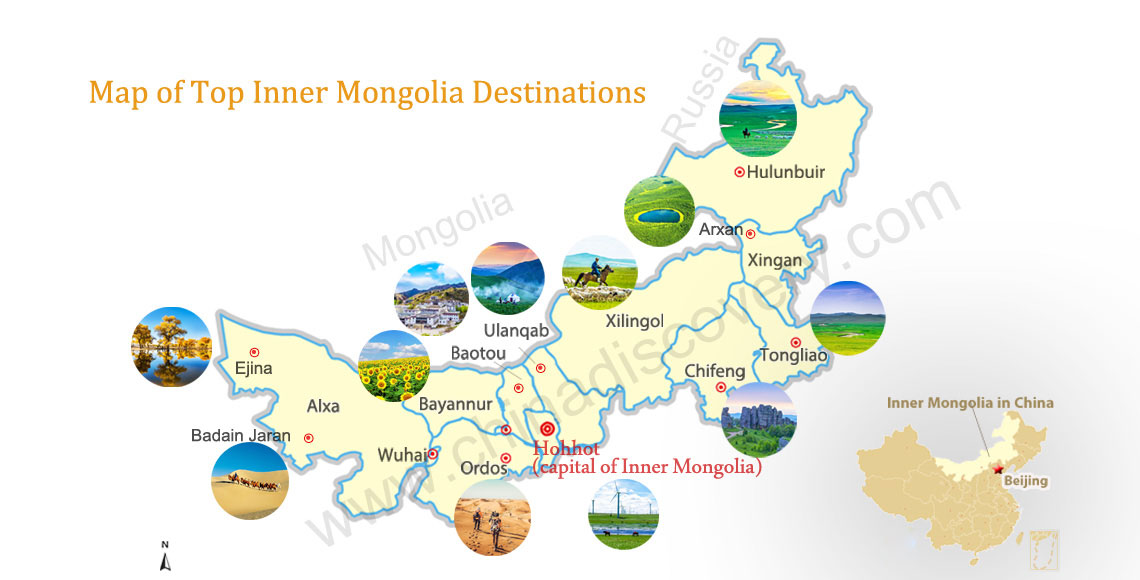
Top 1: Hohhot
Besides being the convenient capital of Inner Mongolia, Hohhot is the most chosen gateway to chase the breeze on the endless emerald grasslands in nearby Baotou and Ulanqab, which makes an Inner Mongolia grassland quite easy and memorable. More than that, Hohhot preserves excellently the exquisite centuries-old Dazhao Temple with three treasures and the valuable collections in Inner Mongolia Museum to help everyone have the best understanding of the important Tibetan Buddhist culture, staged historical development of Inner Mongolia area and the ideal nomadic life theory on the prairie. A classic Inner Mongolia tour shall not omit Hohhot! More about Hohhot >>
Itinerary: 1-3 days
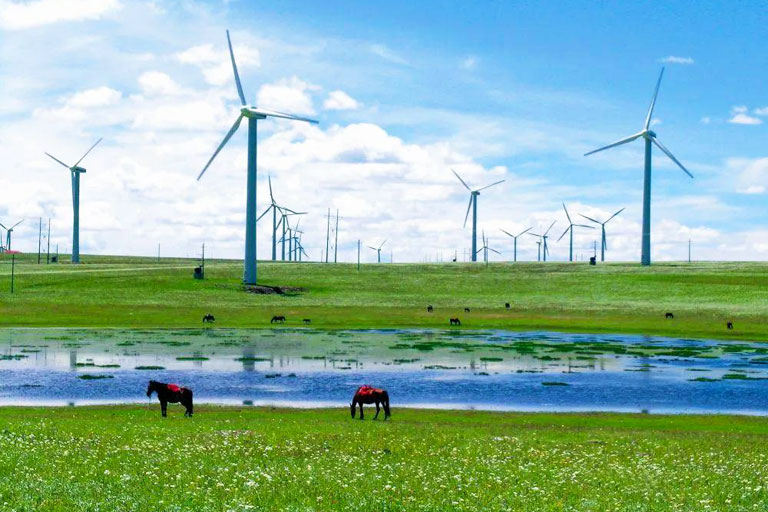
Top 2: Hulunbuir
As boasting the best and most beautiful grassland in China, Hulunbuir is the darling for grassland fans. Most areas within Hulunbuir show you the real look of an idyllic fairyland with pasture melody, like the winding river on the prairie, wetland with grazing cattle, dense forest, peaceful mixed border towns. All are the fabulous authentic nature gifts. Furthermore, the architectures of various shapes and retained tribes and villages scattered around hide the rising and declining secretes of those once strong ethnic tribes in the northern China. More about Hulunbuir >>
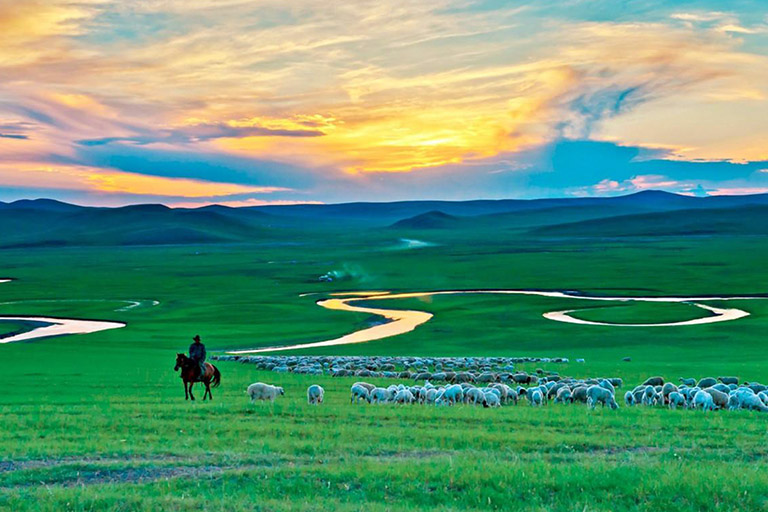
Top 3: Badain Jaran
Badain Jaran Desert as the most beautiful desert in China is the most popular among adventurers. Covering 49,200 s. k. m., it is the idyllic nature playground to enjoy sightseeing, photography, hiking, off-road driving, camping, and more fun with its featured five wonders of sandy peaks, singing dunes, colorful lakes, clear springs, and ancient temple. Its world highest sand dune of 1,617meters above sea level praised as the “Mount Everest in the Desert” gives you a brand-new terrific admiration of the wild desert beauty. Also, the over 140 lovely lakes changing colorful lights under sunshine makes Badain Jaran the sacred wonderland for visual and spiritual pleasure! More about Badain Jaran >>
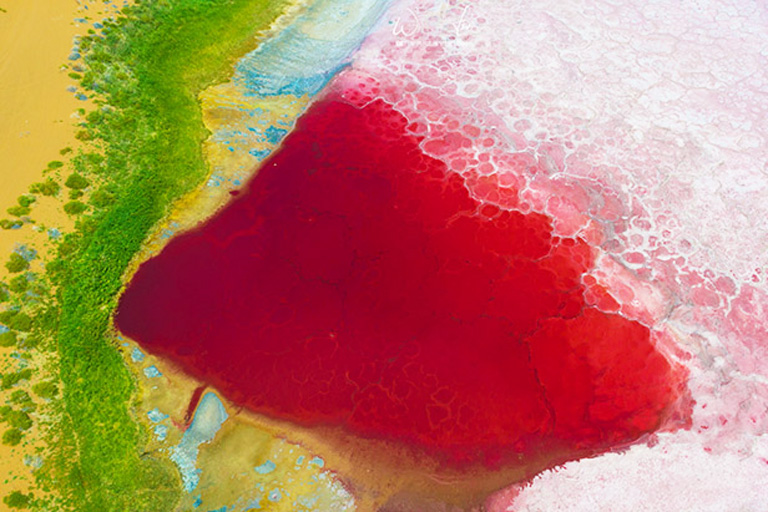
Top 4: Ordos
Together with Hohhot and Baotou to be praised as the “golden triangle” of Inner Mongolia, Ordos is far more famous for its global cashmere brand. Boasting the holy and treasurable Mausoleum of Genghis Khan and other themed sites about Genghis in the city, Ordos is one of the top place to seek the trace and pay respect to that once world influential great founder of Mongolia Empire in Yuan Dynasty 600 years ago. Besides, the China’s seventh largest desert - Kubuqi Desert preserves the authentic, successfully greening, entertaining, and more wilder types for your escape from the noisy urban to the far boundary. More about Ordos >>
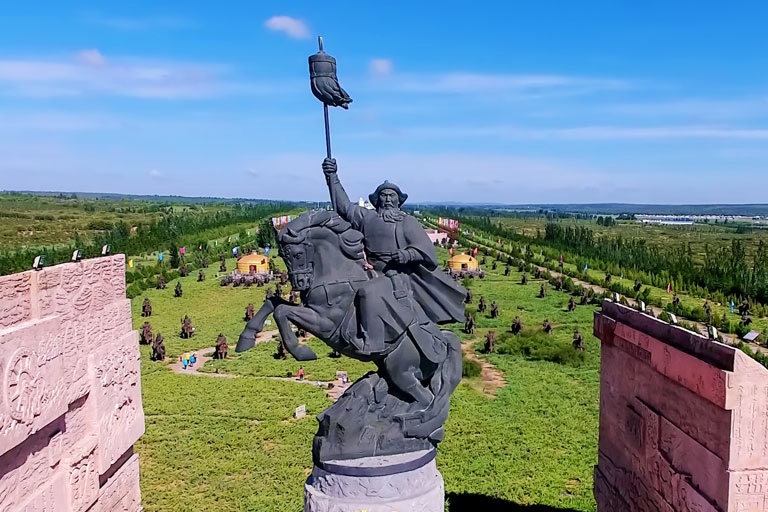
Top 5: Baotou
Baotou is not only the excellent industrial city for Inner Mongolia profit, but also the habitable new city with pleasant Xilamuren Grassland for both nature and fun on the green carpet. Besides that popular prairie, Baotou boasts the top favored temple clusters to show the rich Tibetan Buddhist culture with Mongolian features in Inner Mongolia, including the sacred Wudangzhao Lamasery and Meidaizhao Monastery. Thus, Baotou is talent to make great balance between nature, culture and development in the modern 21st century, which worthy for your exploration and analysis! More about Baotou >>
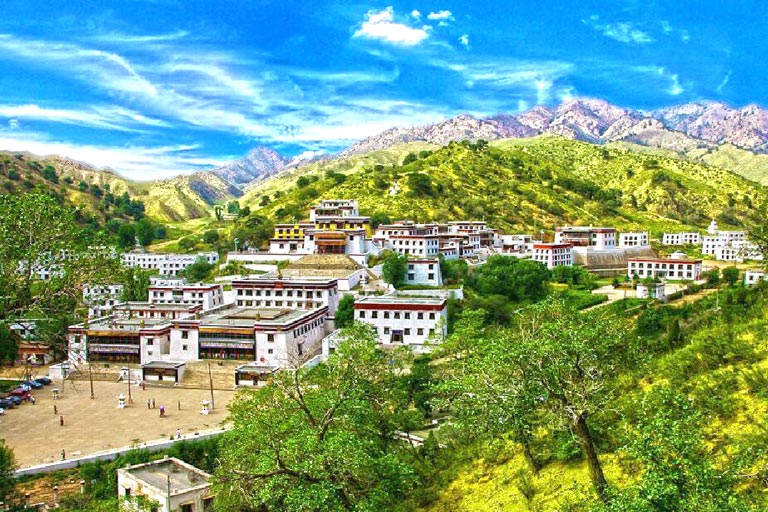
Top 6: Xilingol
The large Xingol attracts lots of travelers for its fabulous Xilingol Grassland with scattered grazing flocks and herds and luxurious grass for the authentic poetic grassland spectacular, especially the picturesque Xilingol Nine Bends. Also, it has a vital statue among Inner Mongolian culture and history for the remaining of the only Site of Xanadu as the precious state capital city of the significant Mongolia Empire, which is so treasurable for seeking the history and culture of that globally influential kingdom in past China. Furthermore, the annual Naadam Festival held around Wuzhumuqin Grassland is the highlight to show the talent of Xingol men on grassland. More about Xilingol >>
Highlights: Xilingol Grassland, Site of Xanadu, etc.
Best Visiting Time: May to September
Itinerary: 1-2 days

Top 7: Ejina
Ejina is not known much, but its Ejina populus euphratica forest turns into resplendent golden color every autumn makes it an extremely hot destination for nature appreciation and photography. Pretty and charming populus trees show various graceful poses on the lake, under the sunshine, in the desert, etc. for the special enjoyment of the vitality of the wild barren land. Do not miss Ejina if you are shutterbugs. More about Ejina >>
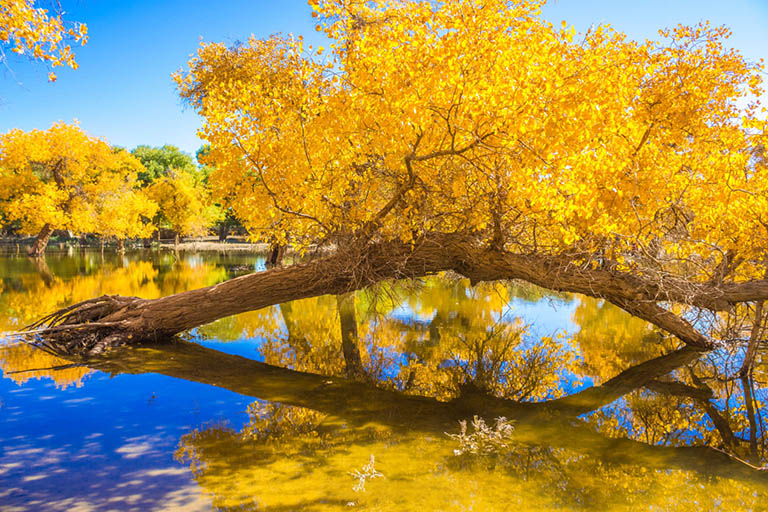
Check more about Top Inner Mongolia Destinations to Visit
Where to Start or End Your Inner Mongolia Tour
Where to start or end your trip in Inner Mongolia depends on which area you are going to discover.
For a classic Inner Mongolia discover to the middle part, Hohhot is mostly planned as the gateway city with most convenient and frequent flights and bullet train connection with other major destinations in China. Thus, you can easily visit to the nearby grasslands, Kubuqi Desert and best highlights in Baotou and Ordos. And Ordos is a wise and saving choice to complete such an itinerary.
For a discovery to the west part like Badain Jaran, Ejina, etc., it is more suggested to fly to the nearby traffic hub cities in Gansu, Qinghai or Ningxia and then arrive in the previous destinations in Alxa with a road discovery. It takes too long time to drive from Hohhot to Badain Jaran.
Moreover, to explore the east region like Hulunbuir, Arxan, etc. Hailar and Manzhouli are both convenient with flights.
You can check more arrangement of arrival and departure from our Inner Mongolia tours .
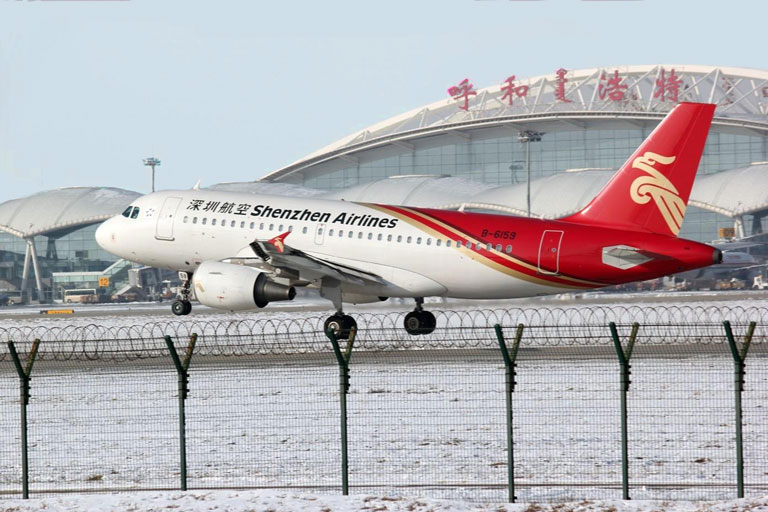
How Many Days to Spend in Inner Mongolia & Itinerary Design
The trip length depends on the rough areas, travel time, interested highlights, etc. you want. Since Inner Mongolia is really large and the highlights are relatively scattered, it is hardly to discover all the bests in only one go . And it can be divided into three major areas you can go for 2-3 times and based on your interests, namely the middle, east and west Inner Mongolia.
● Brief Inner Mongolia - Hohhot & Around
Length: 2-3 days
Itinerary: Hohhot - nearby grassland
Such itinerary takes you to jump into the soft and emerald representative grassland wonderland from the nearby convenient Hohhot capital for about 2 days. And before that, enjoy a classic discovery of Hohhot city highlights about Inner Mongolia culture & history.
Recommended Tours:
☛ 3 Days Best Hohhot Grassland Tour with Huitengxile Landscape
☛ 2 Days Huitengxile Grassland Tour from Beijing by Bullet Train
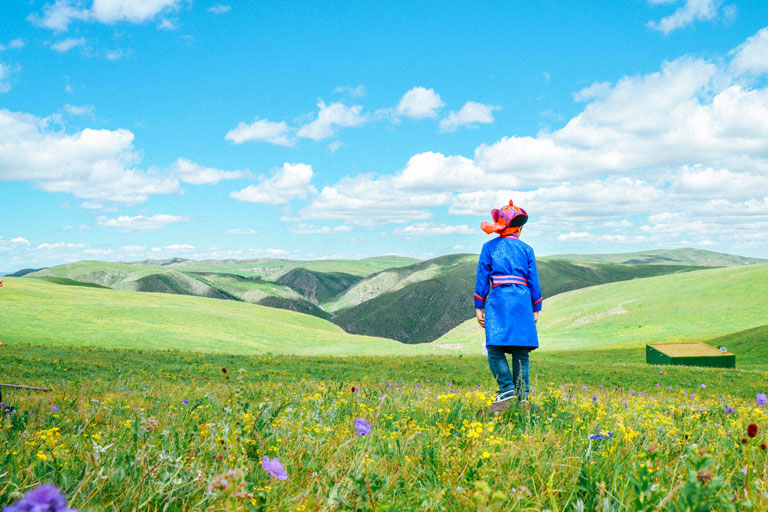
● Classic Inner Mongolia - Central Area
Length: 5-6 days
Itinerary: Hohhot - Baotou - Ordos
This itinerary will let you Get to Hohhot easily and quickly run to the refreshing nearby grassland for 2 days. After a comprehensive Inner Mongolia preview with the popular museum and temple, go to visit the famous Tibetan Wudangzhao Lamasery and transfer to Kubuqi Desert for adventure. On the last day, explore Genghis Khan culture and new city appearance in Ordos.
☛ 5 Days Classic Inner Mongolia Tour
☛ 6 Days Inner Mongolia Bests Discovery Tour
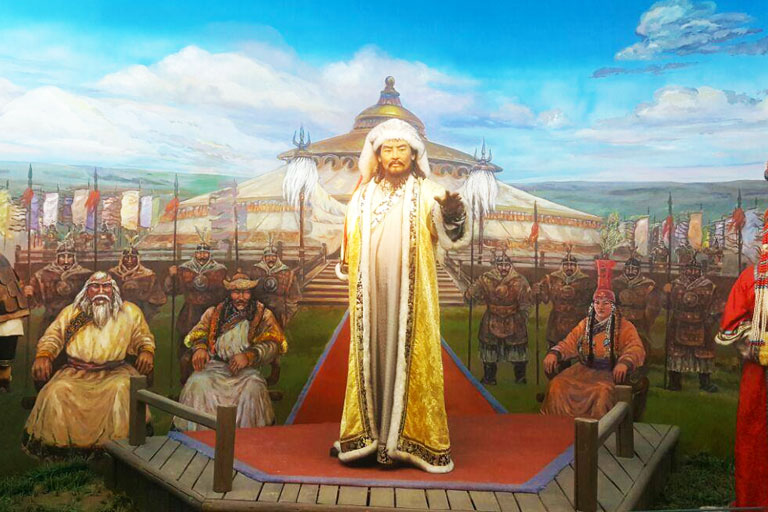
● Authentic Inner Mongolia - East Area
Itinerary: Hulunbuir (Hailar - Ergun - Genhe - Manzhouli)
This itinerary takes you to explore the primitive poetic sightseeing of famous Hulunbuir Grassland and more stunning authentic wetland, forest, lakes, rivers, etc. on the large and fabulous Hulunbuir. The scenic driving road leads you to the peaceful villages of Russian, Ewenki and other ethnic minorities and tribes living on the border of China, Russia and Mongolia. And you can explore deeper to the white birch forest covered village to seek the reindeer tribe life. Finally, after a sightseeing driving along the border river, arrive in Manzhouli to catch the Russian flavor for the tour end.
☛ 5 Days Best Hulunbuir Tour
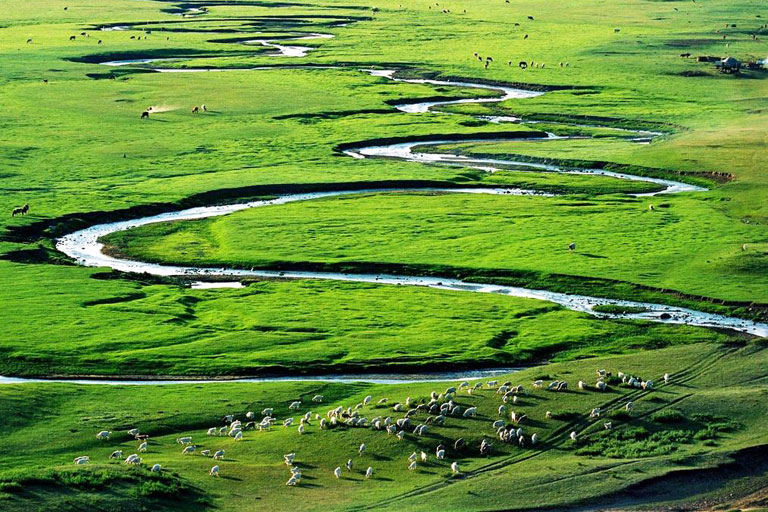
● Wild Inner Mongolia Adventure - West Area
Length: 3-6 days
Itinerary: Badain Jaran Town - Badain Jaran Desert
If you are seeking the wild adventure and escaping to the real wide nature, head to Badain Jaran Desert in the west Inner Mongolia. Visit Badain Jaran Geo-park Museum to culture implement and then hop on the cool desert Jeep to start your cool off-driving in the vast desert sea and admire the beauty of Badain Lake, Daetu, Yinderitu Spring, Bilutu, Badain Jaran Temple. Catch the sunset and the following sunrise on the golden desert and continue your safari to Barun Jaran, Bayunyikeri, Heavenly Lake, etc. for a classic Badain Jaran exploration. Of course, you can add more days for deeper hiking experience based on your interests and physical condition.
☛ 3 Days Badain Jaran Desert Camping Tour with Jeep Safari
☛ 5 Days Danxia Badain Jaran Desert Tour from Zhangye
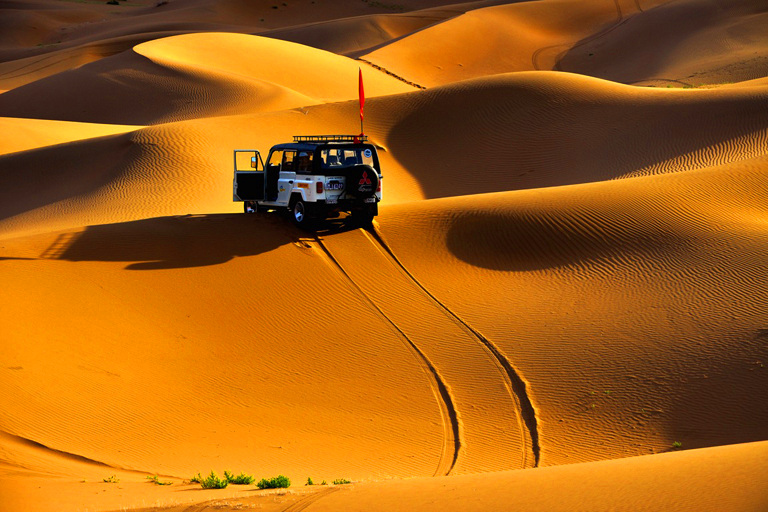
Besides, if you want an Inner Mongolia grassland and desert tour, plan about 6-7 days Hohhot - Baotou - Ordos - Hulunbuir tour. If you like Arxan, take the 9-day Hulunbuir & Arxan tour for reference. Also, if you are photography lovers, plan 3-4 days to Ejina Populus Euphratica Forest. If you like more authentic scenery or Inner Mongolia ancient culture, arrange 4-5 days to Chifeng and Xilingol. If you have more interested Inner Mongolia places to visit or any ideas, feel free to contact us to help you plan or customize your trip!
☛ 9 Days Hulunbuir & Arxan Geopark Tour
☛ 4 Days Ejina Populus Euphratica Forest Photography Tour
☛ 5 Days Primitive Inner Mongolia Tour to Xilingol
☛ 5 Days Classic Hexigten Scenic Tour with Wulan Butong Grassland
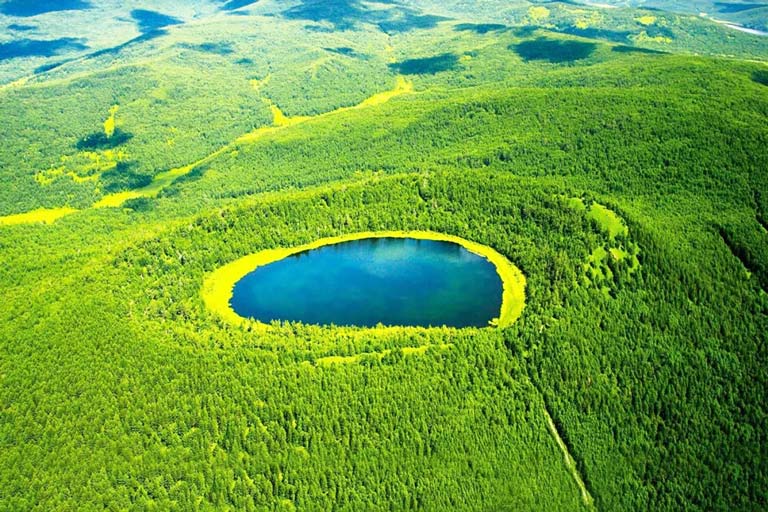
Extend Your Inner Mongolia Trip
Traveling Inner Mongolia alone is far from enough to have a good savory of the north and west part and entire China. Adjacent to Gansu, Qinghai, Ningxia, Shanxi, etc. Inner Mongolia is often planned in a 5-8 days tour to the Silk Road (Dunhuang, Zhangye, Lanzhou, Jiayuguan, etc.), Xining, etc. And people interested in the Chinese ancient history and grassland view prefer a 5-7 days trip to Beijing and Inner Mongolia. Also, if you have a longer vacation, it is a super great idea to extend your trip to more popular appealing destinations in other parts of China, like Shanghai , Xian , Chengdu , Guilin, Yangtze River , Zhangjiajie , Huangshan , Yunnan , Tibet , Xinjiang , and so forth to discover more and save more! Here are some top popular tour packages for your inspiration!
If you have other travel ideas or any questions, please feel free to contact us and our experienced travel consultants will customize a satisfactory for you.
☛ 7 Days Qinghai Lake Zhangye Danxia Badain Jaran Desert Wonders Tour (Xining - Zhangye - Badain Jaran)
☛ 8 Days Best of China Tour (Beijing / Xian / Shanghai)
☛ 12 Days Wonders of China Tour (Beijing / Xian / Guilin / Zhangjiajie / Shanghai)
☛ 10 Days Classic Silk Road Tour (Xian/Dunhuang/Turpan/Kashgar)
☛ 7 Days Miraculous Land Tour from Dunhuang to Zhangye Xining (Dunhuang - Jiayuguan - Zhangye - Xining)
☛ 9 Days East China & Mt. Huang Tour by High Speed Train (Shanghai / Suzhou / Hangzhou / Huangshan)
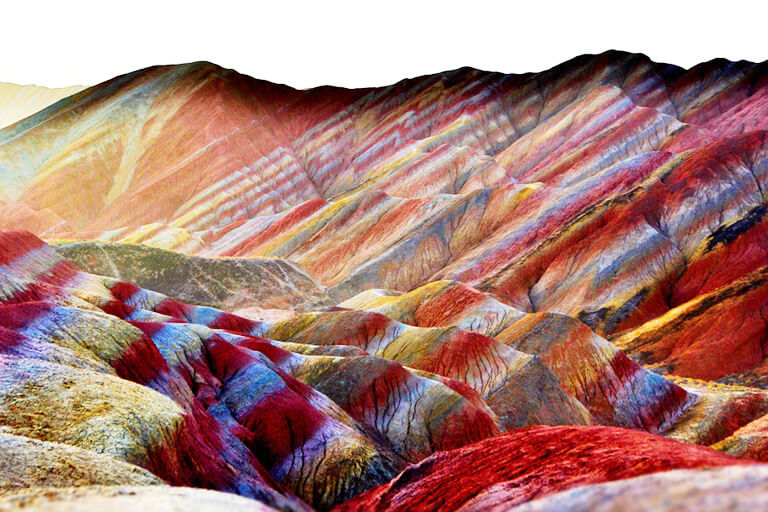
Where to Stay in Inner Mongolia
Within Inner Mongolia, you can find diverse accommodations from the starred luxury hotels, comfort hotels, to budget hostels, themed boutique hotels, and ethnic featured homestays, etc. for your trip there. You will have no worry, especially in Hohhot, because it provides the best and most choices of diverse levels and the accommodations in the downtown are usually the best for your high demands. Besides, Hulunbuir, Ordos, Baotou, etc. also offer a large number of luxury to cost-efficient choices for you. While, grassland and desert areas not only provides great hotels, but some special Mongolian yurts or camping experience for your new try. Check the detailed recommended areas to stay and accommodation types of each tip popular travel destination in Inner Mongolia at below for your reference.
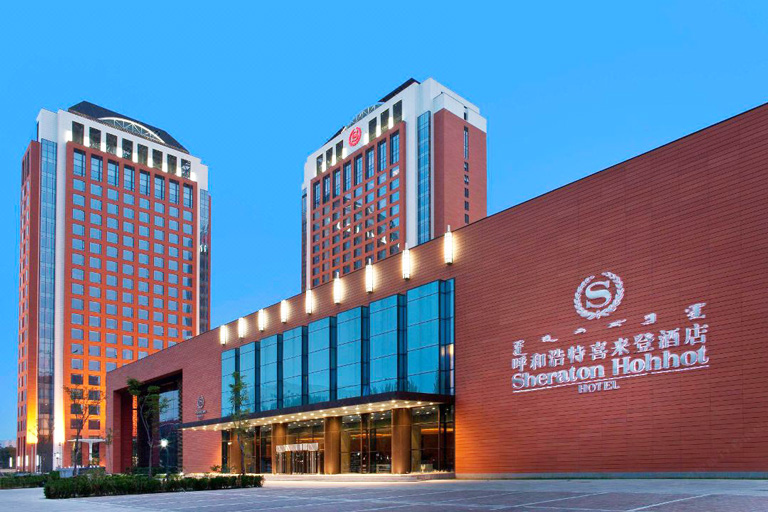
Check more about Where to Stay in Inner Mongolia
Travel Inner Mongolia with China Discovery
Have your own ideas of where and what to discover in Inner Mongolia? We China Discovery offers many popular and valuable private Inner Mongolia tour packages taking you to enjoy wonderful exploration of the best highlights of Hohhot, Hulunbuir, Ordos, Baotou, Badain Jaran, Ejina, etc. And our professional travel team with experienced travel expert, local English-speaking travel guide and driver and non-smoking comfortable licensed private vehicle will help you throughout the trip from the planning, navigation, hotel arrangement and scenic spot visiting. So you will have the much better travel experience in the large and beautiful Inner Mongolia. You can check our tour packages to get some inspiration. All tours can be tailor-made according to your group size, time, physical condition, plan, interests, budget and any other special need! Please feel free to contact us to customize your own Inner Mongolia trip or if you need any help !
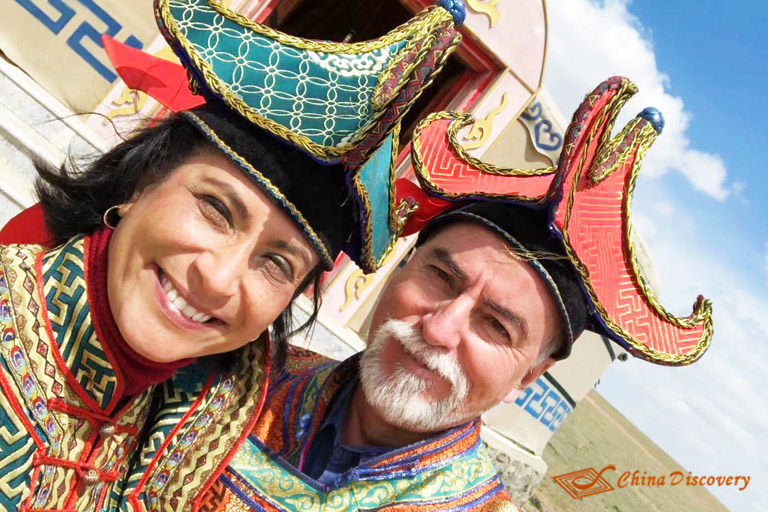
More about Inner Mongolia Travel Guide
- Top Cities & Destinations
- Hot Attractions
- Things to Do
- Famous Grasslands
- Top Deserts
- Transportation
- Weather & Best Time
- Inner Mongolia Summer
- Inner Mongolia Autumn
- Inner Mongolia Winter
- Hotels & Where to Stay
- Photos & Landscpaes
- Travel Tips
- Naadam Festival
- Horse Riding
- Mongolian Yurts
Inner Mongolia Cities' Travel Guides & Tours
- Hohhot Travel Guide
- Hohhot Tours
- Hulunbuir Travel Guide
- Badain Jaran Tours
- Ejina Travel Guide
- Ejina Tours
- Baotou Travel Guide
- Baotou Tours
- Ordos Travel Guide
- Ordos Tours
- Chifeng Tours
- Xilingol Tours
- Ulanqab Tours
- Bayannur Travel Guide
- Inner Mongolia Travel Guide
- Popular Inner Mongolia Tours
Hottest Attractions in Inner Mongolia
- Hulunbuir Grassland
- Badain Jaran Desert
- Huitengxile Grassland
- Inner Mongolia Museum
- Kubuqi Desert
- Xilamuren Grassland
- Mausoleum of Genghis Khan
- Arxan National Forest Park
- Ergun Wetland
- Dazhao Temple
- Wudangzhao Lamasery
- Ejina Populus Euphratica Forest
- Ulan Butong Grassland
- Xilingol Grassland
- Tengger Desert
- Site of Xanadu
- Wulanhada Volcano Geopark
- Gegentala Grassland
Recommended Inner Mongolia Tours
Top 3 Inner Mongolia tours chosen by most customers to explore Inner Mongolia in the best way. Check the detailed itinerary, or tailor your own trip now with us.
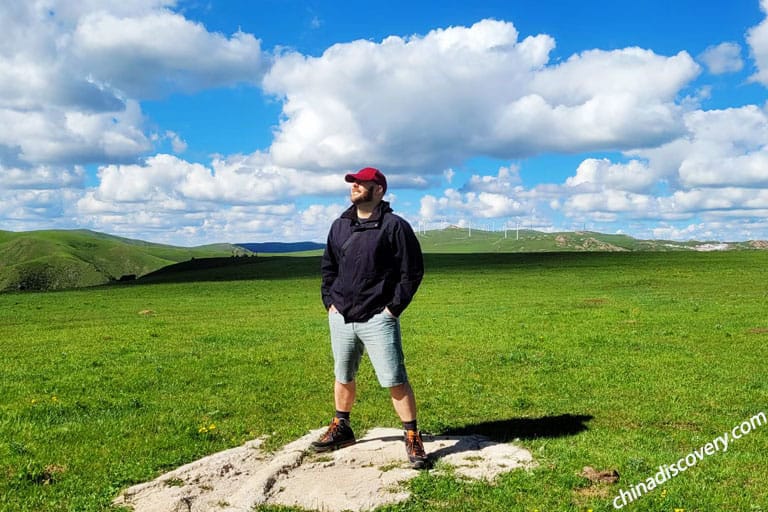
5 Days Classic Inner Mongolia Tour
Hohhot / Huitengxile Grassland / Yemingsha of Kubuqi Desert / Hohhot
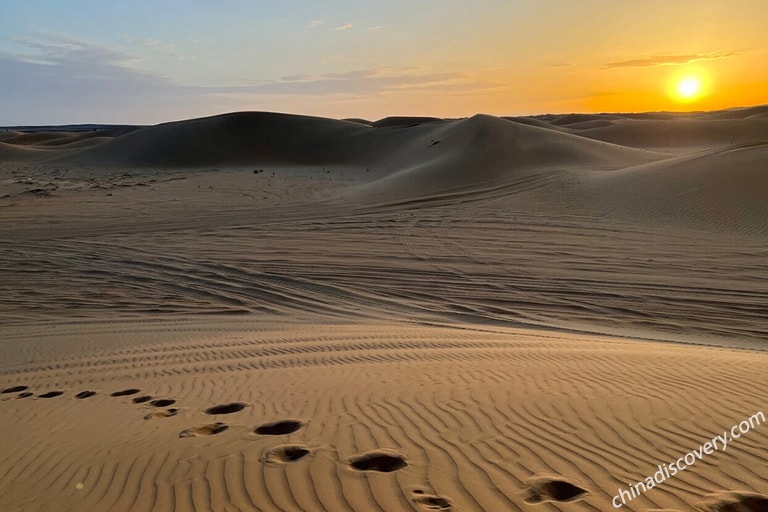
6 Days Inner Mongolia Bests Discovery Tour
Hohhot / Ulanqab / Huitengxile Grassland / Hohhot / Baotou / Yemingsha of Kubuqi Desert / Ordos
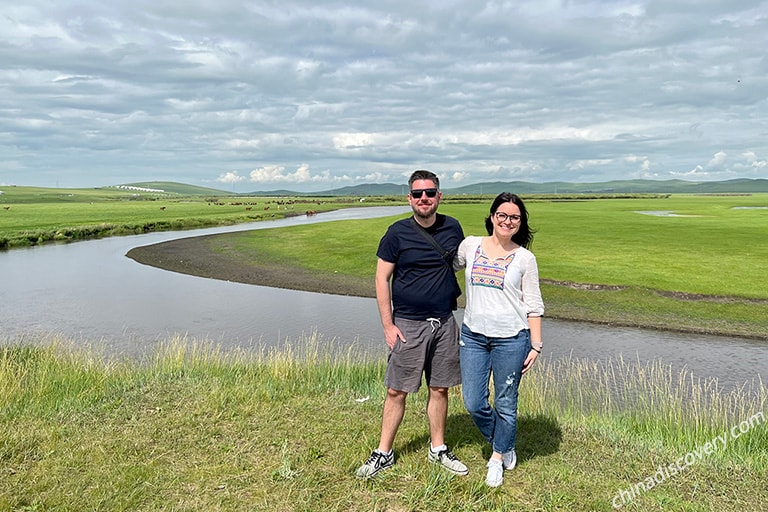
5 Days Best Hulunbuir Tour with Grassland Exploration
Hulunbuir / Erguna / Manzhouli / Hulunbuir
Start planning your tailor-made holiday to China by contacting one of our specialists. Once inquired, you’ll get a response within 0.5~23.5 hours.

Have a question? Get answers from our travel experts or guests
- Your Question:
- Your Email:
- Affordable and valuable price
- 100% tailor-made packages
- Highly rated customers reviews
- Efficient customer support
China Tours
- Top 10 China Tours
- Classic China Tours
- China Tours from Beijing
- China Tours from Shanghai
- China Tours from Hong Kong
- China Tours from Chengdu
- Short China Trips
- Customize China Tour
- China Panda Tours
- Family Tour with Kids
- High-Speed Train Tour
- Silk Road Travel
- Yangtze River Cruise
- Hiking & Trekking Tours
- Photography Tours
- China Minority Travel
- Beijing Shanghai Tours
- Shanghai Yangtze Tours
- Chengdu Jiuzhaigou Tours
- Chengdu Lhasa Tours
- Suzhou Hangzhou Tours
- Guilin & Yangshuo
- Zhangjiajie
“Very good experience”
“WONDERFUL 25 DAYS IN CHINA - PRIVATE TOUR”
“Awesome China tour from northeast to southwest”
Any questions, please email us at: [email protected] or call us at: 86-19138970032 (Monday-Friday 9 a.m. to 6 p.m. GMT+8)
- Terms & Condition
- Privacy Policy
- Customer Support
Copyright © 2011-2024. All rights reserved.
Cookie policy
We use cookies to give you the best experience on our website. Continue using our website means you agree with our cookie policy. For more info, please read here .
- SCIO press conference on prioritizing high-quality development in Inner Mongolia and building a model autonomous region in an all-round manner
Last year, the State Council published a guideline to boost the high-quality development of the Inner Mongolia Autonomous Region, invigorating Chinese modernization. How has the implementation progressed so far? How can we ensure that the public enjoy tangible benefits? Thank you.
Wang Lixia:
I'd like to invite Mr. Huang Zhiqiang to answer this question.
Huang Zhiqiang:
Thank you for your question. Last year, the State Council issued the guideline, and various ministries and commissions introduced related supportive policies, all of which are tailored to benefit Inner Mongolia by boosting sound, substantial development. The measures cover five areas: infrastructure, energy and resources, the ecological environment, industrial development, and people's livelihoods. Implementing these policies will profoundly impact Inner Mongolia's high-quality development and contribute to China's modernization.
We have seized this significant development opportunity by breaking down the guideline into 86 major projects, transforming the blueprint into a concrete action plan. To date, 59 major projects have commenced construction, with a total investment of 135 billion yuan, and all tasks are progressing smoothly.
The implementation of these policies brings tangible benefits to the public. For example, in transportation, we have accelerated the construction of the Baotou-Yinchuan high-speed railway. Once operational, travel time from Bayannur to Beijing will be reduced from 13 hours to four hours. We are also optimizing airport layouts, accelerating the construction of general airports, and developing regional routes, making border areas more accessible.
In terms of increasing employment, we have planned the construction of six large-scale wind power and photovoltaic bases in sandy, rocky, and barren areas. According to our preliminary estimates, each base will have a static investment of over 80 billion yuan and will provide more than 10,000 jobs for the local area.
Regarding rural revitalization, we have significantly supported designated counties and banners by establishing numerous national-level modern industrial parks. For example, the dairy and soybean industrial park in Morin Dawa Daur autonomous banner can boost the income of 50,000 farming households in the area.
In order to boost local economies and ensure stability in border areas, we have implemented projects to improve and upgrade infrastructure in villages and small towns at key junctures. This includes advancing the integrated construction of facilities for drinking water, electricity, roads, and telecommunications. Our goal is to ensure that all villages, guard posts, police stations, and small police stations in border areas have access to drinking water, electricity, telecommunications, as well as radio and television services.
We have stepped up our efforts to establish four regional health centers in a bid to improve medical services. We have worked with the Beijing Cancer Hospital to establish a branch hospital in the Inner Mongolia autonomous region. In the past, many people had to travel to Beijing for medical treatment. Nowadays, residents can access top-notch medical expertise from experts in Beijing without leaving their local area.
Xing Huina:
Thanks. Please continue with your questions.
Inner Mongolia is an important hub of the China-Mongolia-Russia Economic Corridor, and also a crucial gateway for the New International Land-Sea Trade Corridor in the western region. What considerations are there for promoting higher-level opening-up and serving the overall national policy of opening-up? Thank you.
I'd like to invite Mr. Yang to answer this question.
Thank you for your question. Situated on the northern frontier of China, Inner Mongolia serves as a vital gateway for opening up to countries and regions north of China. It boasts unique advantages to open up internally and externally. In recent years, with the further advancement of the Belt and Road Initiative and the China-Mongolia-Russia Economic Corridor, Inner Mongolia has expanded its economic cooperation with more partners in Russia and Mongolia, achieving a higher level of openness to northern countries and regions.
Inner Mongolia's Manzhouli and Erenhot serve as the exit ports for the eastern and central corridors of the China-Europe Railway Express, respectively. These two corridors make up two-thirds of the three railway corridors of the China-Europe Railway Express across the nation. In 2023, almost 50% of the China-Europe freight trains nationwide departed from or passed through Inner Mongolia. Manzhouli Port is China's largest land port, while Erenhot Port is China's largest land port to Mongolia. Given this, we have adopted a series of measures to improve and upgrade infrastructure and leverage information-based and smart technologies to ensure the smooth operation of the China-Europe Railway Express services. Moreover, we have intensified efforts to build Manzhouli and Erenhot into smart ports and adopt a new model of cross-border transportation using automated guided vehicles in Ganqmod and Ceke ports, significantly accelerating port clearance efficiency.
The China-Mongolia Erenhot- Zamyn-Uud economic cooperation zone was officially approved a couple of months ago. This marks the third cross-border economic cooperation zone established between China and its neighboring countries. We will intensify efforts to boost the development of various industries in the zone, including cross-border tourism, the modern service industry, international trade logistics, and the deep processing of imported and exported goods. By doing so, we aim to build the China-Mongolia economic cooperation zone into a high-level platform for opening up border areas.
Furthermore, we have enhanced cooperation with countries along the Belt and Road in various fields, including agriculture and animal husbandry, energy and minerals, the digital economy, biomedicine, and infrastructure. We have also promoted border trade among residents living in border areas. Stepped-up efforts have been made to accelerate the integrated development of domestic and foreign trade, enhancing our cooperation with the Beijing-Tianjin-Hebei region, the Yangtze River Delta, the Guangdong-Hong Kong-Macao Greater Bay Area, and China's northeastern provinces, and improving the coordination mechanism between Inner Mongolia and Beijing. We have also ramped up efforts to promote the construction of the demonstration zone for industrial relocation. In collaboration with partners from Shanghai, Tianjin, and other regions, we have established 25 inland ports across Inner Mongolia. These efforts have created more opportunities for businesses in Inner Mongolia to engage in international trade locally. Additionally, these inland ports have provided support for other regions to open up to northern countries and enhance cooperation with them.
We have established a series of platforms for cooperation and exchanges, such as the China-Mongolia Expo, the Economic and Trade Fair for China's Northward Opening-up, and events to help enterprises from the Inner Mongolia autonomous region seek business opportunities and cooperation abroad. Through these efforts, we have expanded our international circle of friends and trading partners, enabling us to integrate into and contribute to the dual circulation of domestic and international markets in an all-round manner to raise opening-up to a higher level with wider coverage and scope.
Go to Forum >> 0 Comment(s)
Add your comments....
- User Name Required
- Your Comment
- The State Council Information Office held a press conference on June 7 in Beijing to brief the media on prioritizing high-quality development in Inner Mongolia and building a model autonomous region in an all-round manner.

- China Daily PDF
- China Daily E-paper
- Cross-Strait
- Cover Story
- Environment

- Diplomats from 32 countries embark on Inner Mongolia tour

Diplomats from 32 countries in Africa, Asia, Europe, North America, South America and Oceania embarked on a diplomatic tour of North China's Inner Mongolia autonomous region on July 10.
Over the course of four days, the diplomatic delegation will explore major economic, social and cultural development projects in the region's cities of Ulaanqab, Hohhot and Ordos.
They're gaining insights into the progress made on projects related to desertification control, new energy and the solar power industry supply chain there.
That's as well as Inner Mongolia's achievements in promoting China's modernization, particularly in areas such as smart agriculture, the green economy, as well as ecosystem and environmental protection.
The delegation first arrived in Ulaanqab, where the diplomats witnessed a Naadam fair performance on the vast Huitengxile Grassland and marveled at the breathtaking natural scenery.
"Your attire is absolutely stunning!" said Sara Fadual H. A. Sada, Resident Minister of the Qatari Embassy in China, on entering the Ulaanqab High-Speed Railway Station – referring to the traditional Mongolian attire worn by the welcoming staff.

- China-Laos Railway facilitates fruit transport
- Turing winner relishes role in improving education
- AI talent commands higher salaries
- Aircraft explore Beidou applications in training
- Three Gorges Dam opens floodgates
Text: A A A Print ECNS Wire
- China's economic 'mid-year report' reveals two major trends
By Wang Enbo
(CNS) -- China's economic "mid-year report" was unveiled on Monday, painting a picture of quantitative growth and qualitative improvement, which shows that the country’s economy entered the second half of the year with overall stability and a trajectory of progress.
The four major macroeconomic indicators-- growth, employment, inflation, and international balance of payments -- serve as a framework to assess economic performance.
"Stability" can be seen from statistical figures that have increased step by step in these areas.
In the first half of the year, China's GDP reached 61.7 trillion yuan (about $8.5 trillion), with a year-on-year increase of 5.0 percent. On a quarter-on-quarter basis, after seasonal adjustment, the GDP growth in the second quarter increased by 0.7 percent , marking the eighth consecutive quarter of positive growth.
A spokesperson for the National Bureau of Statistics said that for an economy of China's size, achieving a medium-to-high growth of around 5 percent is commendable.
Despite lingering economic aggregate and structural pressures, economic growth, especially the continued recovery of labor-intensive service industries, has driven stable employment expansion. In the first half of the year, China's average surveyed urban unemployment rate stood at 5.1 percent , a decrease of 0.2 percentage points from the same period last year.
Furthermore, as the economy continues to recover and employment income stabilizes, the market supply-demand relationship improves, leading to a moderate rebound in price level. The Consumer Price Index (CPI) for the first half of the year edged up by 0.1 percent year-on-year, with a 0.3 percent increase in the second quarter. The core CPI, which excludes volatile food and energy prices, rose by 0.7 percent year-on-year, indicating fundamental stability.
In terms of the international balance of payments, China's total imports and exports reached 21.2 trillion yuan in the first half of the year, setting a new record for the same period in history, and foreign exchange reserves remained stable above $3.2 trillion.
While "quantity" of growth reflects "stability" of economic operation, then "effectiveness" of transformation and "quality" of development highlight more of the forward momentum.
China's industrial transformation towards "new" and "green" trends has become increasingly evident this year. In the first half of the year, the added value of high-tech manufacturing above the designated size accounted for 15.8 percent of the added value of industrial enterprises above the designated size, an increase of 0.6 percentage points from the previous quarter; the output of intelligent and green products, such as integrated circuits, service robots, new energy vehicles, and solar cells, all maintained double-digit growth.
Changes also took place in people's daily lives. New technologies such as big data and artificial intelligence have spawned new consumption scenarios, while new consumption models such as live streaming sales and instant delivery have continued to emerge, driving an 8.8 percent year-on-year increase in online retail sales of physical goods in the first half of the year, with express delivery volume exceeding 80 billion pieces.
Looking ahead to the second half of the year, Wen Bin, chief economist at China Minsheng Bank, predicts that exports will retain resilience, with the potential of downward pressure. He expects policy measures to intensify, aiming to expand domestic demand and support the sustained recovery o the Chinese economy, with ample room for fiscal policy to make a significant impact in the second half of the year.
Liu Jing, chief economist for Greater China at HSBC Global Research, notes that China's exports, industrial production, and investments in manufacturing and infrastructure have shown strong performance in the first half of the year, with industrial production and manufacturing investment being particularly notable factors. She predicts that China can meet its annual GDP growth target of around 5 percent .

Spain beats England 2-1 to win Euro 2024 title
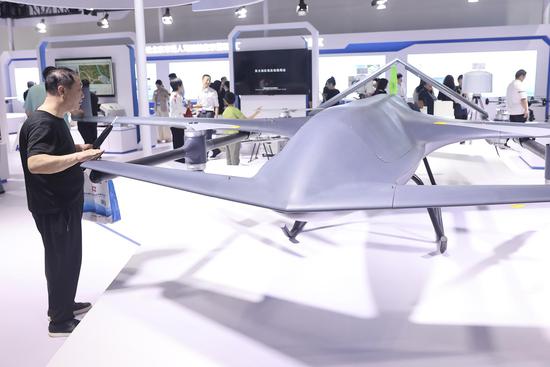
26th China Beijing International High-tech Expo draws visitors
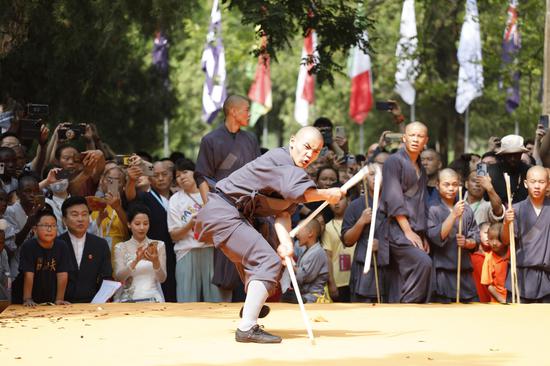
10 practitioners from 47 countries awarded 'Shaolin kung fu star'

Olympic Games Paris 2024 Torch Relay begins in Paris
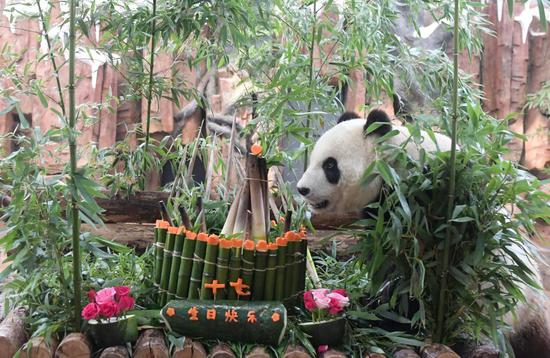
Giant panda celebrates 17th birthday at Jinan Zoo
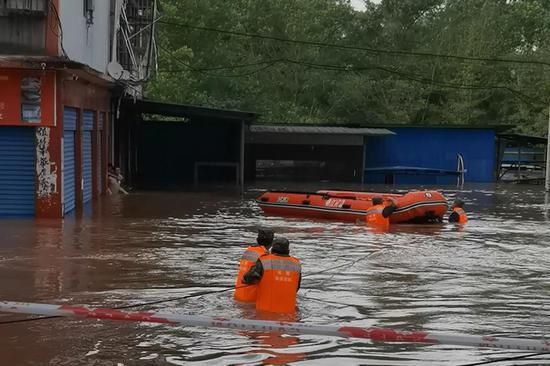
Rescue efforts underway in Chongqing after heavy rainfall
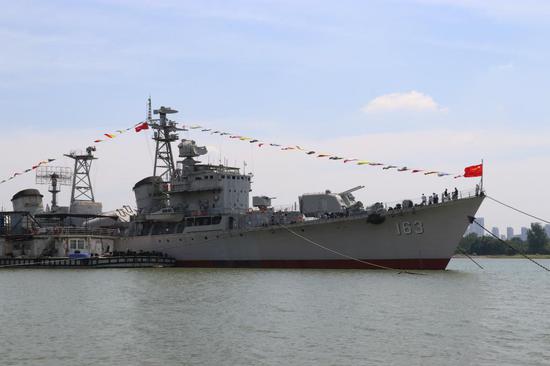
National Maritime Day celebrated with open day activity on military vessel
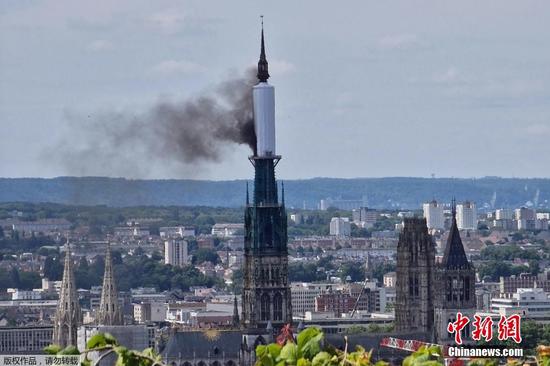
Fire breaks out in spire of Rouen Cathedral in France
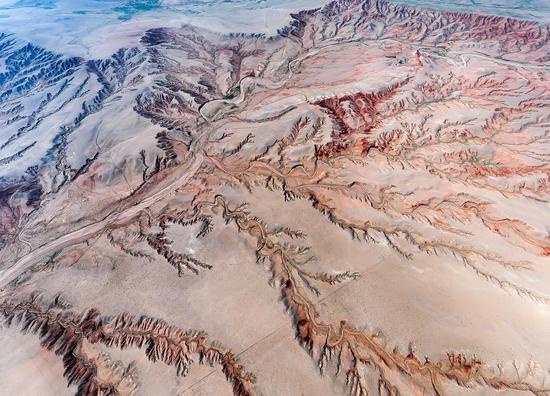
Aerial view: Danxia Landform stretching like tree branches in Inner Mongolia
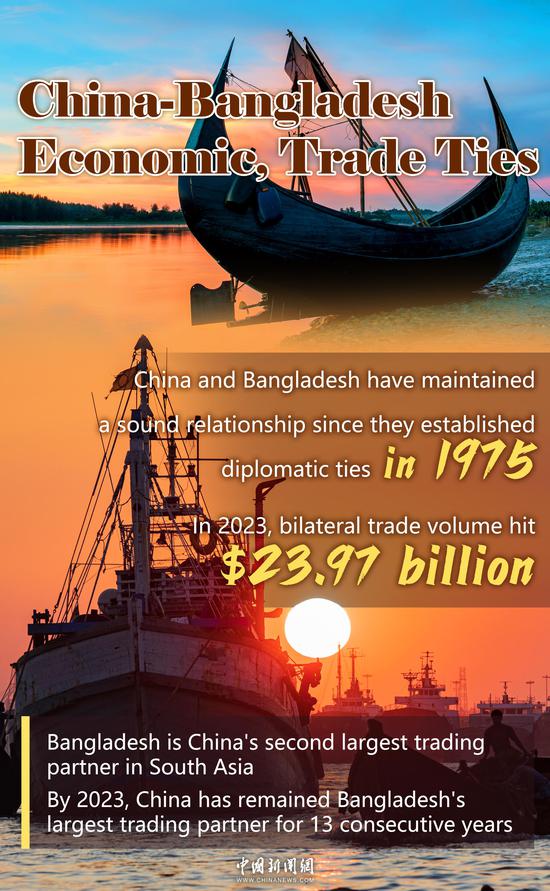
Bilateral relations between China and Bangladesh in numbers
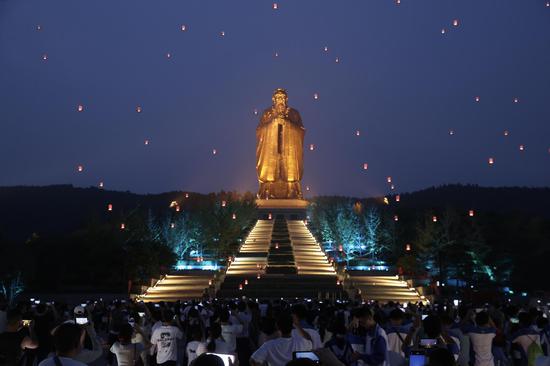
East China city greets Nishan Forum with series of activities

Three Gorges Dam in Hubei discharges floodwater

Three newly built stations along the Sichuan-Qinghai Railway unveiled
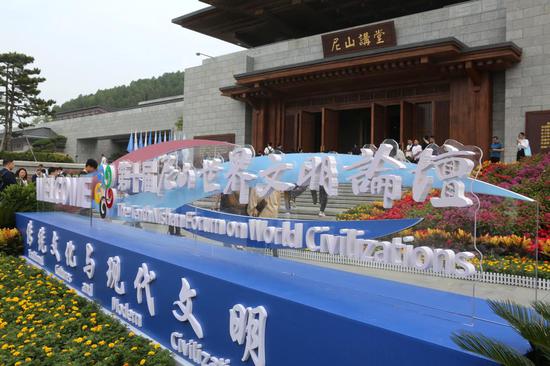
10th Nishan Forum on World Civilizations kicks off in E China
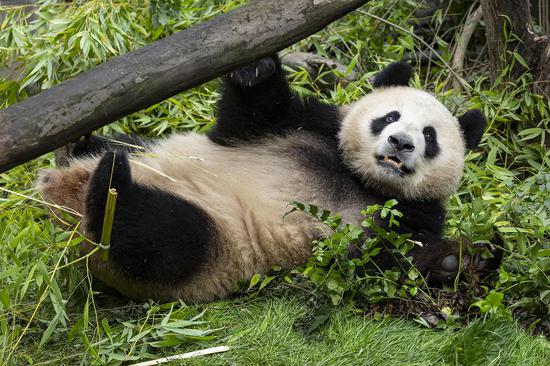
San Diego Zoo releases photos of newly arrived giant pandas
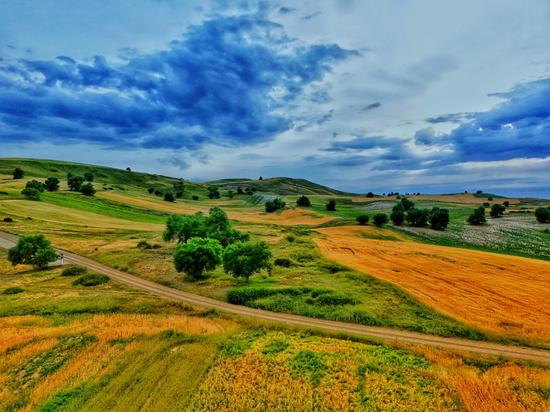
Green, golden fields look like color palette
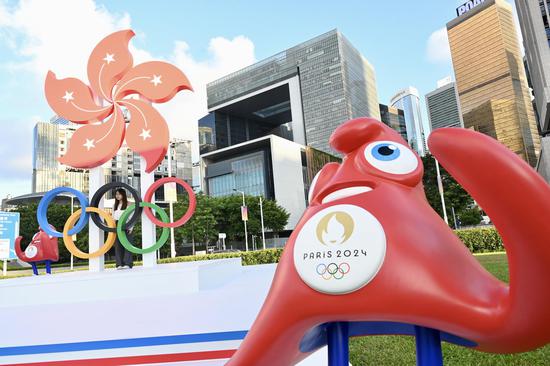
Hong Kong welcomes upcoming Paris Olympic Games
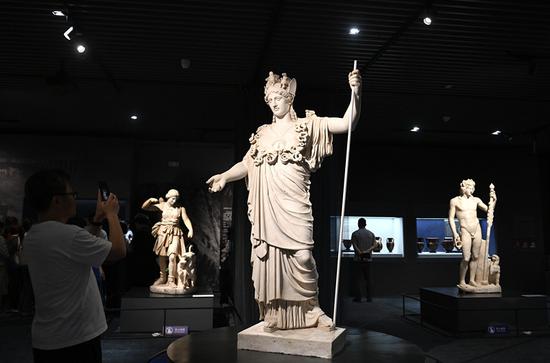
Artifacts of ancient Greeks exhibited at Anhui Museum
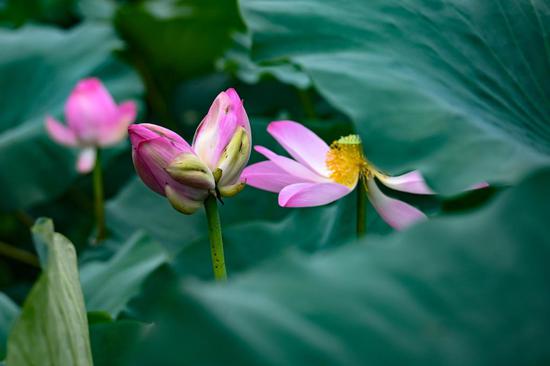
Twin lotus flower buds draw visitors to Nanjing
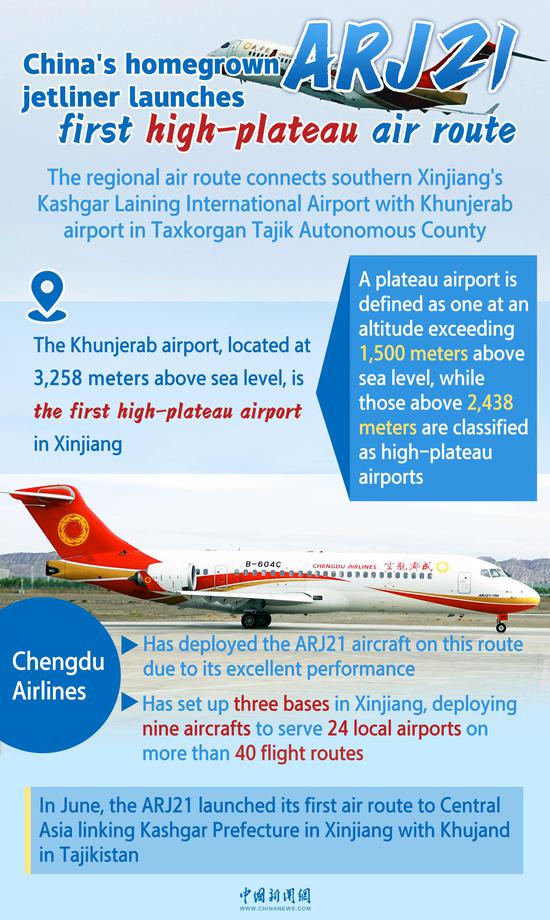
China's homegrown ARJ21 jetliner launches first high-plateau air route
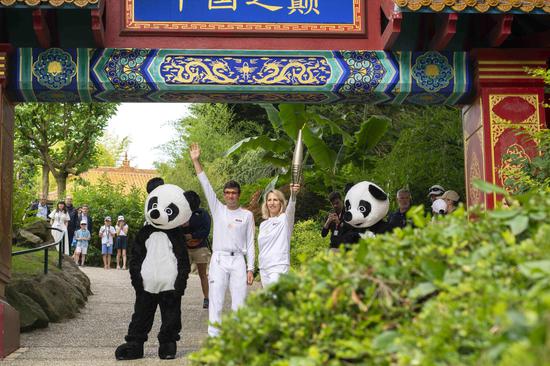
Giant panda seen during torch relay of Paris 2024 at Beauval Zoo
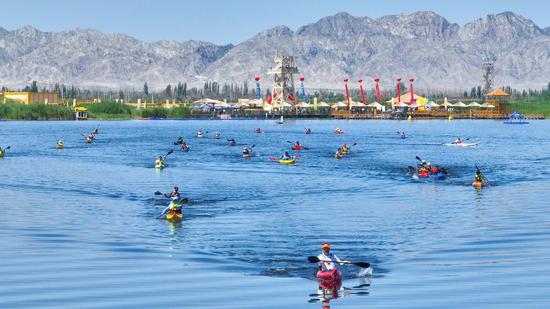
China Kayak Marathon Open held at Bosten Lake in Xinjiang
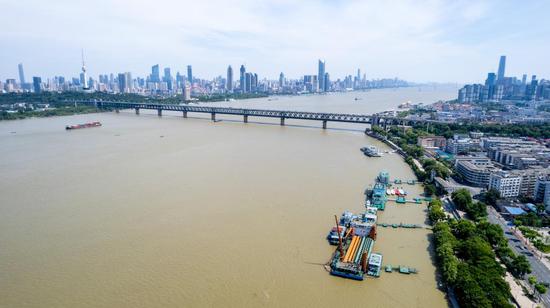
Water level at Hankou Station on Yangtze River drops below warning level

Equestrian events of China's 12th Ethnic Games kicks off
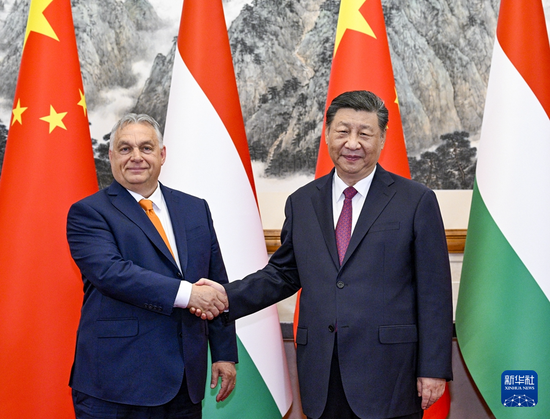
Xi meets with Hungary's Prime Minister Viktor Orban
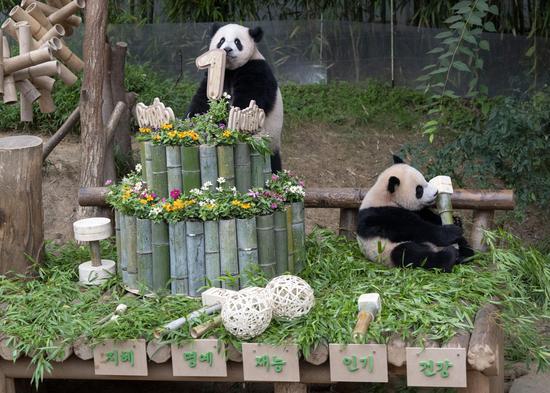
Beloved giant panda twin cubs in South Korea celebrate first birthday
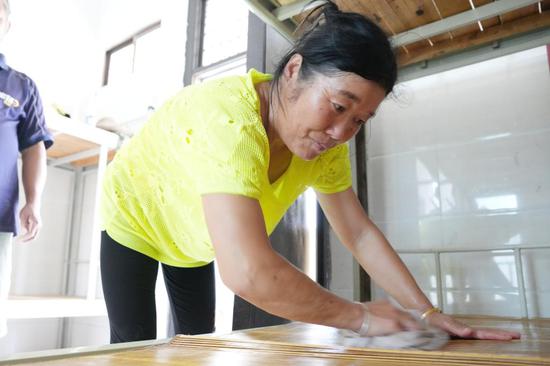
Residents relocated after Dongting Lake dike breach
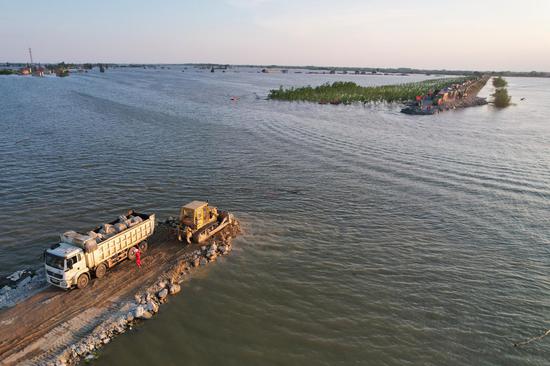
Dike breach in Central China expected to be closed on Tuesday
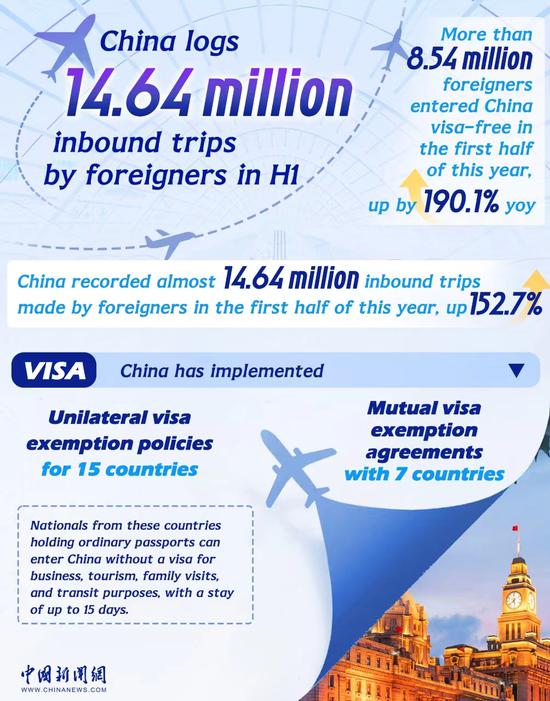
In Numbers: China logs 14.64 million inbound trips by foreigners in H1
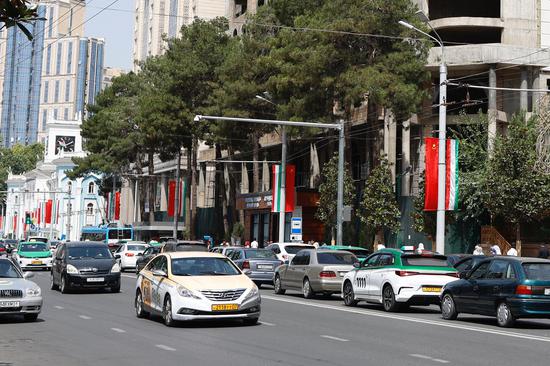
Flags of China, Tajikistan flutter in Dushanbe for Xi's visit

China's modified Long March rocket sends satellite group into space
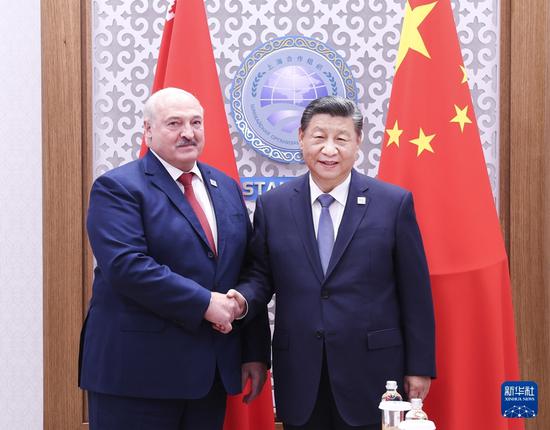
Xi meets with Belarusian President Alexander Lukashenko
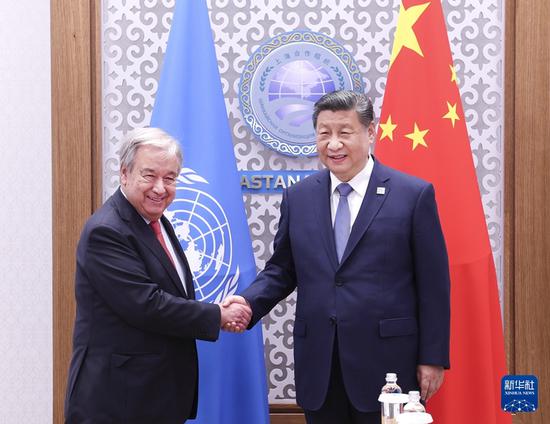
Xi meets with UN Secretary-General Antonio Guterres
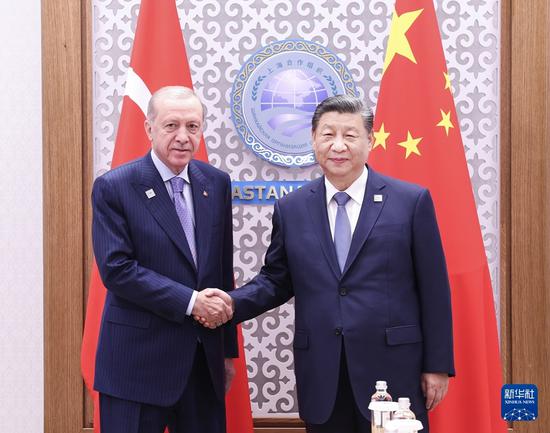
Xi meets with Turkish President Recep Tayyip Erdogan
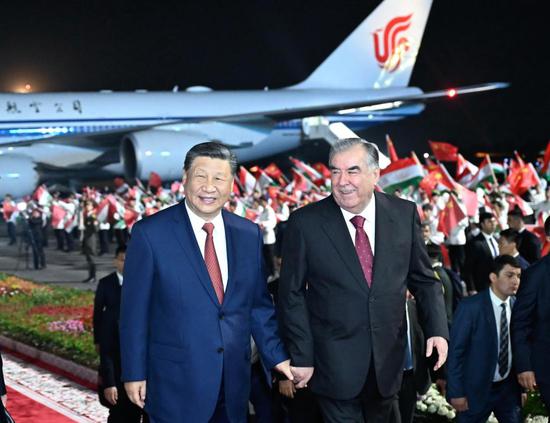
Xi kicks off state visit to Tajikistan
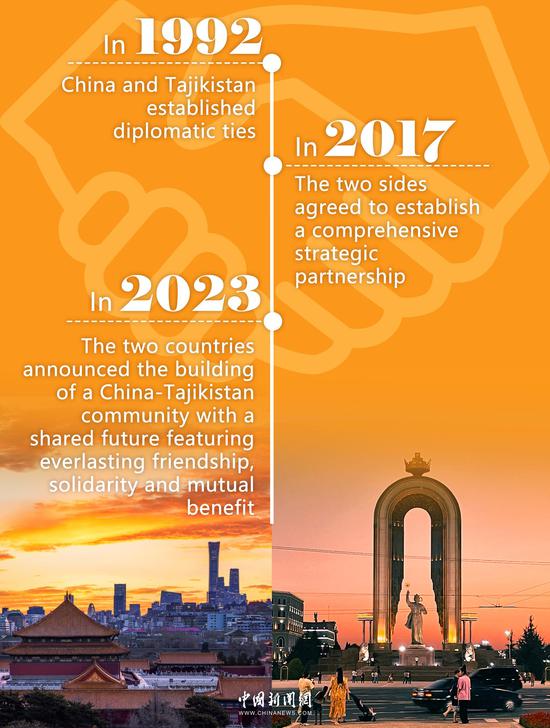
Bilateral relations between China and Tajikistan in numbers
Most popular in 24h, more top news.
- China's first real value transaction through m-CBDC Bridge completes in S China
- China's stable economic performance unchanged: NBS spokesperson
- China's employment rate generally stable
- China's rail freight volume, turnover top world rankings
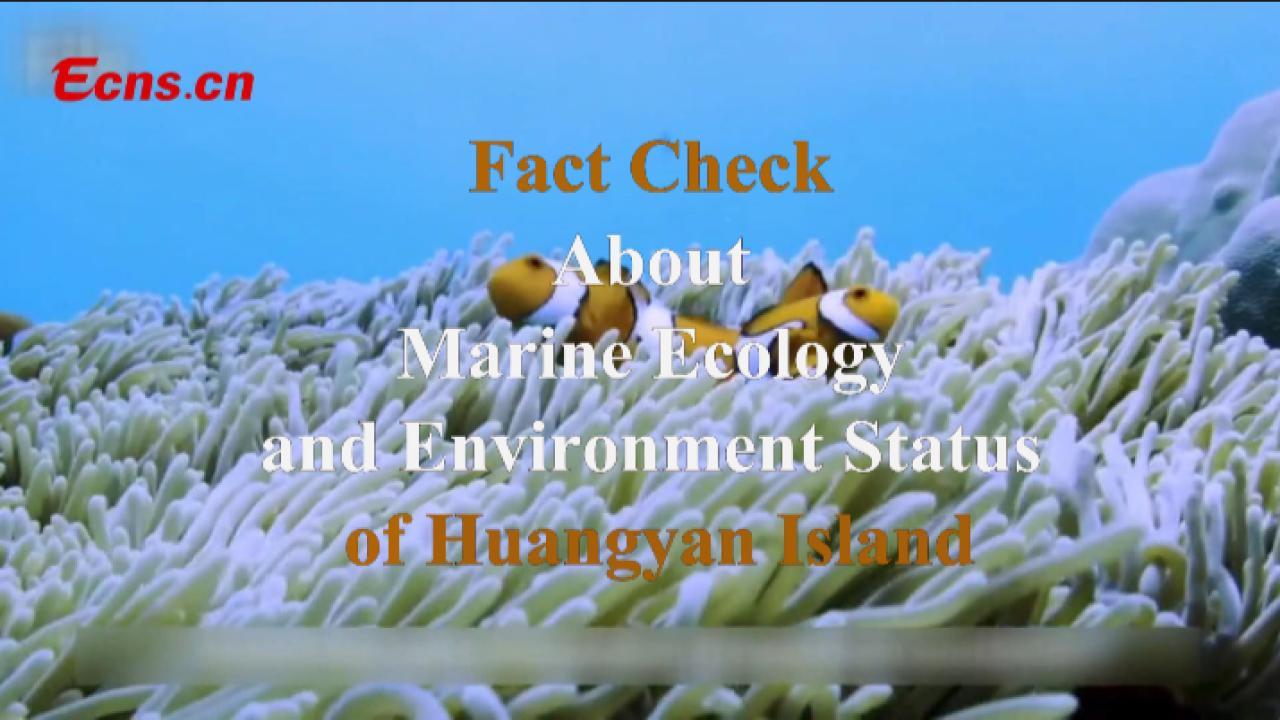
Fact check: Ecosystem of Huangyan Island excellent

What China accomplishes is unprecedented in world history: U.S. expert


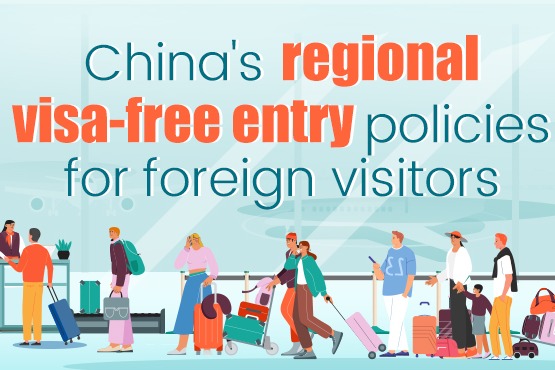
IMAGES
COMMENTS
Inner Mongolia lies in central North China. Its geographical position has granted Inner Mongolia a richness of travel destinations that attract a large number of visitors to see its spectacular natural scenery of grasslands, deserts, lakes, and forests, the rich legacy of Genghis Khan and the Mongol Empire, and the ethnic culture of nomadic herders. ...
The total precipitation in Inner Mongolia is much less than in the eastern coastal areas of China, around 200~300 mm and most rainfall is concentrated in summer. Spring in Inner Mongolia is dry and windy, sandstorms and other extreme weather might occur. Check the real-time weather forecast before your travel.
Climate in Inner Mongolia is very different during the year. Winter is cold and can be very long, with frequent blizzards. Usually summer is short and warm. The climate changes from arid to semi-humid from west to east, and to humid in the northeast. The annual rainfall is 80 - 450 millimeters, also increasing from west to east.
Mongolia: Behind the scenes of our Best in Travel Video. Oct 30, 2023 • 3 min read. Mongolia has so much to offer travelers looking for wide open spaces, adventure and culture. Here's what it is like to travel there. Beaches. Explore Inner Mongolia holidays and discover the best time and places to visit.
25. Parks. Eerguna, China. Dolon-nuur Lake. 9. Bodies of Water. Duolun County, China. Inner Mongolia Tourism: Tripadvisor has 21,553 reviews of Inner Mongolia Hotels, Attractions, and Restaurants making it your best Inner Mongolia resource.
Recommended Inner Mongolia Tours: 4-Day Authentic Mongolian Nomad Experience Tour. 6-Day Inner Mongolia Wild Heartlands. 2. Enjoy Diamond-Like Lakes: Hulun and Buir. Hulunbuir was named after two lakes: Hulun and Buir. The lakes are teeming with fish and shrimp, and wildflowers are everywhere in the spring/summer. 3.
See way to experience (1) 10. Hohhot Five-Pagoda Temple (Wuta Si) 72. Religious Sites. This pagoda is quite unique in Mongolia. The style is from Indian Buddhism. Although it is called the "1000-Buddha Pagoda", there are actually some 1563 carvings of Buddha on its exterior walls. Inside….
Our carefully curated Inner Mongolia travel itineraries, ranging from 2 to 9 days, are the result of our team's extensive experience in the region.These itineraries encompass a wide range of attractions, including the highlights of Hohhot, the boundless grasslands, immersive nomadic experiences, invigorating mountain hikes, expansive deserts, pristine forests, and captivating wetland parks.
This ultimate Inner Mongolia Travel Guide is to help you plan your perfect trip to Inner Mongolia, with all essential information and travel tips covered. The expansive grasslands are the undoubted stars in the region. The Badain Jaran Desert with some of the world's tallest dunes and hidden lakes will wow all its travelers. The Mausoleum of ...
Dà Zhào. Inner Mongolia. This spectacular Tibetan Buddhist temple is the oldest and largest temple in the city. Also called 'Immeasurable Temple' (无量寺, Wúliàng Sì) in Chinese, the…
Let's check the detailed top 12 Inner Mongolia Destinations to go to plan your coming Inner Mongolia tour 2024/2025 !! Quick Jump to: Top 1: Hohhot. Top 2: Hulunbuir. Top 3: Badain Jaran. Top 4: Ordos. Top 5: Ulanqab. Top 6: Baotou.
By train: A train from Beijing to Hohhot takes between 6 ½ and 11 hours and costs about 150 Yuan for a hard sleeper. Click here to read our complete guide for traveling in China by train. By bus: The long-distance bus from Beijing Liuliqiao Station (A1, Liuliqiao Nan Li, Fengtai District) to Hohhot takes 8 hours and costs 150 Yuan.
Travel within Inner Mongolia. The most convenient way to travel between cities in Inner Mongolia is by bus, however, all timetables or bus signs are displayed in Chinese only, so it can be tricky for travelers who can't read Chinese. For travelers who want to get to the main attractions in the city of Hohhot and Baotou, a combination of train ...
Inner Mongolia (内蒙古, Nèi Měnggǔ or in Mongolian, Öbür mongɣul) is a Mongol Autonomous Region in northern China, whereas Outer Mongolia is a separate country to the north of China. The region covers most of the northern edge of China, curving in a banana shape. To the north is the Republic of Mongolia and the north east tip of Inner Mongolia borders with Russia.
Hohhot is in the middle of the Inner Mongolian Autonomous Region and has served as its capital since 1954. It is also a transportation hub of Northern China, with easy access to Beijing, Tianjin, and Datong, and as well as Mongolia. Chinese Name: 呼和浩特. Chinese Pinyin: Hūhéhàotè.
Inner Mongolia Travel Tips lists the top 9 Inner Mongolia FAQs like when is the best time, local customs & taboos, clothing & packing list, shopping tips, etc. for you Inner Mongolia tour 2024! Tailor-made Tour Package Refundable Quick Response 3,820+ comments (1,930+ reviews)
Travel Itinerary: Plan your itinerary to include a mix of urban and rural experiences, cultural encounters, and outdoor activities to get a well-rounded experience of Inner Mongolia. By respecting the local culture, preparing for the weather, and embracing the unique opportunities Inner Mongolia offers, you can have a memorable and enriching ...
Mongolia's travel season is fleeting, stretching from late May to late August, so the best drivers, guides and vehicles are soon snaffled up. In the past, it was possible to rock up to Ulaanbaatar in summer and ask around at guesthouses to find space on a tour, but with the suspension of the Trans-Mongolian Railway, fewer travelers are ...
Inner Mongolia, located in the northern part of China, is a narrow-long province bordered with Mongolia and Russia in its northern direction. Capital of Inner Mongolia is Hohhot while major cities are Ordos, Baotou and Chifeng. With an area about 1.2 million square kilometers, Inner Mongolia is the third largest province in China following ...
Inner Mongolia, officially the Inner Mongolia Autonomous Region, is an ... Inner Mongolia travel guide from Wikivoyage This page was last edited on 14 July 2024, at 13:42 (UTC). Text is available under the Creative Commons Attribution-ShareAlike License 4.0 ...
Located in the northeast of Inner Mongolia, Hulunbuir Grassland is one of the top famous grasslands in the world with natural grassland coverage of about 80%. Its lush plants, unpolluted air, flocks and herds, unique ethnic culture, and Genghis Khan history fascinate and attract people for a visit.. Scroll down to find key travel info and things to do on Hulunbuir Grassland, or contact our ...
Inner Mongolia Travel Guide. Inner Mongolia is a state/province in China. Home to cities such as Hohhot, Erenhot, and Baotou, there's no shortage of things to do and see here. Show Less. Inner Mongolia Travel Guide.
Adjacent to Gansu, Qinghai, Ningxia, Shanxi, etc. Inner Mongolia is often planned in a 5-8 days tour to the Silk Road (Dunhuang, Zhangye, Lanzhou, Jiayuguan, etc.), Xining, etc. And people interested in the Chinese ancient history and grassland view prefer a 5-7 days trip to Beijing and Inner Mongolia.
Inner Mongolia is an important hub of the China-Mongolia-Russia Economic Corridor, and also a crucial gateway for the New International Land-Sea Trade Corridor in the western region.
Diplomats from 32 countries pose for a group photo with Inner Mongolia officials. [Photo/Inner Mongolia Daily] Diplomats from 32 countries in Africa, Asia, Europe, North America, South America and ...
Aerial view: Danxia Landform stretching like tree branches in Inner Mongolia; Bilateral relations between China and Bangladesh in numbers; East China city greets Nishan Forum with series of activities